VIS 21B Chinese Art ID's
1/151
There's no tags or description
Looks like no tags are added yet.
Name | Mastery | Learn | Test | Matching | Spaced |
|---|
No study sessions yet.
152 Terms
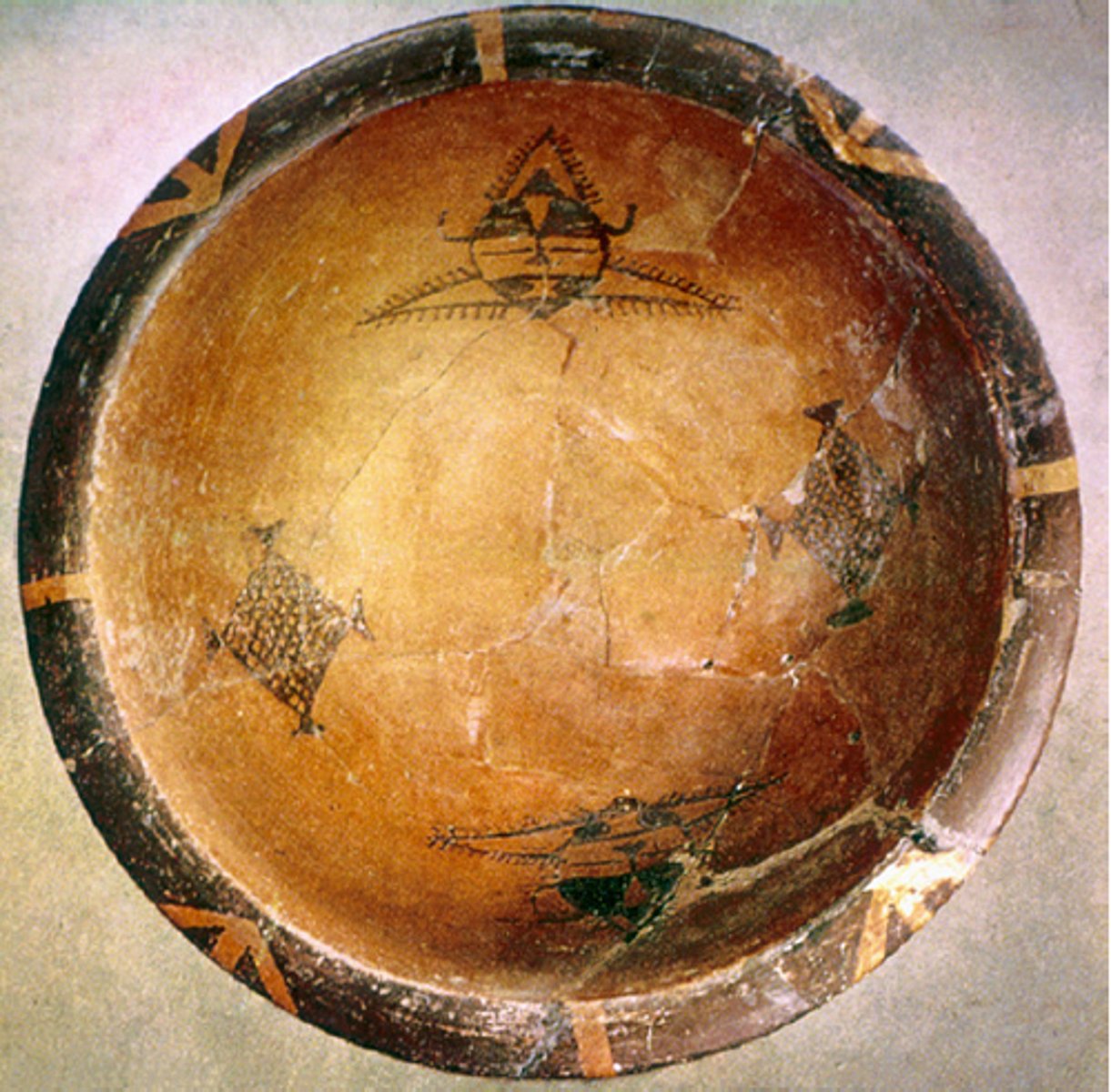
Title: Bowl Painted with Human Face and Fish
Material: Painted Pottery (clay, red & black paint)
Period: Early Yangshao Culture; Neolithic Period (c. 4000 BC)
thicker, heavier pottery made through coiling method instead of on wheel

Title: Bowl Painted with Human Face and Fish
Material: Painted Pottery (clay, red & black paint)
Period: Early Yangshao Culture; Neolithic Period (c. 4000 BC)
depiction of fish indicates fishing culture for people along the river
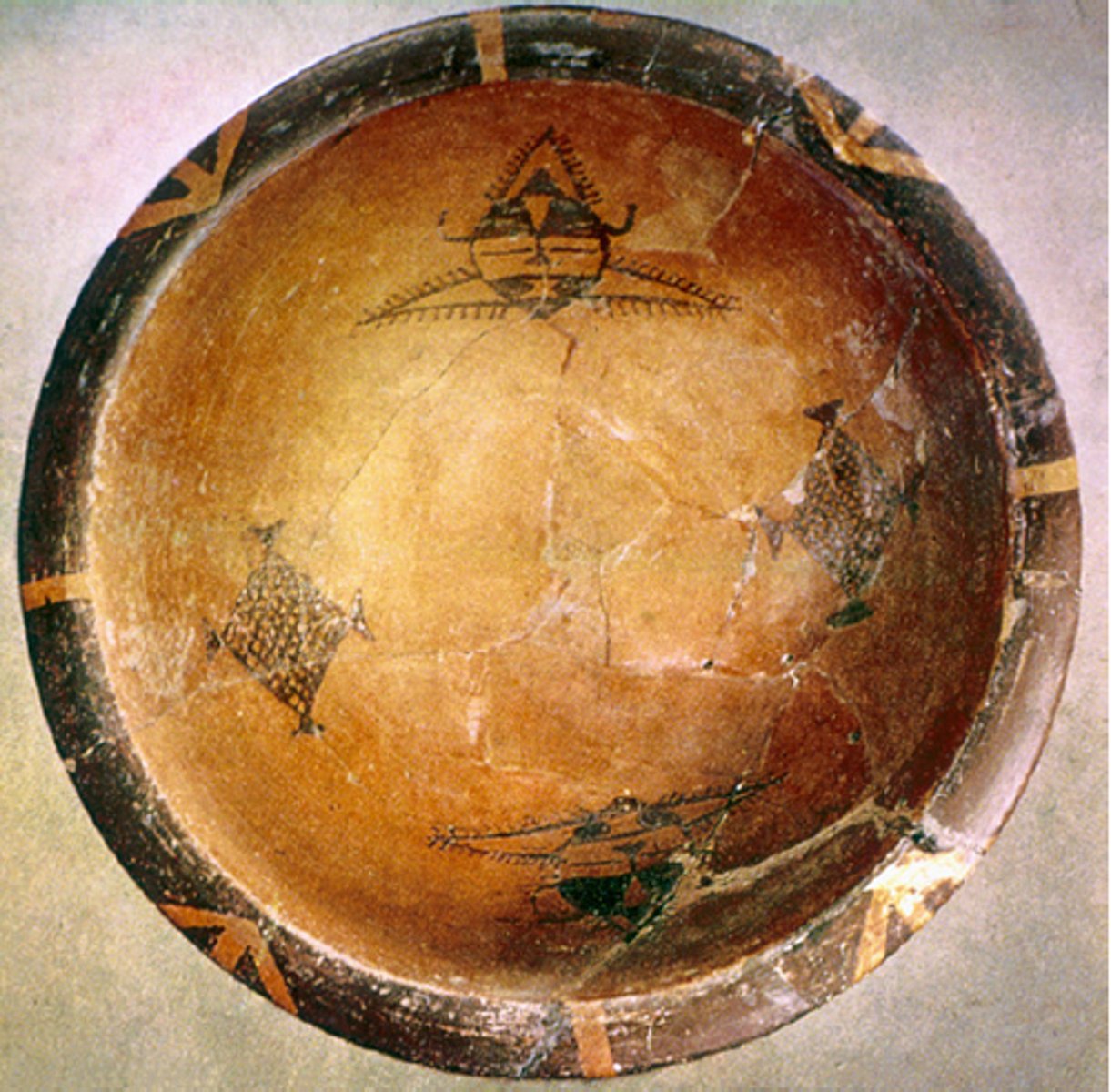
Title: Bowl Painted with Human Face and Fish
Material: Painted Pottery (clay, red & black paint)
Period: Early Yangshao Culture; Neolithic Period (c. 4000 BC)
masked human image shows early Chinese shamanist beliefs

Title: Bowl Painted with Human Face and Fish
Material: Painted Pottery (clay, red & black paint)
Period: Early Yangshao Culture; Neolithic Period (c. 4000 BC)
contained wine, rice, water, food
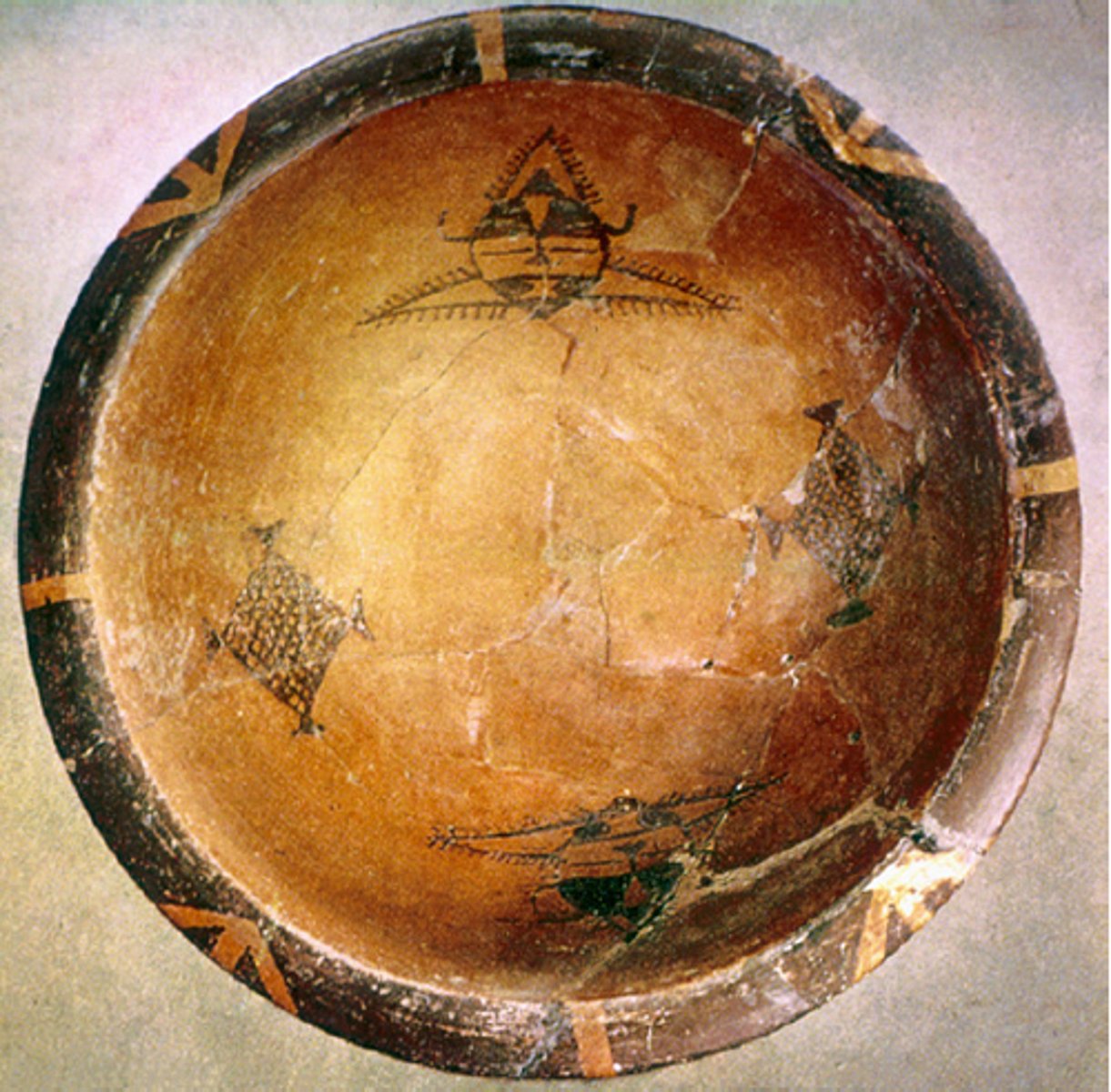
Title: Bowl Painted with Human Face and Fish
Material: Painted Pottery (clay, red & black paint)
Period: Early Yangshao Culture; Neolithic Period (c. 4000 BC)
There is a flat bottom to make is easier to put the bowl on the ground/stove

Title: Bowl Painted with Human Face and Fish
Material: Painted Pottery (clay, red & black paint)
Period: Early Yangshao Culture; Neolithic Period (c. 4000 BC)
- Naturalistic motifs are geometrically rendered, combined with geometric motifs, or both
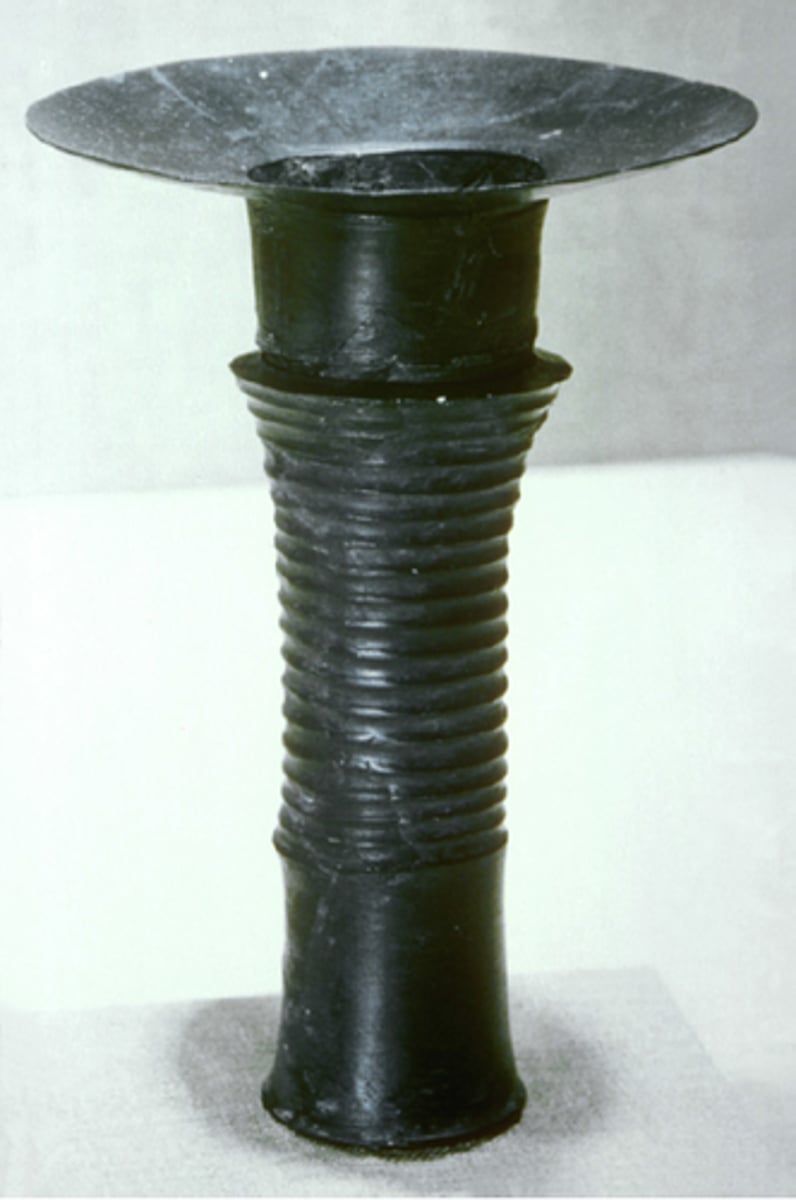
Title: Gu Beaker
Material: Black Pottery
Period: Longshan Culture; Neolithic Period (c. 2000 BC)
made on turntable with cutting tools, then fired; result has thinner walls than Yangshao style

Title: Gu Beaker
Material: Black Pottery
Period: Longshan Culture; Neolithic Period (c. 2000 BC)
one of the first uses of the pottery wheel
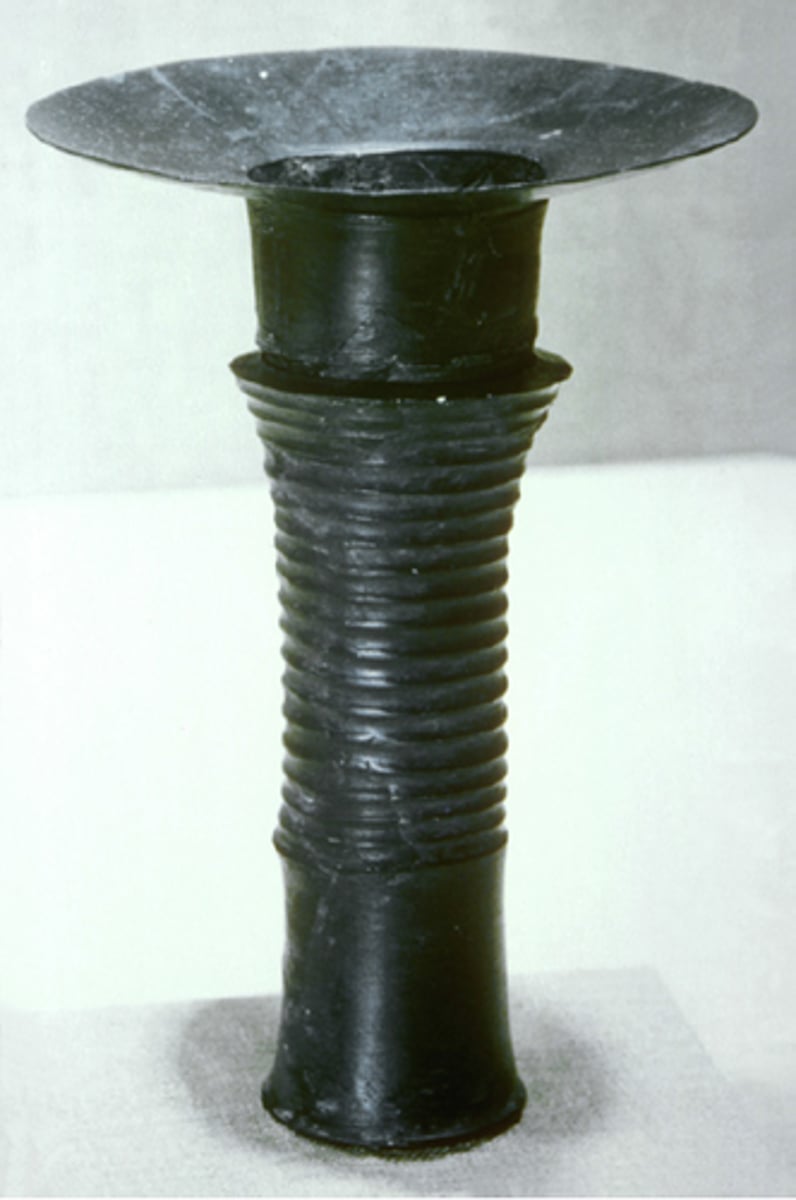
Title: Gu Beaker
Material: Black Pottery
Period: Longshan Culture; Neolithic Period (c. 2000 BC)
- Very little decoration, embellishment restricted to ridges, openwork, and ocassional bosses

Title: Prismatic Tube (Cong)
Material: Nephrite Jade
Period: Liangzhu Culture; Neolithic Period
symbolic representations of Chinese cosmological beliefs
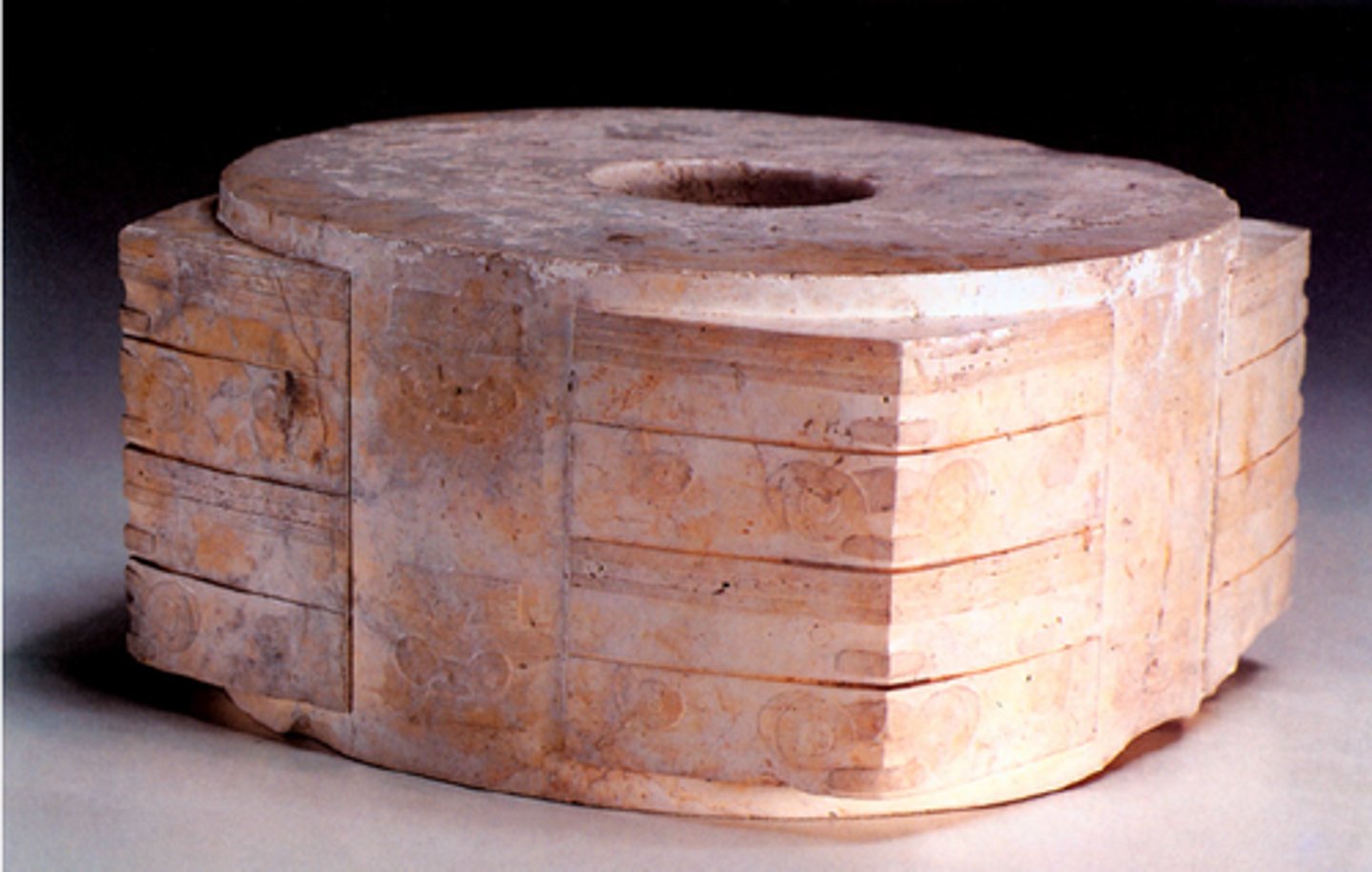
Title: Prismatic Tube (Cong)
Material: Nephrite Jade
Period: Liangzhu Culture; Neolithic Period
square - earth
circle - heavens
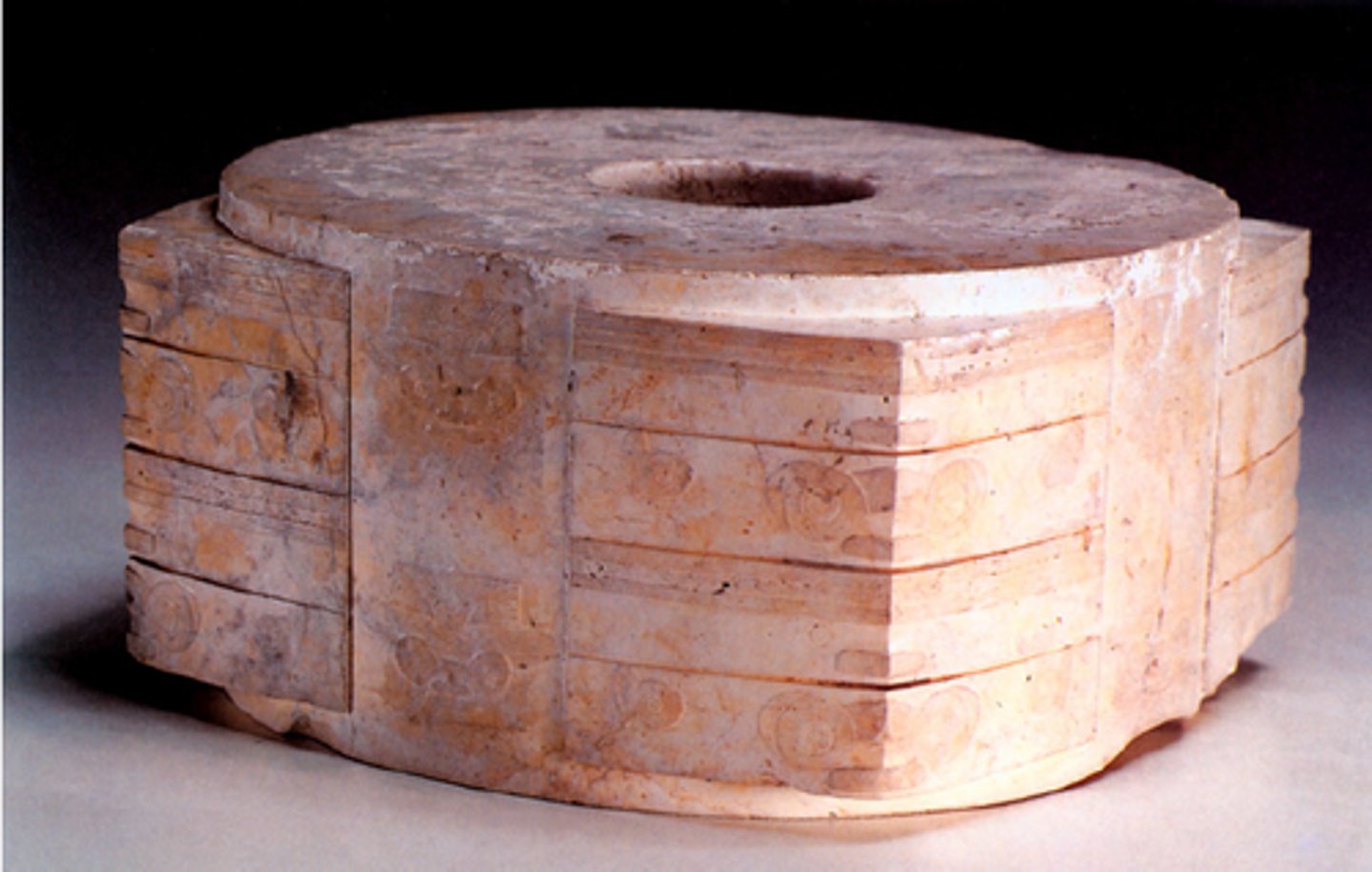
Title: Prismatic Tube (Cong)
Material: Nephrite Jade
Period: Liangzhu Culture; Neolithic Period
taotie mask carvings along with other patterns and motifs
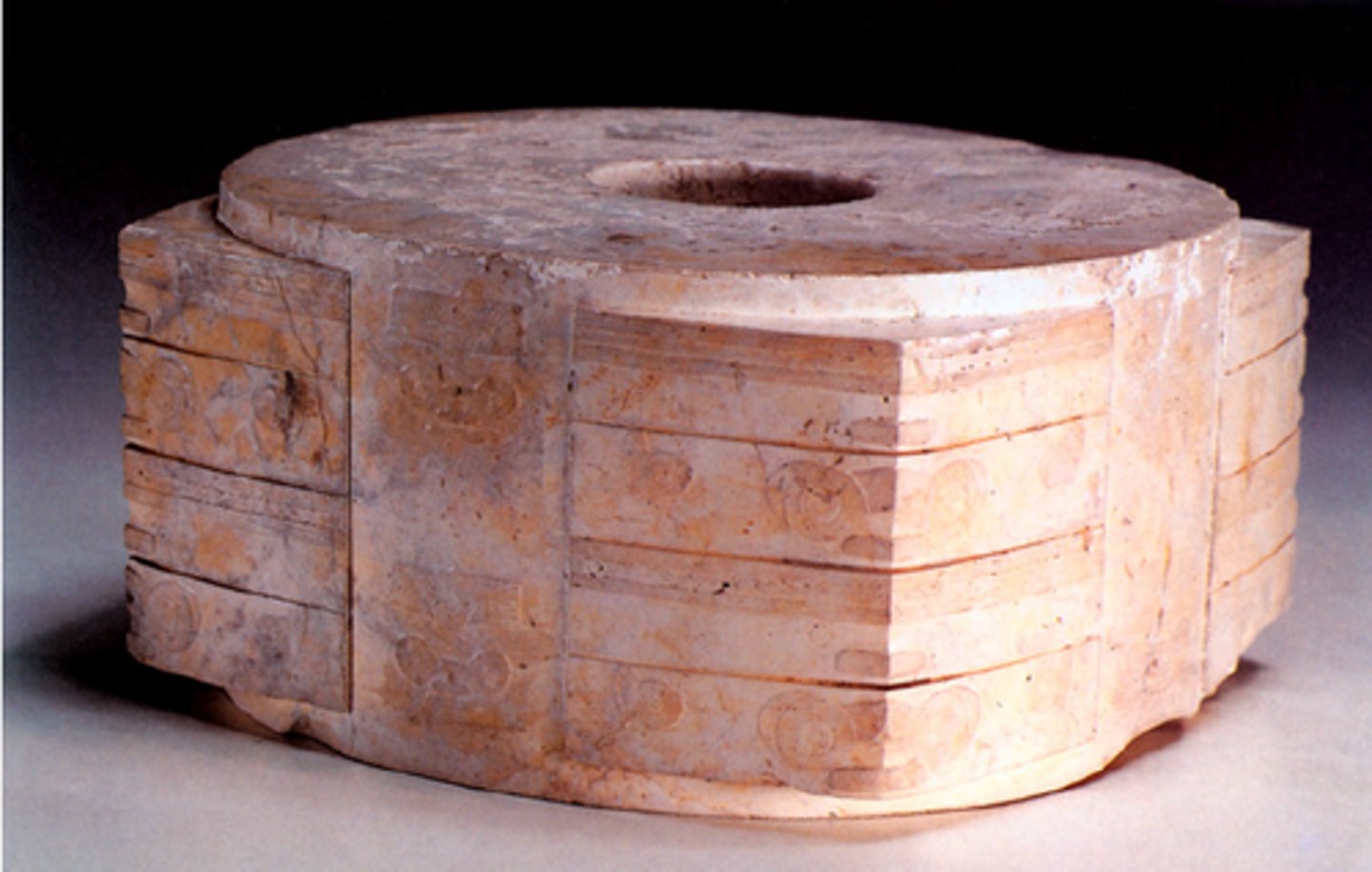
Title: Prismatic Tube (Cong)
Material: Nephrite Jade
Period: Liangzhu Culture; Neolithic Period
- Embellished with engraved spirals and circles, defining eye, nose, and mouth "masks"
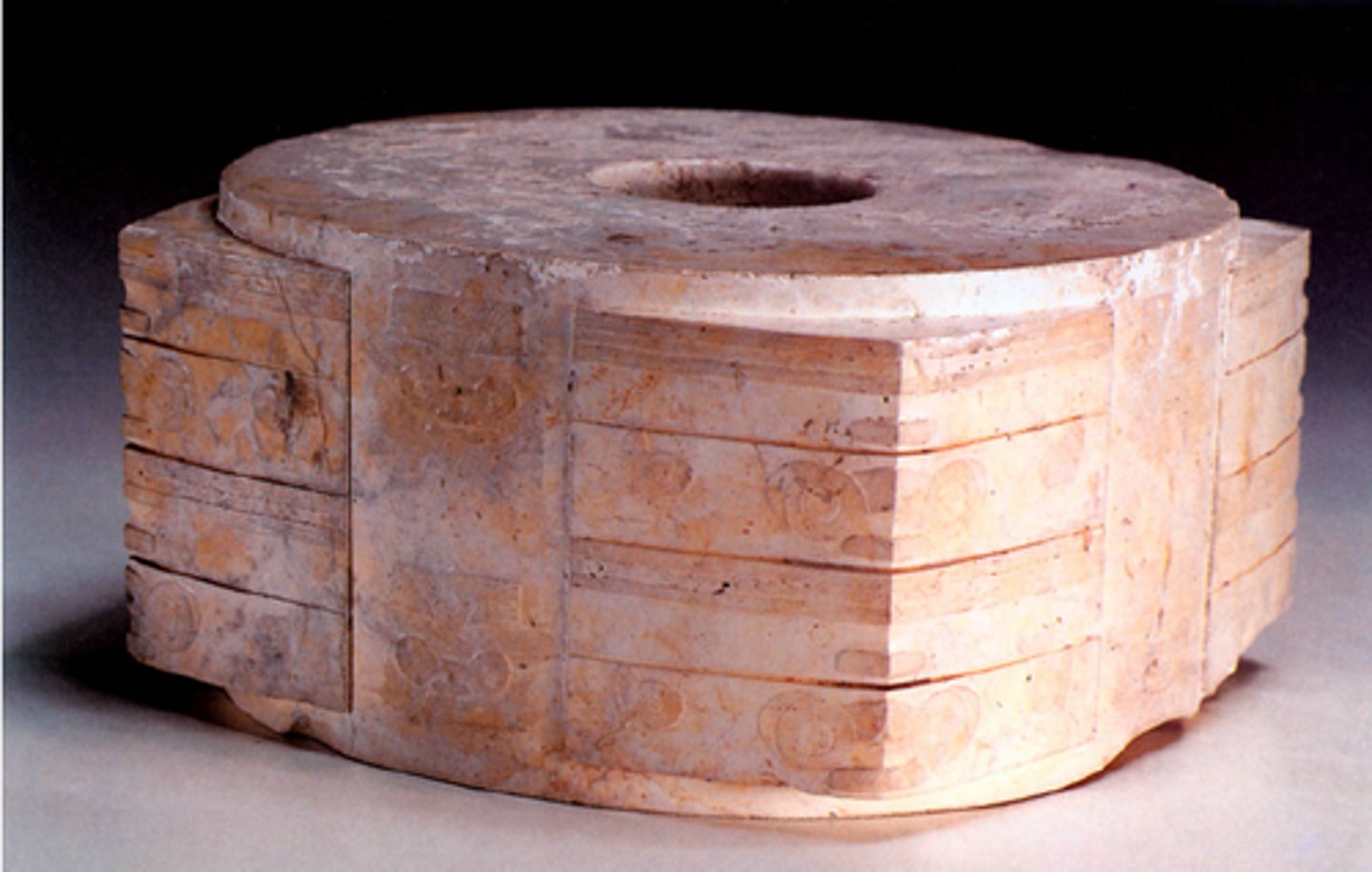
Title: Prismatic Tube (Cong)
Material: Nephrite Jade
Period: Liangzhu Culture; Neolithic Period
This is a time-consuming project because it is made of hard stone and it is difficult to carve.
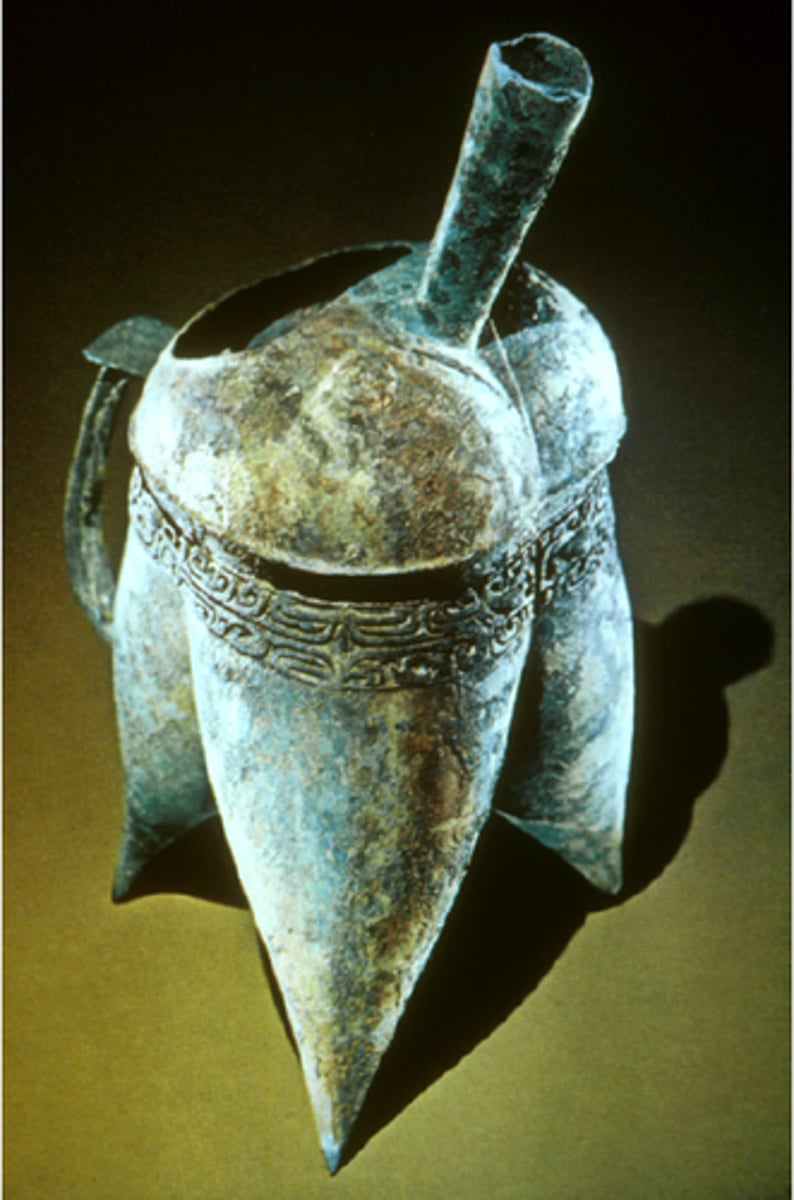
Title: Li He (Ritual Wine Vessel)
Material: Bronze
Period: Zhengzhou Phase, Early Shang Period
Max Loehr's Style I - single decorative band

Title: Li He (Ritual Wine Vessel)
Material: Bronze
Period: Zhengzhou Phase, Early Shang Period
characteristic thin walled vessel

Title: Li He (Ritual Wine Vessel)
Material: Bronze
Period: Zhengzhou Phase, Early Shang Period
large, tapering hollow legs
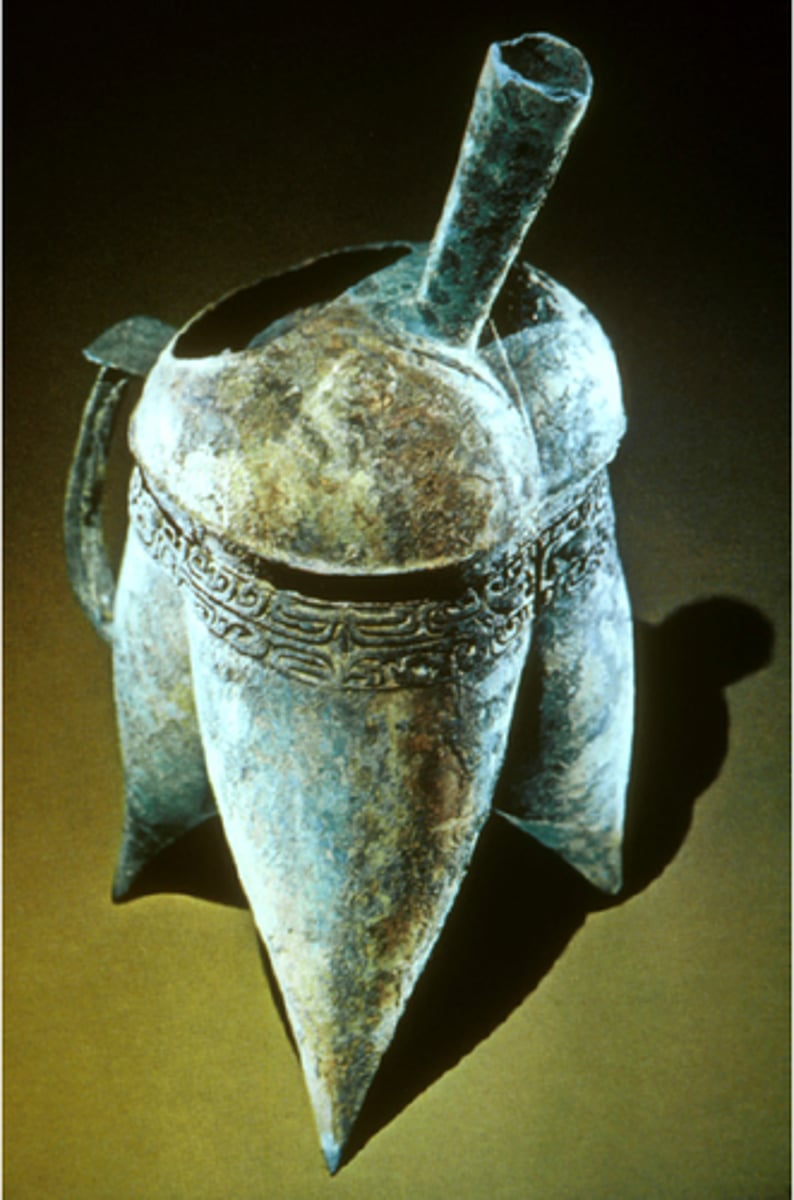
Title: Li He (Ritual Wine Vessel)
Material: Bronze
Period: Zhengzhou Phase, Early Shang Period
decorations carved into ceramic piece-molds used to make the bronze vessel
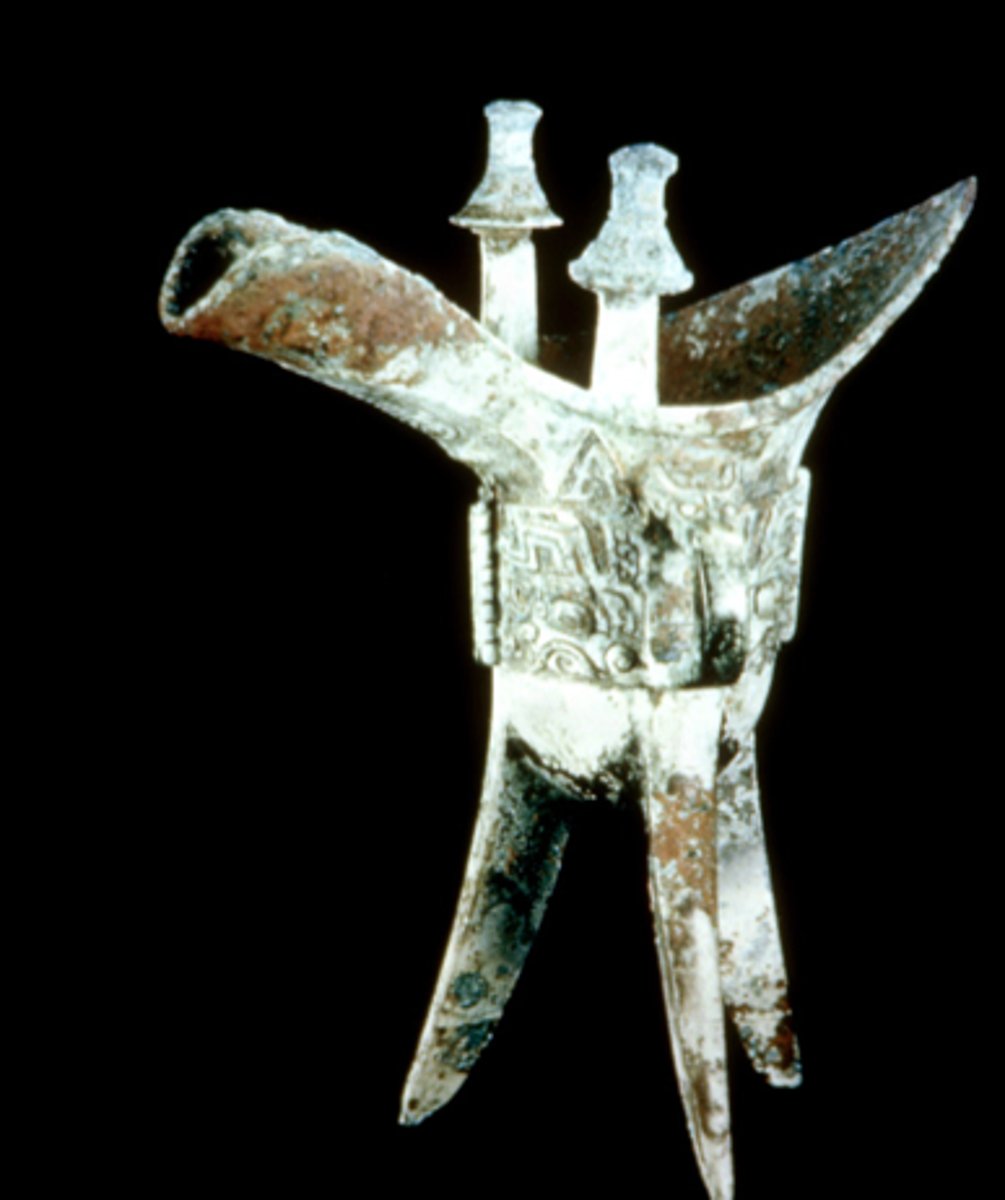
Title: Jue (Ritual Wine Vessel)
Material: Bronze
Period: Zhengzhou Phase, Shang Period
Loehr's Style II
wider band of decorative engraving featuring taotie images and kui dragons
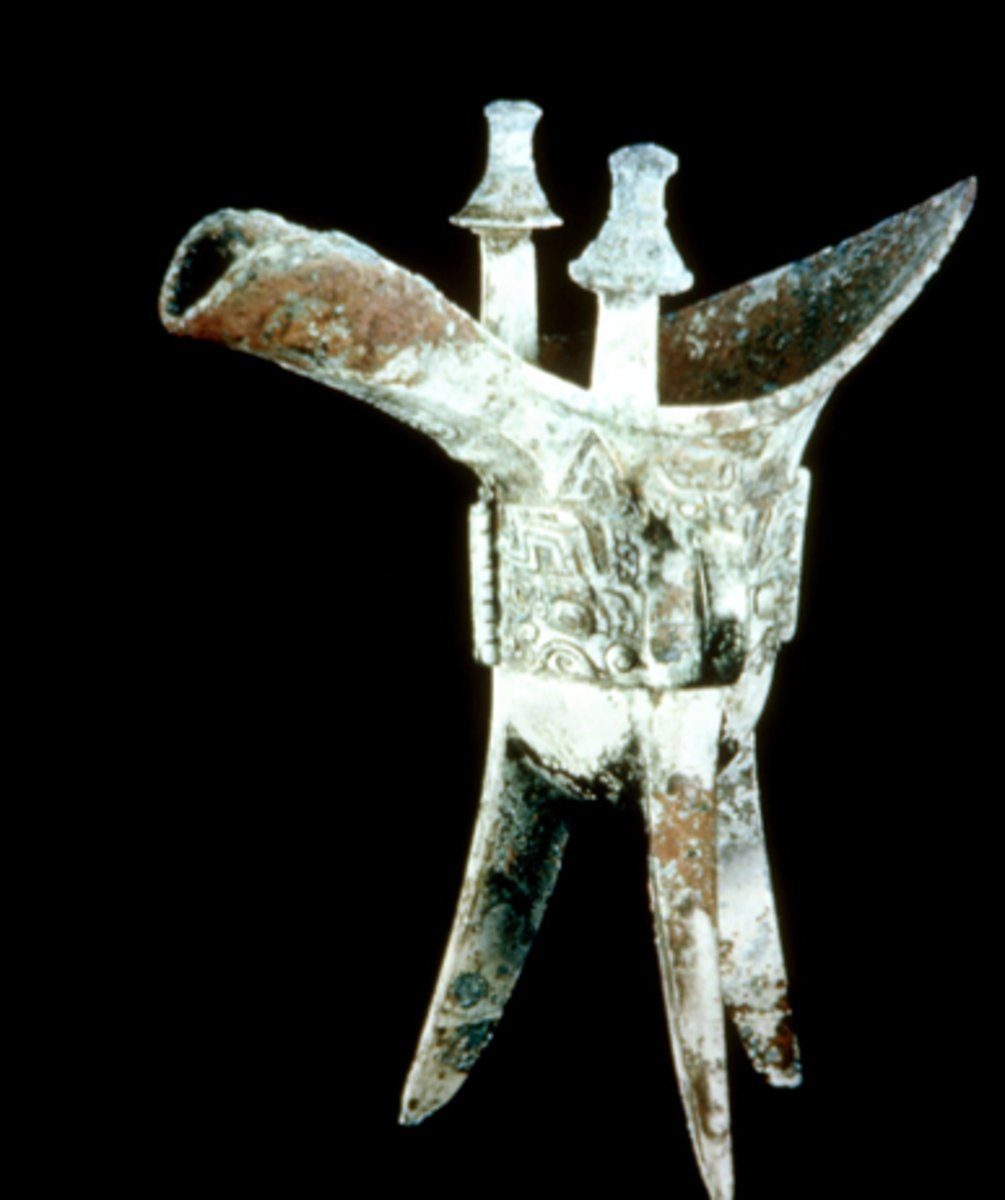
Title: Jue (Ritual Wine Vessel)
Material: Bronze
Period: Zhengzhou Phase, Shang Period
slightly thicker walls made with a more complex piece-mold
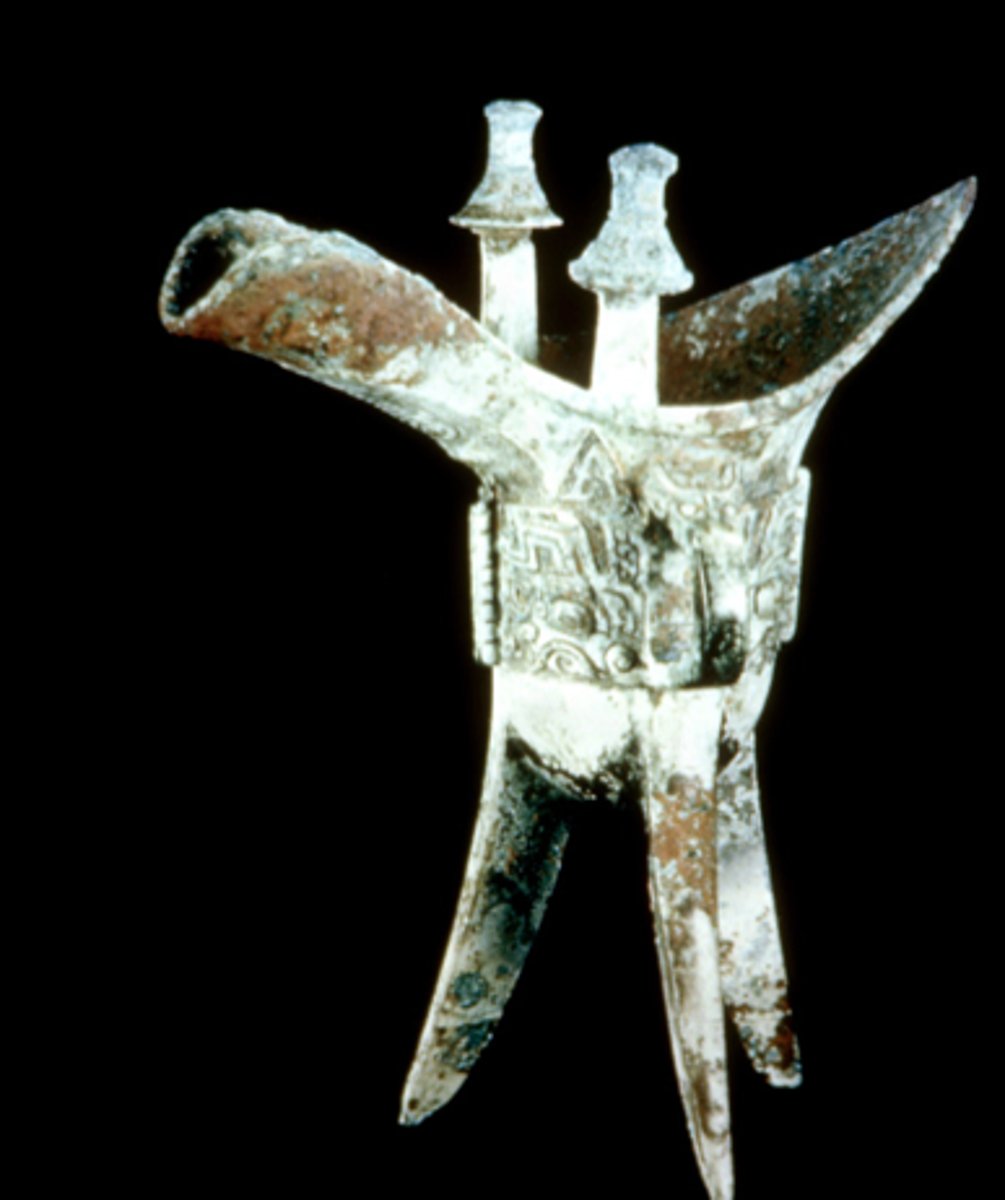
Title: Jue (Ritual Wine Vessel)
Material: Bronze
Period: Zhengzhou Phase, Shang Period
three-legged structure repeats
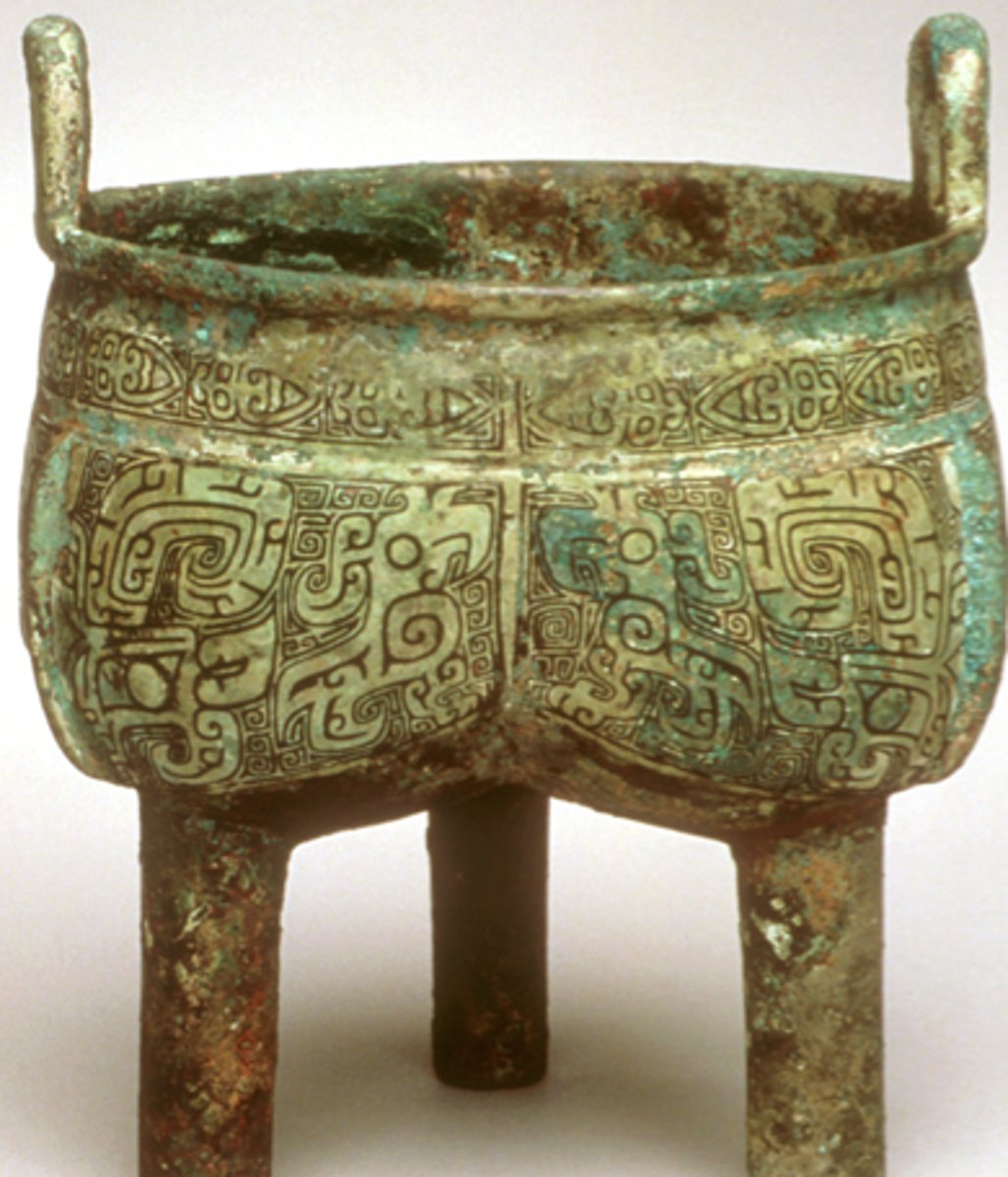
Title: Ding (Ritual Food Vessel)
Material: Bronze
Period: Anyang Phase, Late Shang Period
Loehr's style IV
Pattern on entire surface (no bands)
cut-in lines
clear foreground and background

Title: Ding (Ritual Food Vessel)
Material: Bronze
Period: Anyang Phase, Late Shang Period
dragon-like creatures and masks (?) make up decorations
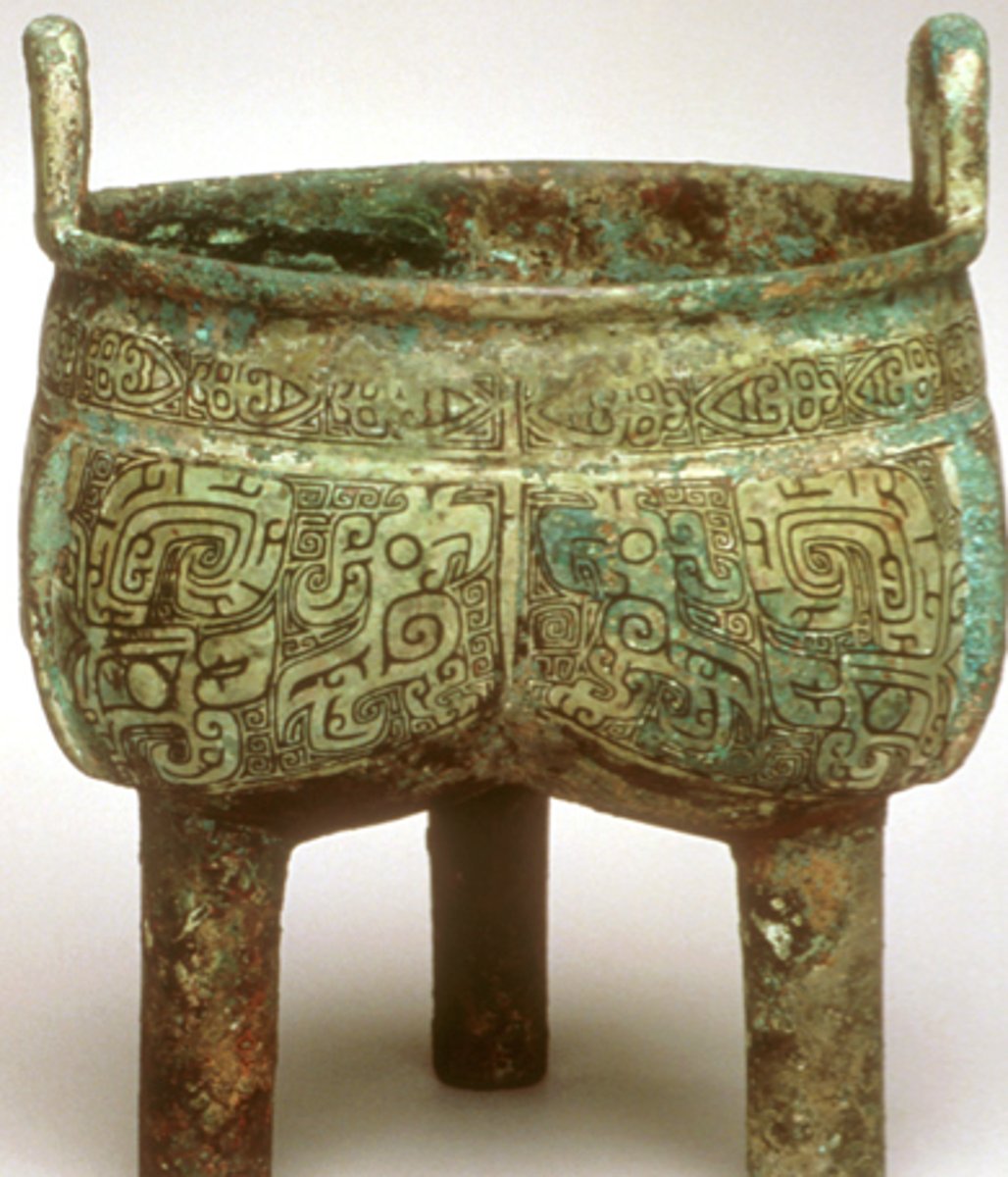
Title: Ding (Ritual Food Vessel)
Material: Bronze
Period: Anyang Phase, Late Shang Period
swirling/spiral patterns among the animal depictions create sense of motion (water/cloud pattern)
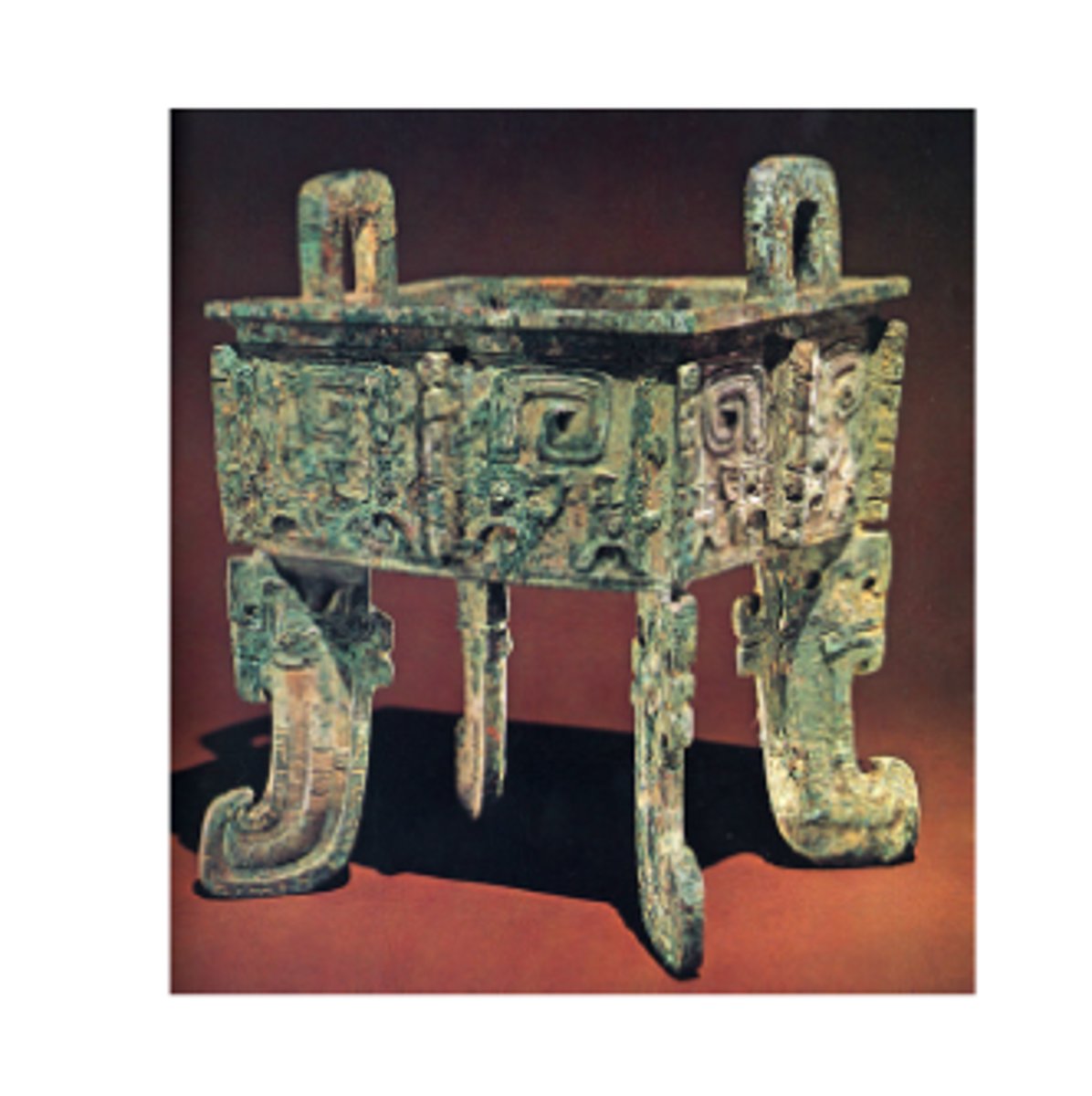
Title: Square Ding (Ritual Food Vessel), inscribed Fu Hao
Material: Bronze
Period: Anyang Phase, Late Shang Period
Loehr's Style V
Entire surface (3-D)
Geometric
Raised surface/deeper relief
clear foreground and background

Title: Square Ding (Ritual Food Vessel), inscribed Fu Hao
Material: Bronze
Period: Anyang Phase, Late Shang Period
high relief with lost-wax method; decorative parts extend out into space
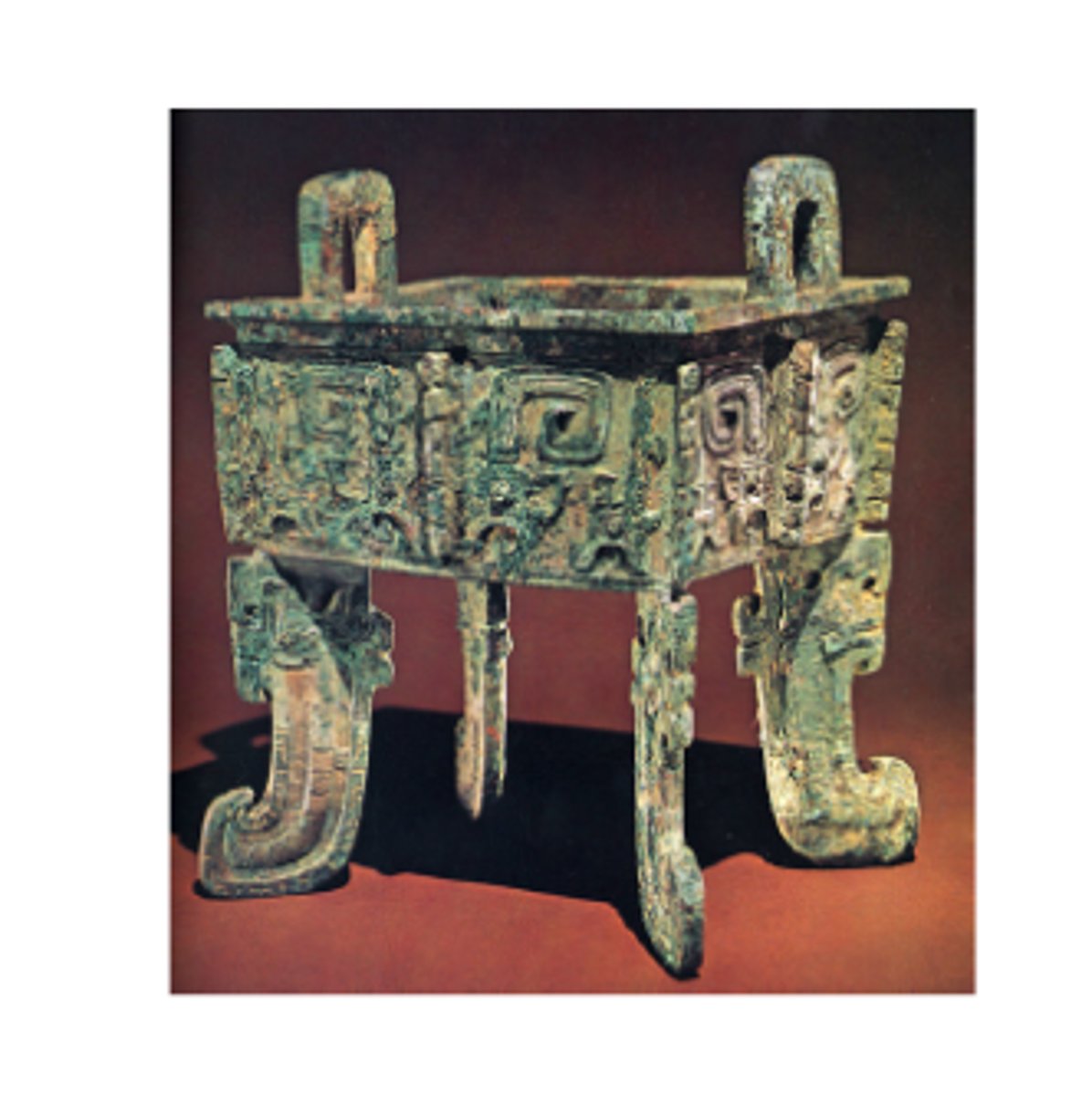
Title: Square Ding (Ritual Food Vessel), inscribed Fu Hao
Material: Bronze
Period: Anyang Phase, Late Shang Period
"taotie" mask pattern prevalent in Shang bronzes represents a greedy beast
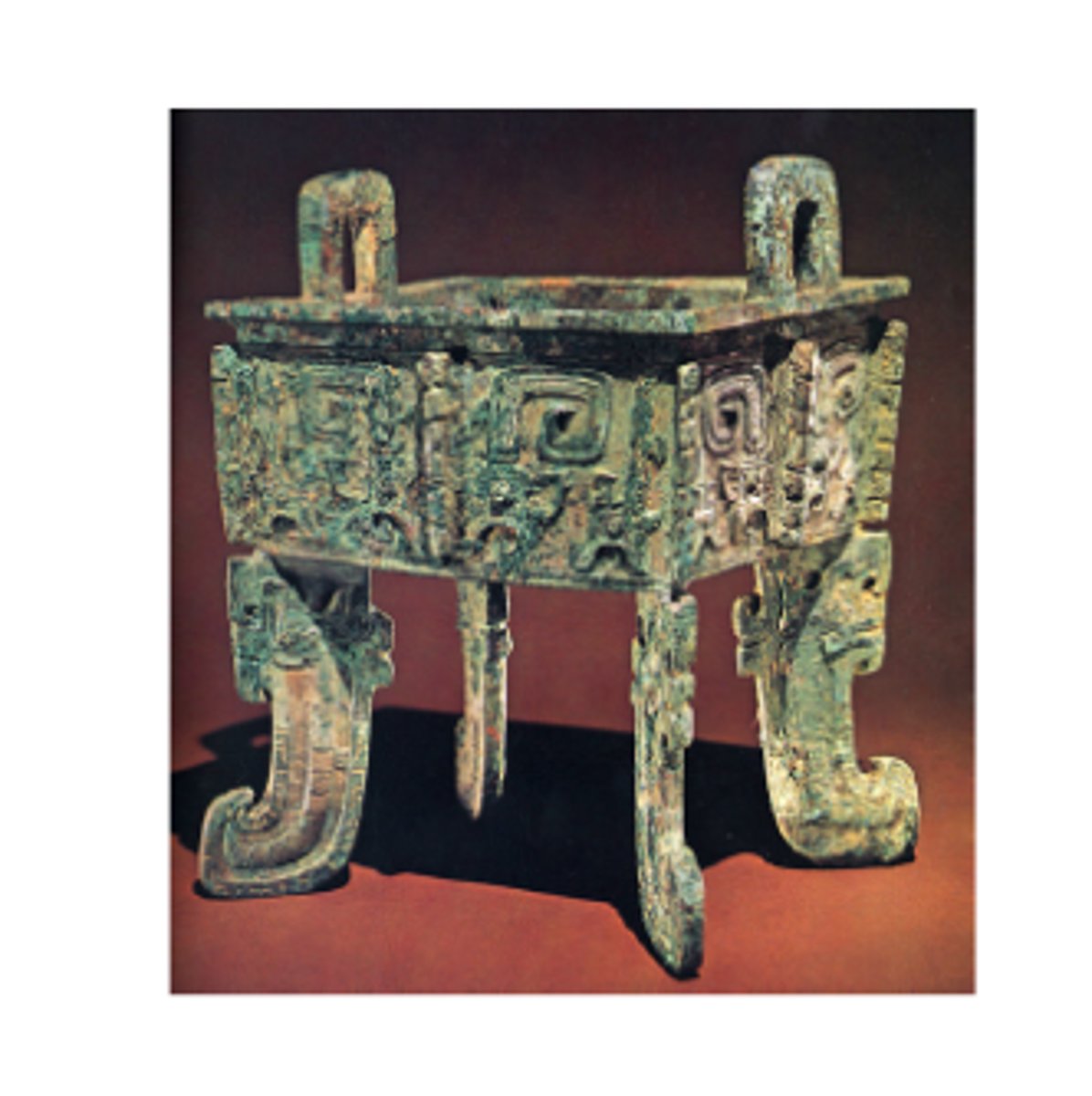
Title: Square Ding (Ritual Food Vessel), inscribed Fu Hao
Material: Bronze
Period: Anyang Phase, Late Shang Period
inside ding: carved characters[written language]
2 characters: top - women, bottom - good
owner of the vessel

Title: Square Ding (Ritual Food Vessel), inscribed Fu Hao
Material: Bronze
Period: Anyang Phase, Late Shang Period
not used for daily use, only for rituals (food/water)

Title: Mirror
Material: Bronze inlaid with gold and silver
Period: Eastern Zhou Period
bronze mirrors popular objects frequently found at tombs, particularly of women
- Kept as funerary pieces

Title: Mirror
Material: Bronze inlaid with gold and silver
Period: Eastern Zhou Period
points to use of make-up in early Chinese culture

Title: Mirror
Material: Bronze inlaid with gold and silver
Period: Eastern Zhou Period
inlaid technique allowed for complex patterns while maintaining a smooth surface
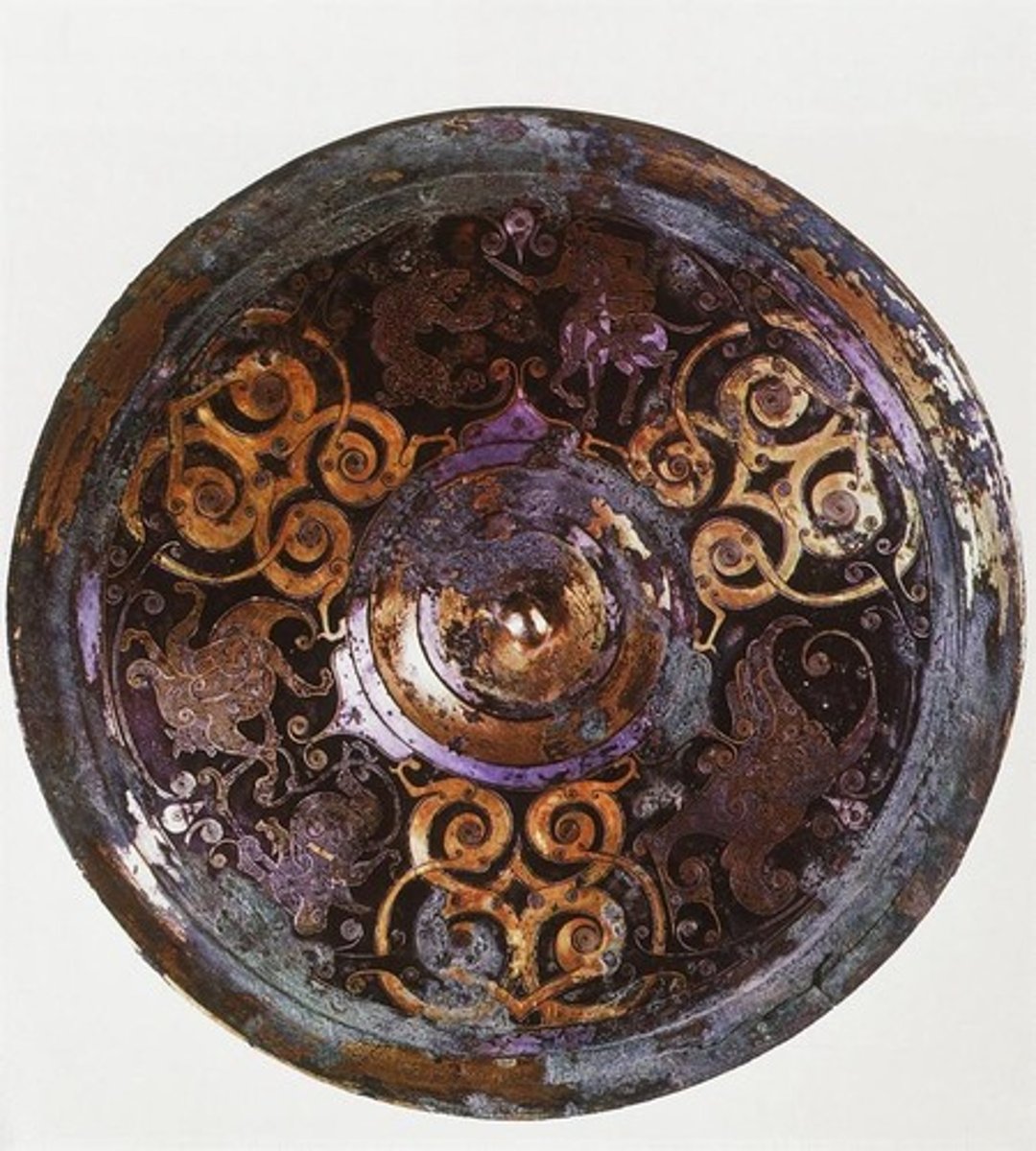
Title: Mirror
Material: Bronze inlaid with gold and silver
Period: Eastern Zhou Period
- Contains Eastern Zhou ribbon patterns
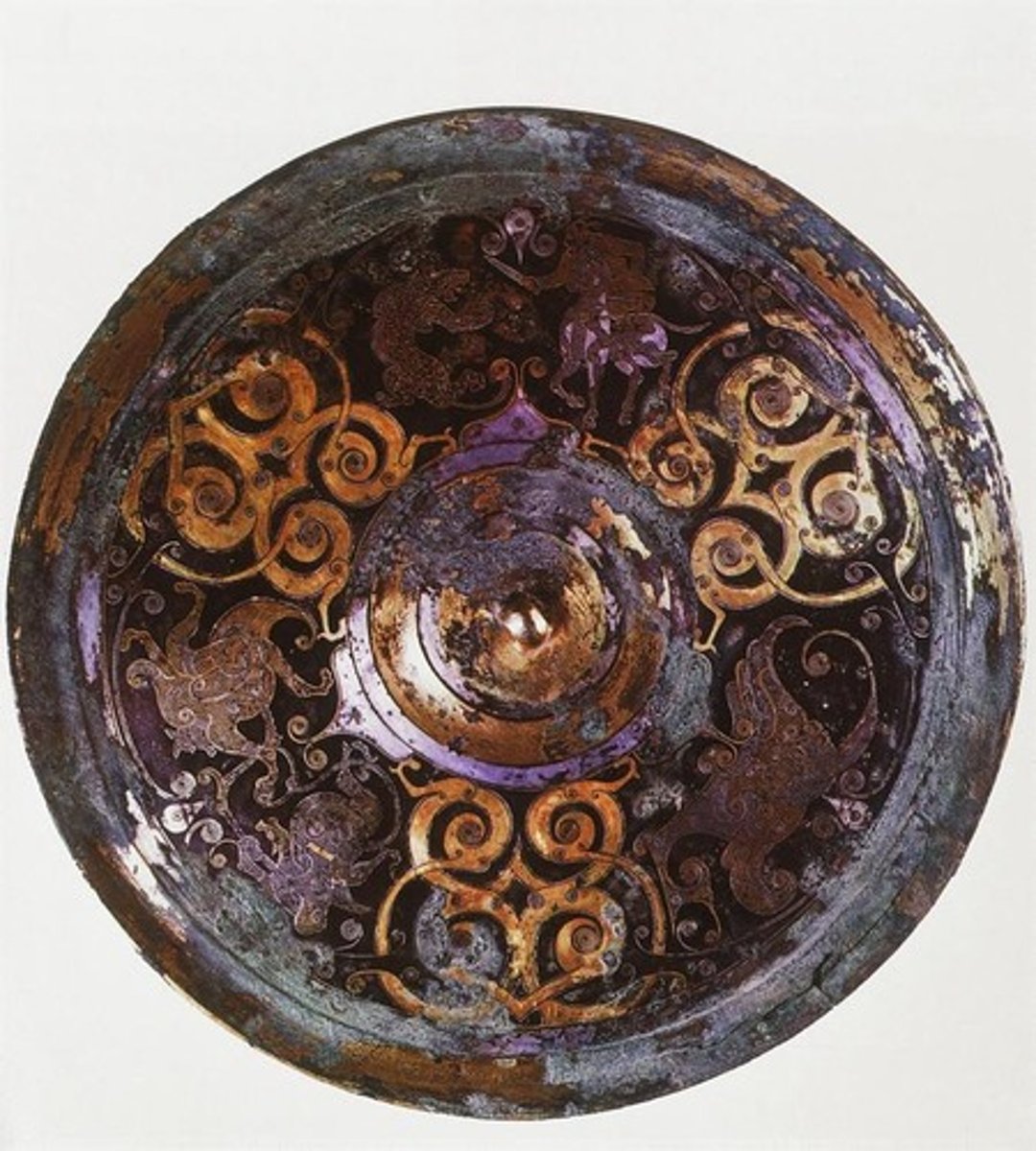
Title: Mirror
Material: Bronze inlaid with gold and silver
Period: Eastern Zhou Period
one of the scenes of the mirror depicts a person on a horse fighting a beast, mythical significance

Title: Mirror
Material: Bronze inlaid with gold and silver
Period: Eastern Zhou Period
Bronze is becoming a cheaper and more accessible material so they begin using the inlaid technique with more expensive material like gold and silver
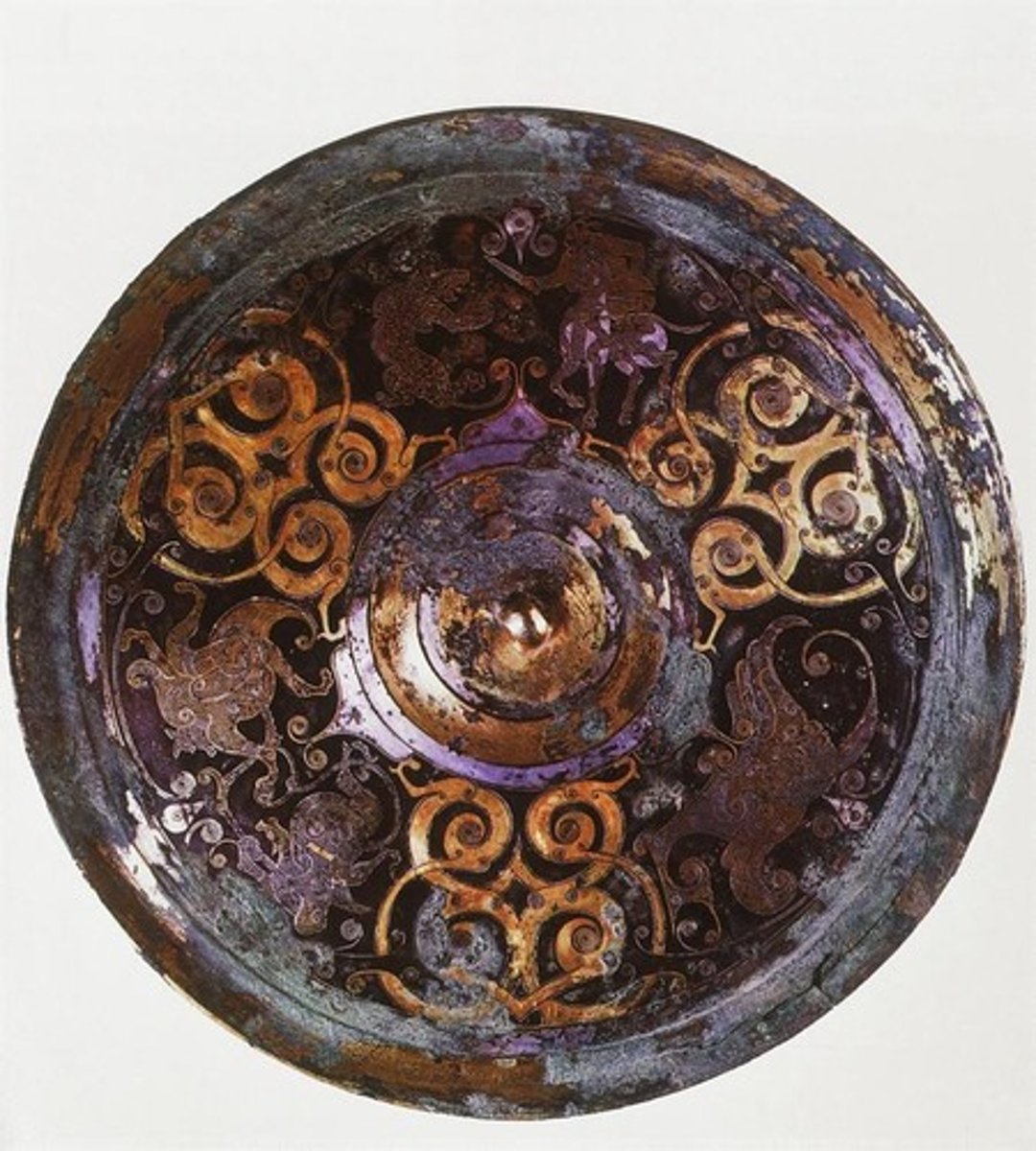
Title: Mirror
Material: Bronze inlaid with gold and silver
Period: Eastern Zhou Period
- Mirrors said to hold magic powers due to their ability to ward off darkness

Title: Man Riding a Dragon Boat
Material: Ink and color on silk
Period: Eastern Zhou Period (4th cent. BC)
one of earliest Chinese paintings
profile view characteristic of early Chinese painting
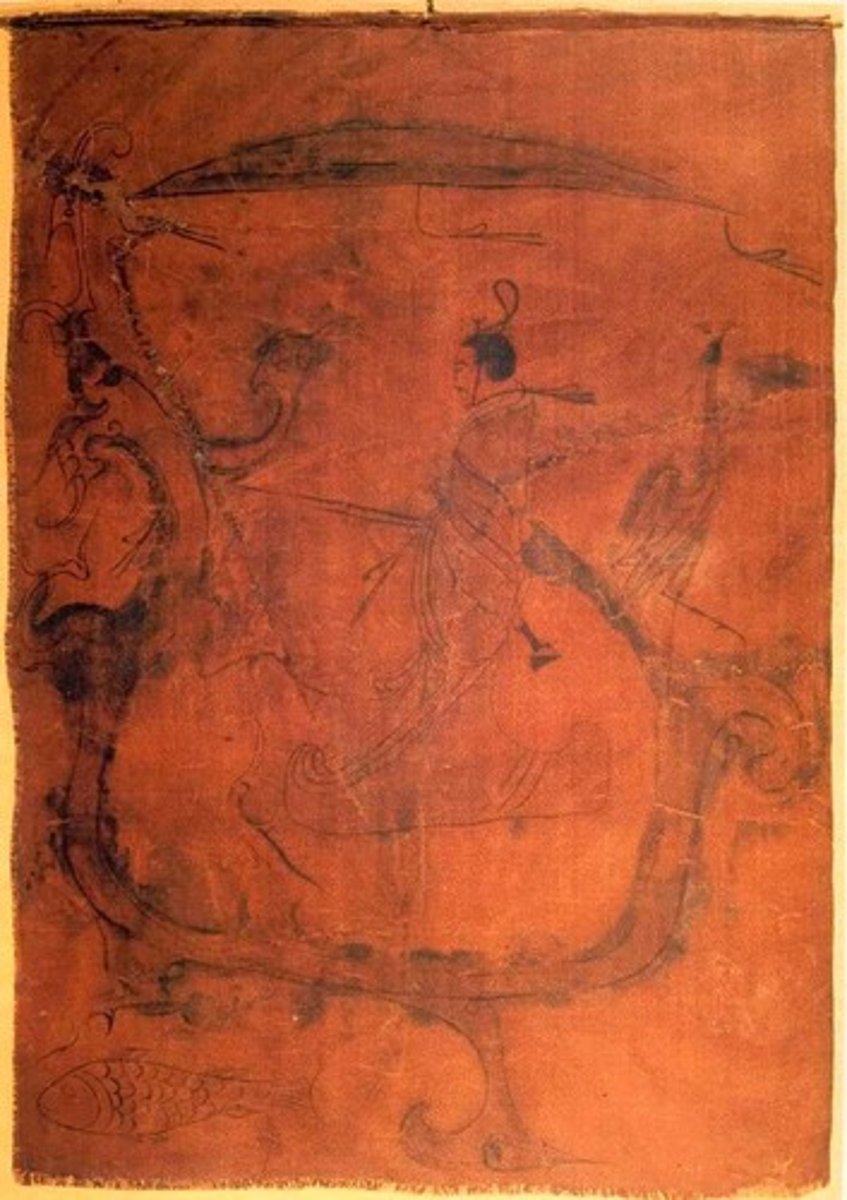
Title: Man Riding a Dragon Boat
Material: Ink and color on silk
Period: Eastern Zhou Period (4th cent. BC)
dragon is both a symbol of royal males and heaven

Title: Man Riding a Dragon Boat
Material: Ink and color on silk
Period: Eastern Zhou Period (4th cent. BC)
depicts Chinese aristocrat on dragon-boat headed to heaven (found at tomb)
- Man in aristocratic dress portrayed in profile, riding dragon (vehicle of heavenly travel) whose body forms the outline of a boat
dragon = king/emperor

Title: Man Riding a Dragon Boat
Material: Ink and color on silk
Period: Eastern Zhou Period (4th cent. BC)
linear style - all images are well-defined by outlines
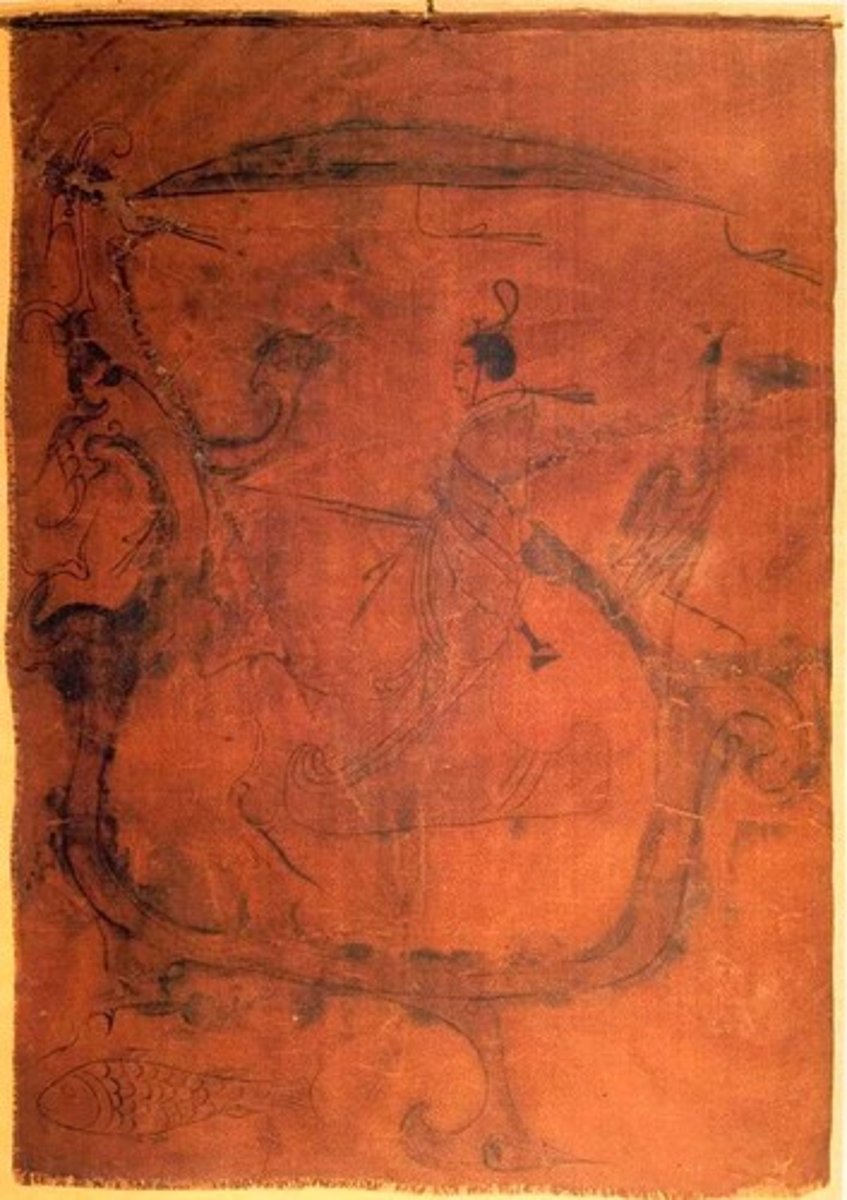
Title: Man Riding a Dragon Boat
Material: Ink and color on silk
Period: Eastern Zhou Period (4th cent. BC)
- Crane sits on dragon's tail (symbol of immortality)
-could be phoenix to represent royalty/queen/empress
- Fish = traversing water
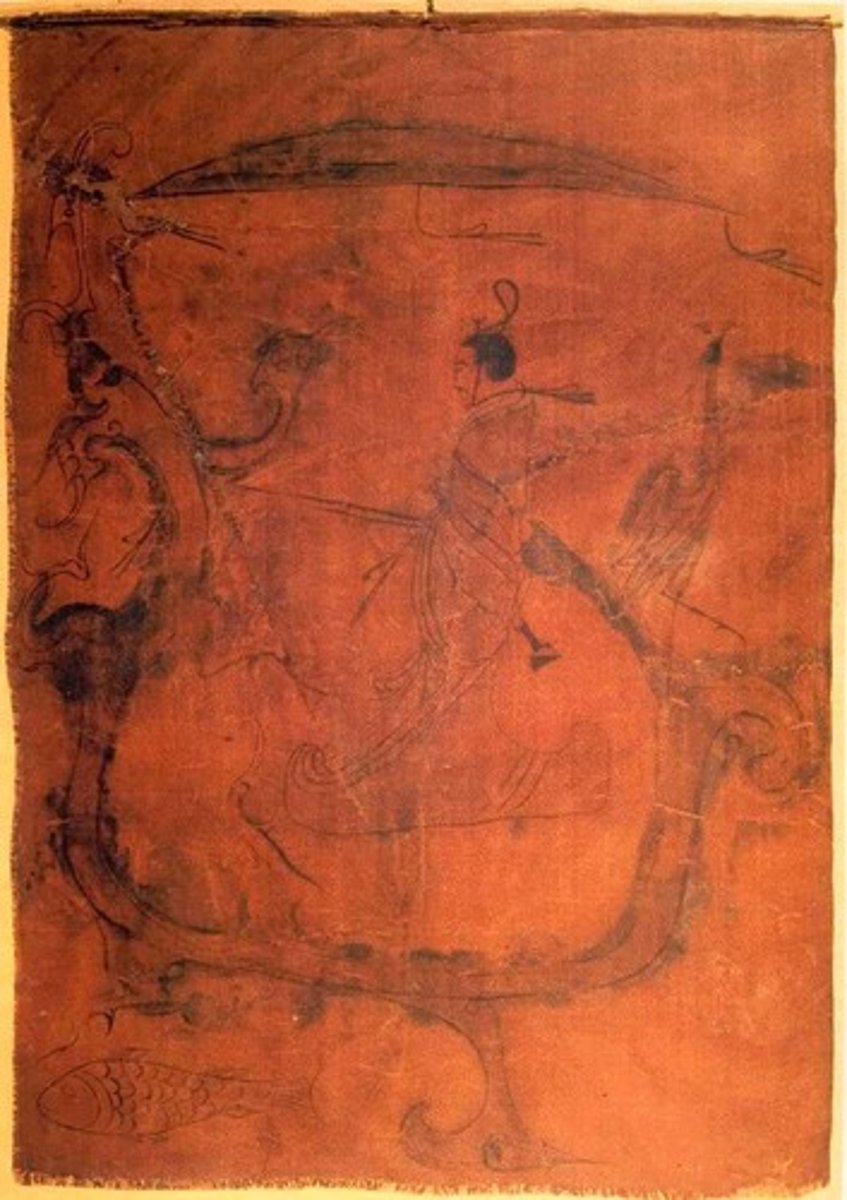
Title: Man Riding a Dragon Boat
Material: Ink and color on silk
Period: Eastern Zhou Period (4th cent. BC)
- Laid as pall over a coffin to depict soul of a dead man on his way to heaven

Title: Tomb Pit with Earthenware Burial Army
@ the Tomb of the First Emperor of Qin, Lintong, Shaanxi Province
Period: Qin Period (c. 210 BC)
more than 4,000 terracotta figures uncovered with many still to be excavated
although over 200 models exist, figures are not completely unique

Title: Tomb Pit with Earthenware Burial Army
@ the Tomb of the First Emperor of Qin, Lintong, Shaanxi Province
Period: Qin Period (c. 210 BC)
show characteristic features of people of the region - long, rectangular faces featuring facial hair, hair held up by bun
- Various provincial headdresses of the warriors are depicted in specific detail

Title: Tomb Pit with Earthenware Burial Army
@ the Tomb of the First Emperor of Qin, Lintong, Shaanxi Province
Period: Qin Period (c. 210 BC)
statues' heads and arms created separately, then assembled
in standing posture
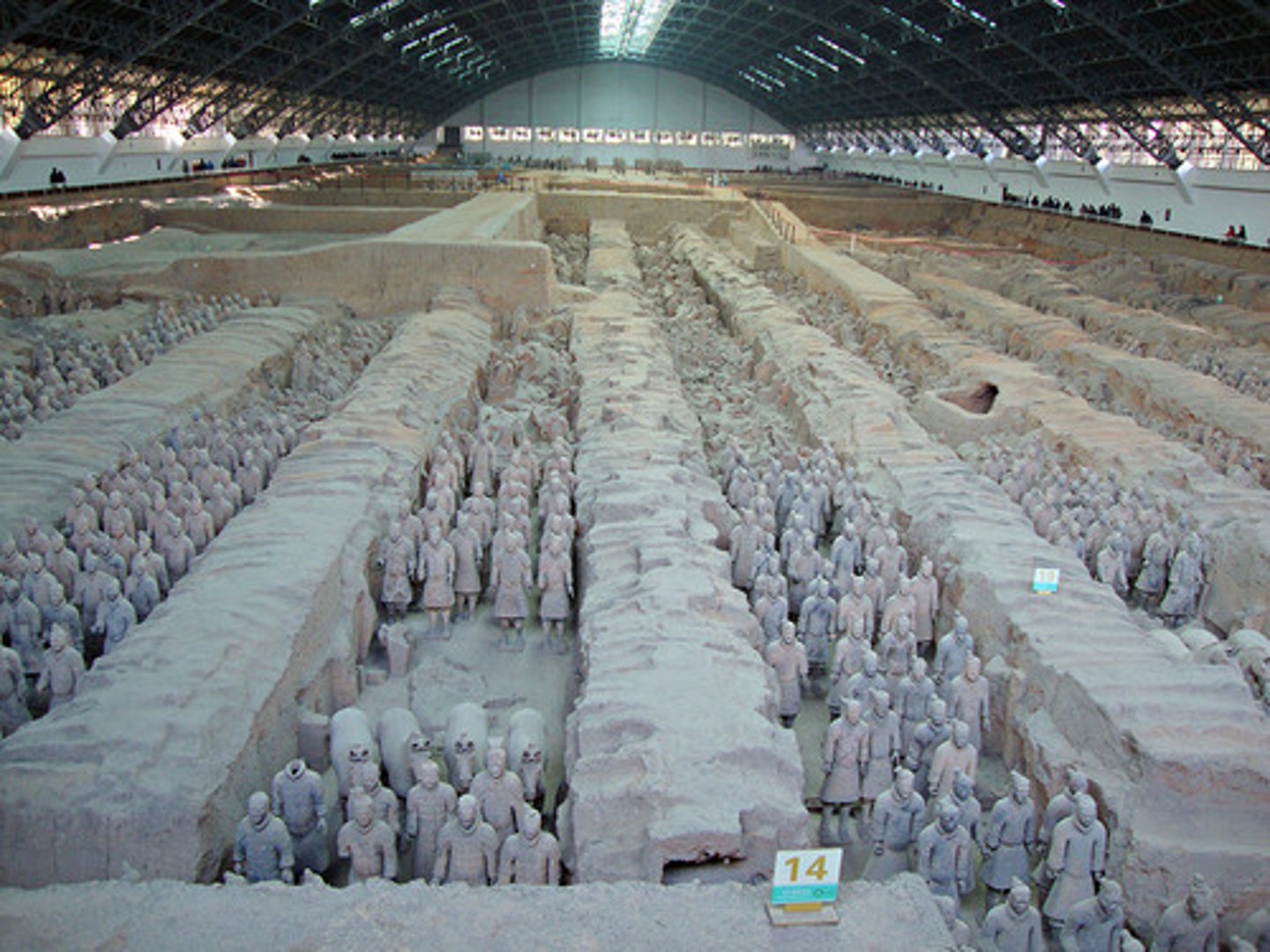
Title: Tomb Pit with Earthenware Burial Army
@ the Tomb of the First Emperor of Qin, Lintong, Shaanxi Province
Period: Qin Period (c. 210 BC)
unknown how all terracotta figures were transported to location of the tomb

Title: Tomb Pit with Earthenware Burial Army
@ the Tomb of the First Emperor of Qin, Lintong, Shaanxi Province
Period: Qin Period (c. 210 BC)
Representation of the megalomanic power of the emperor
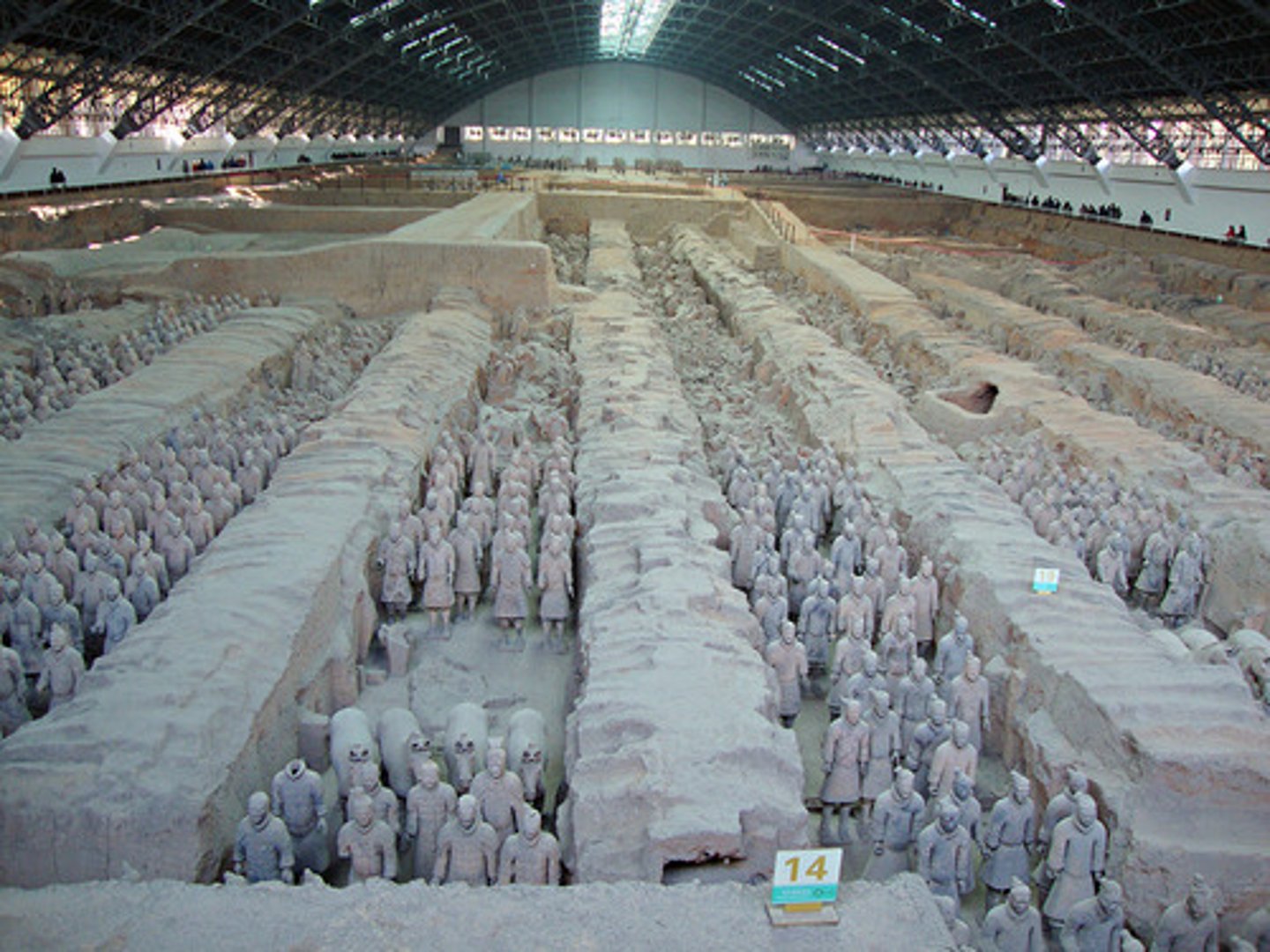
Title: Tomb Pit with Earthenware Burial Army
@ the Tomb of the First Emperor of Qin, Lintong, Shaanxi Province
Period: Qin Period (c. 210 BC)
they are guarding the tomb of the First Emperor. The emperor could have built this to protect himself even in the afterlife
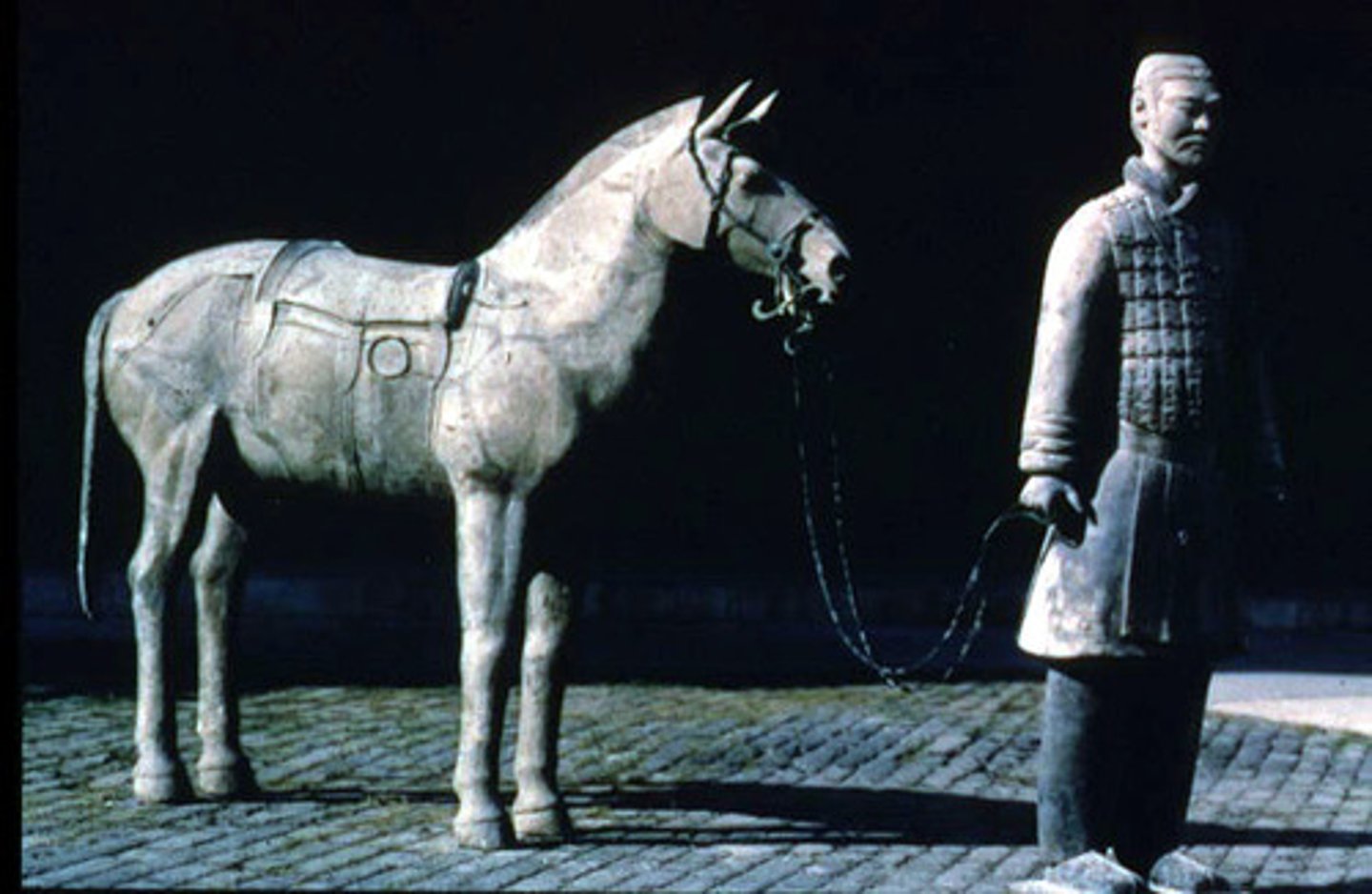
Title: Cavalryman and Saddle Horse
Material: Earthenware
@ the Tomb of the First Emperor of Qin, Lintong, Shaanxi Province
Period: Qin Period (c. 210 BC)
detailed and realistic depictions of animals as well as people
- Life-sized clay warriors;
naturalistic

Title: Cavalryman and Saddle Horse
Material: Earthenware
@ the Tomb of the First Emperor of Qin, Lintong, Shaanxi Province
Period: Qin Period (c. 210 BC)
- Originally richly polychromed
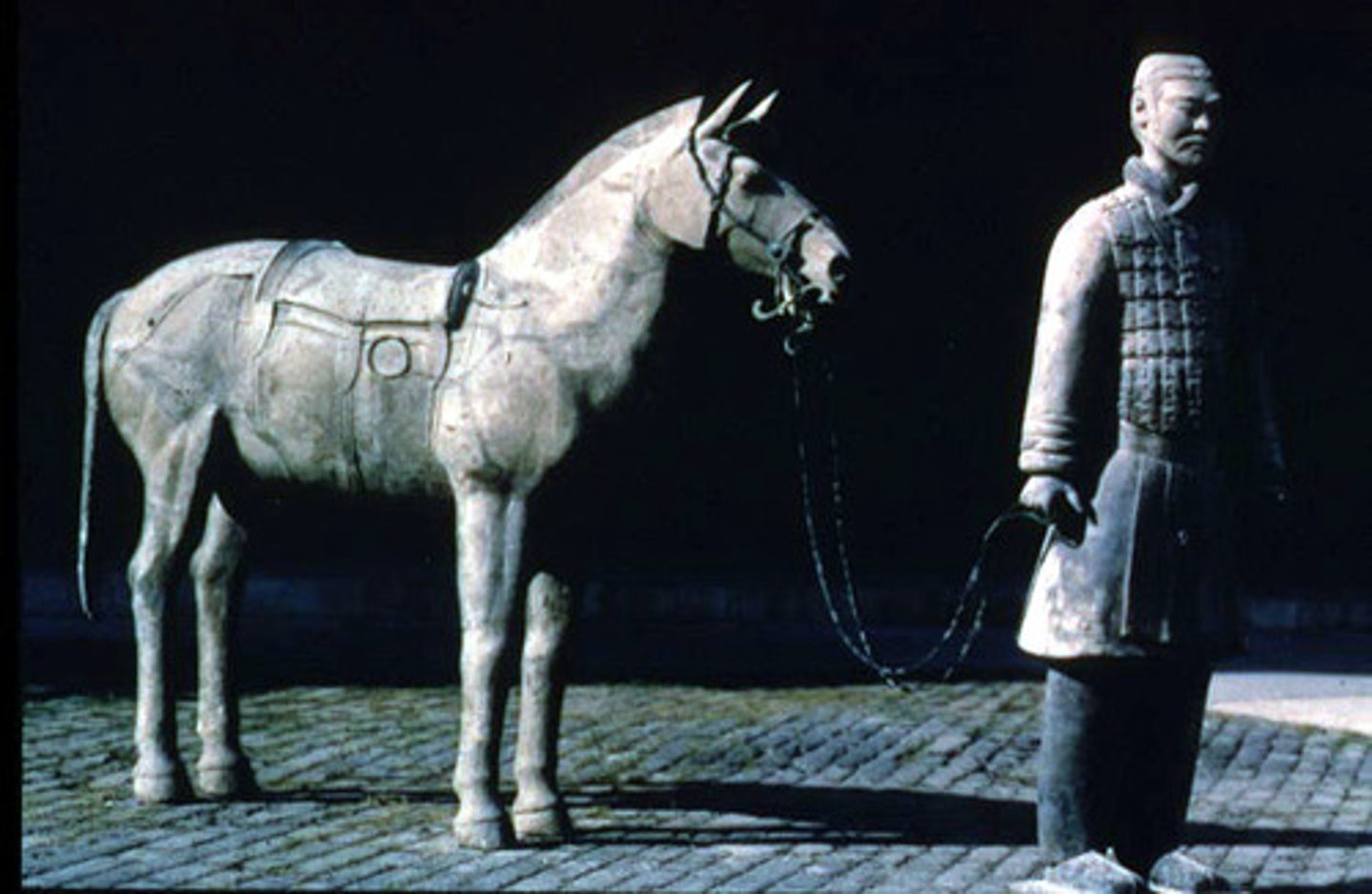
Title: Cavalryman and Saddle Horse
Material: Earthenware
@ the Tomb of the First Emperor of Qin, Lintong, Shaanxi Province
Period: Qin Period (c. 210 BC)
horse smaller than common horse because it is a mongolian horse
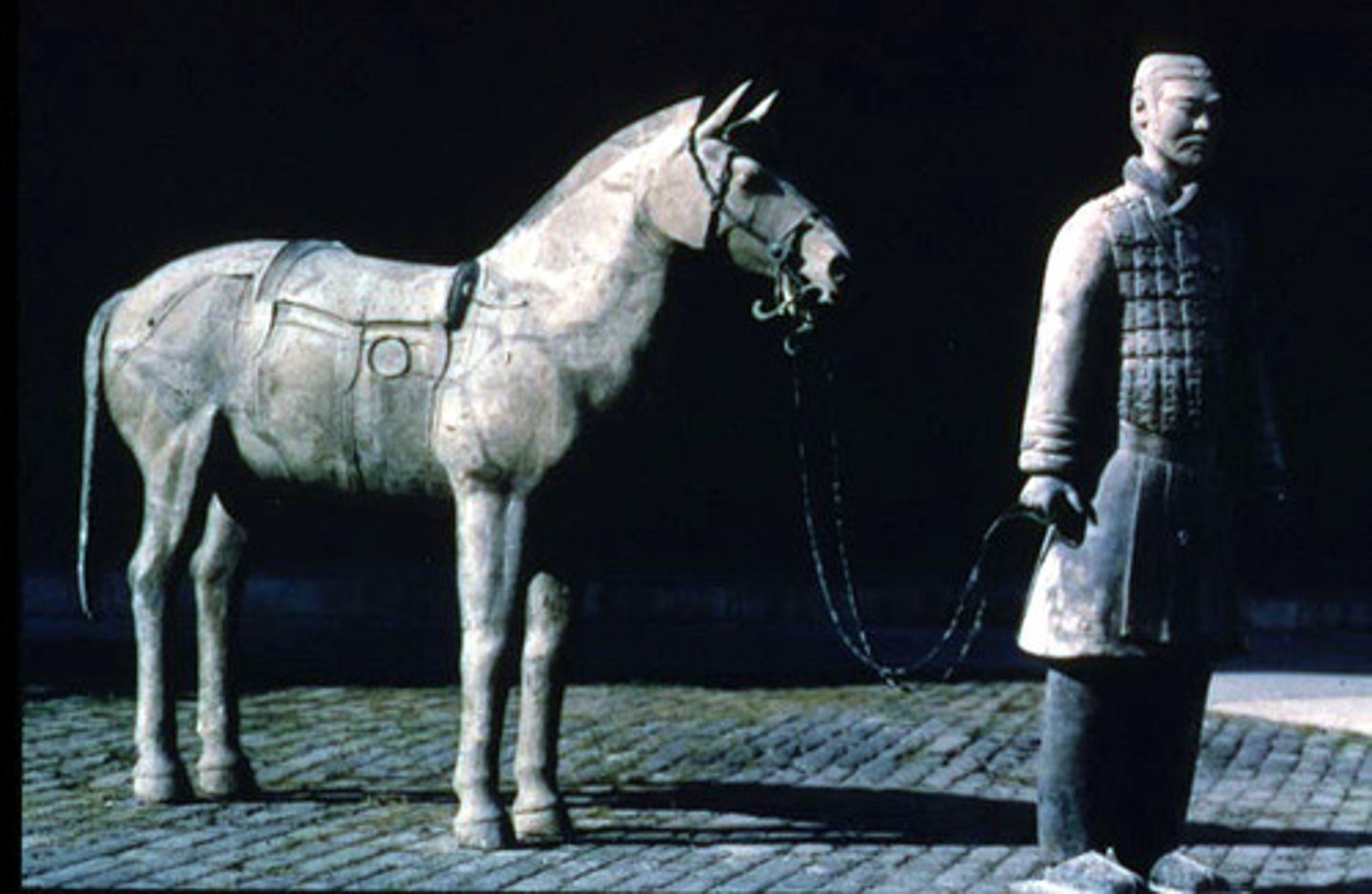
Title: Cavalryman and Saddle Horse
Material: Earthenware
@ the Tomb of the First Emperor of Qin, Lintong, Shaanxi Province
Period: Qin Period (c. 210 BC)
could be a general or military person because of the armor worn
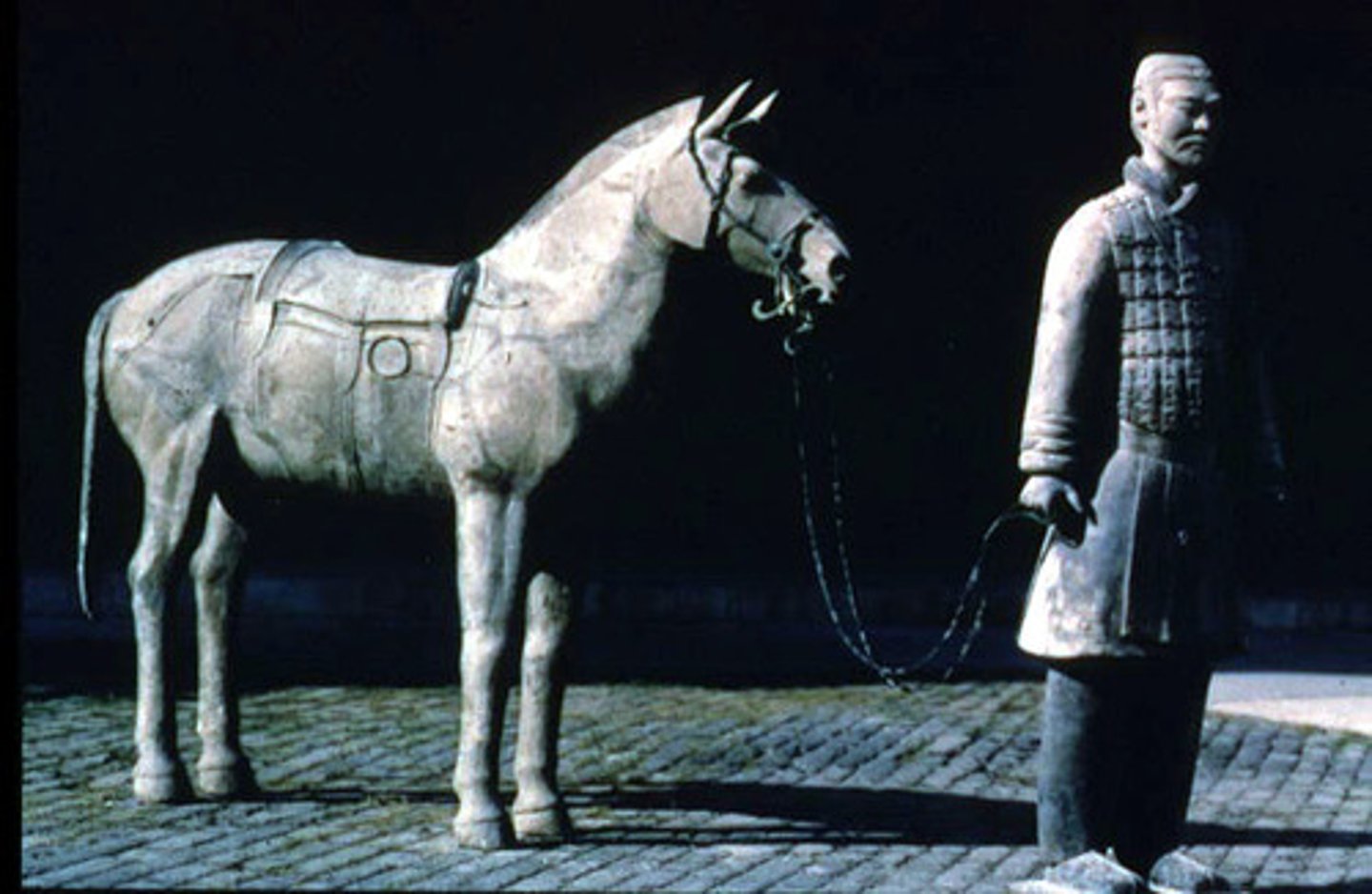
Title: Cavalryman and Saddle Horse
Material: Earthenware
@ the Tomb of the First Emperor of Qin, Lintong, Shaanxi Province
Period: Qin Period (c. 210 BC)
shows understanding of human facial feature, basic body design, and animal design
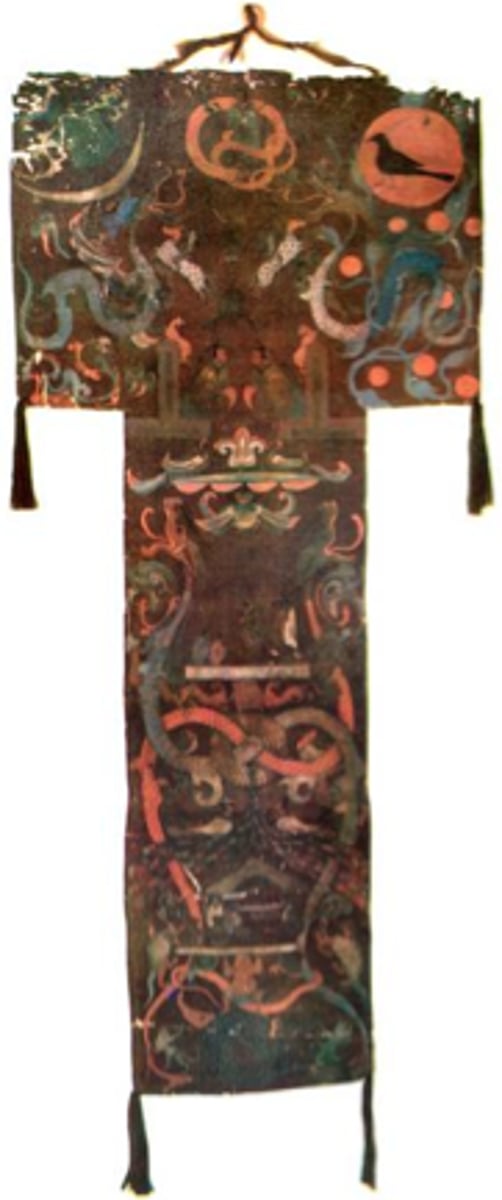
Title: Feiyi (Flying Banner)
Material: Ink and Color on Silk
@ Tomb of the Marquis of Dai, Changsha, Hunan Province
Period: Western Han Period (c. 186-168 BC)
covered innermost coffin
mineral pigments with water remains vibrant with protection of the tomb and coffins
original color: tan → dark color
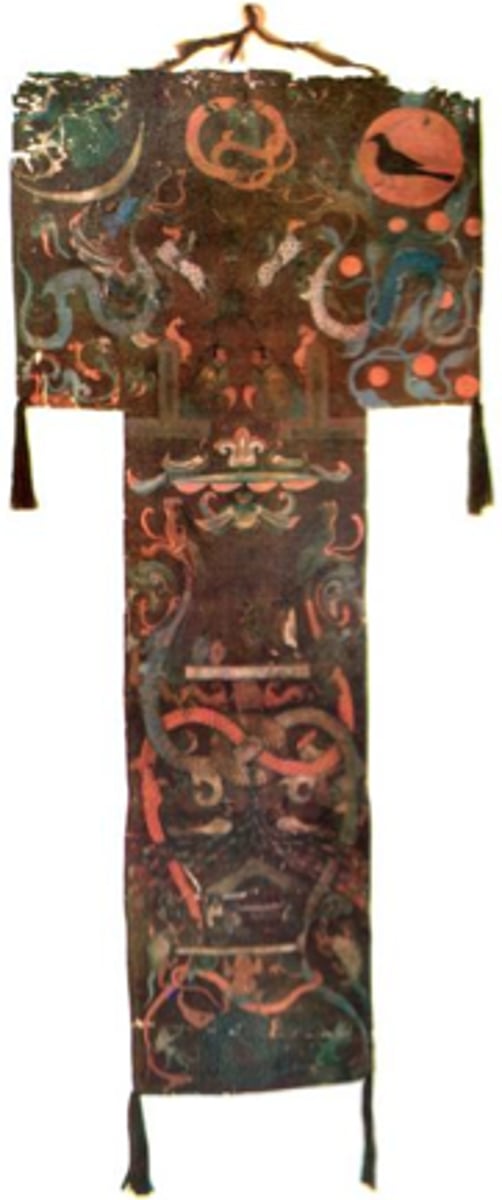
Title: Feiyi (Flying Banner)
Material: Ink and Color on Silk
@ Tomb of the Marquis of Dai, Changsha, Hunan Province
Period: Western Han Period (c. 186-168 BC)
- Three world's composition (heaven, earthly, hell realms)
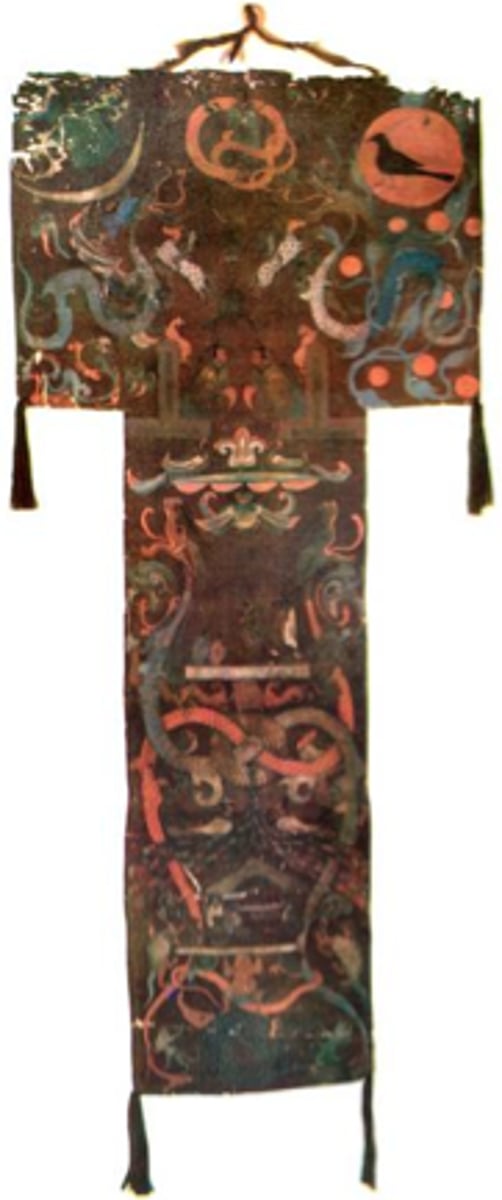
Title: Feiyi (Flying Banner)
Material: Ink and Color on Silk
@ Tomb of the Marquis of Dai, Changsha, Hunan Province
Period: Western Han Period (c. 186-168 BC)
- Composition: Queen Mother of the West (universe creator); Sun/Blackbird + Moon/toad; A pair of white dragons; imaginary creatures
- Symmetrical composition in heavenly realm
cranes represent longevity
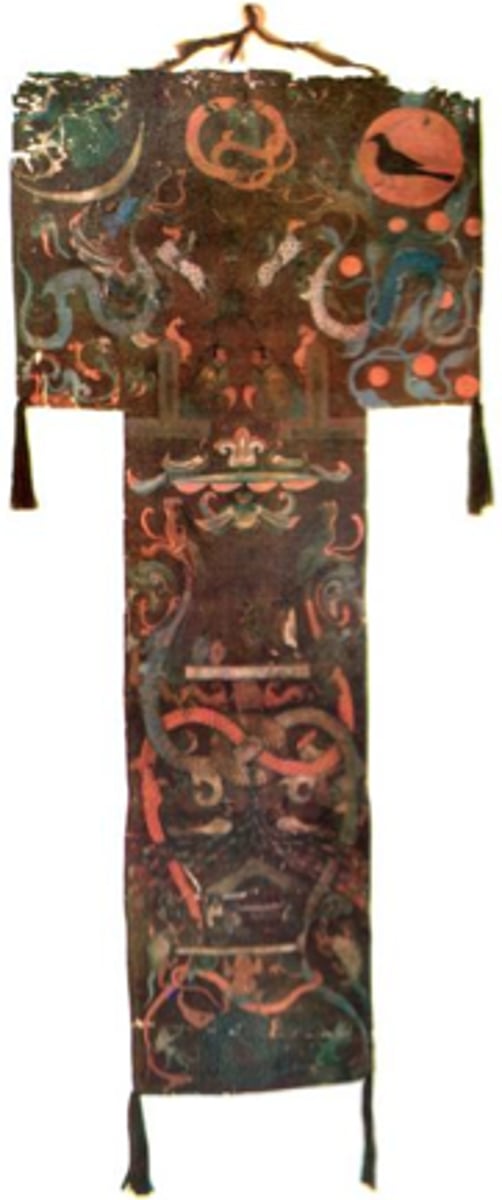
Title: Feiyi (Flying Banner)
Material: Ink and Color on Silk
@ Tomb of the Marquis of Dai, Changsha, Hunan Province
Period: Western Han Period (c. 186-168 BC)
- Earthly realm uses hierarchy of scale to portray Marquise of Dai's importance (status of attendants); facial features are clear even with the figures in the back; warm colors
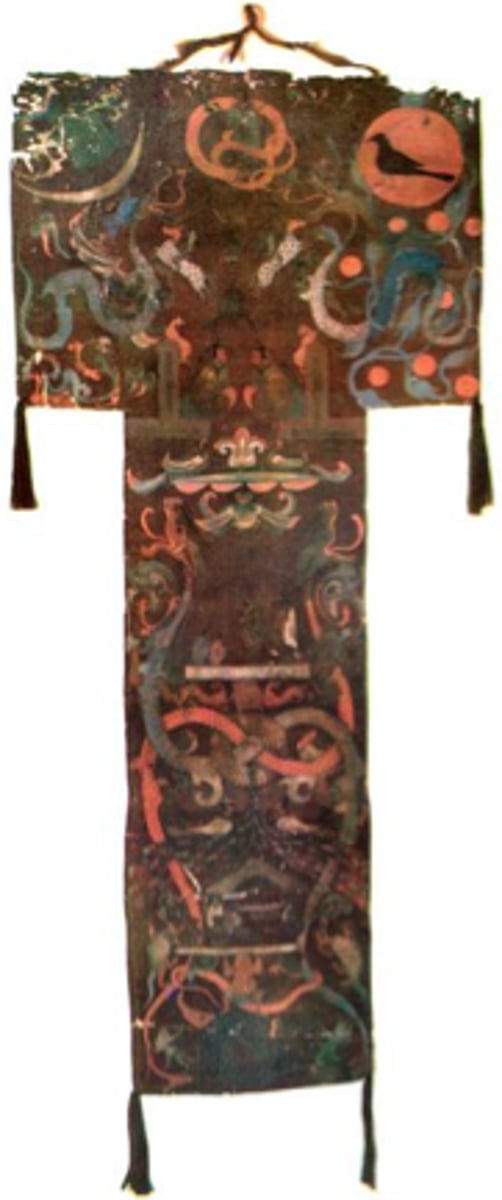
Title: Feiyi (Flying Banner)
Material: Ink and Color on Silk
@ Tomb of the Marquis of Dai, Changsha, Hunan Province
Period: Western Han Period (c. 186-168 BC)
figures in hell painted with bluish-grey skin tone; believed to be underwater as seen with fishlike monsters
- Bottom realm: linear style, underwater, bronze ritual vessels
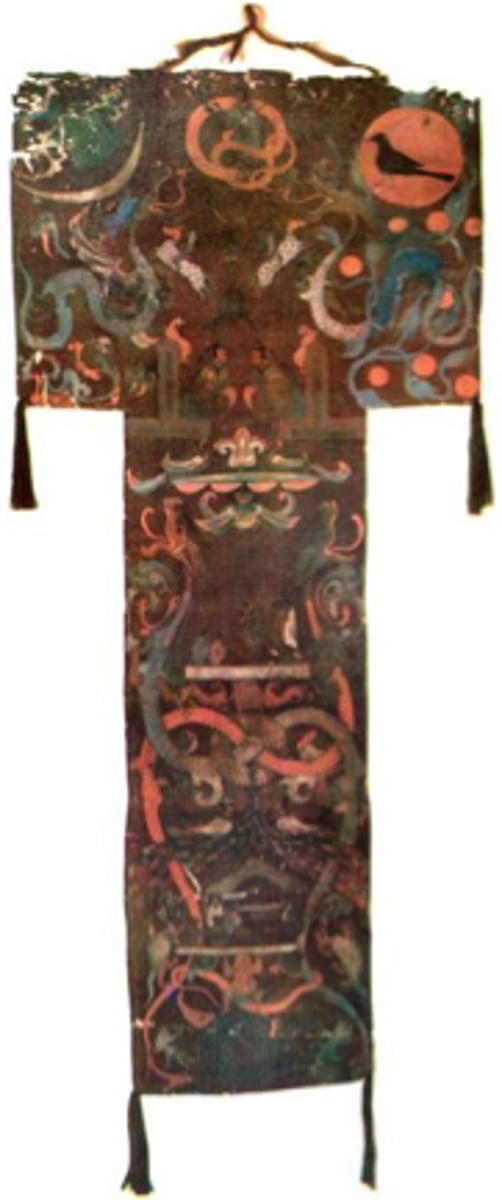
Title: Feiyi (Flying Banner)
Material: Ink and Color on Silk
@ Tomb of the Marquis of Dai, Changsha, Hunan Province
Period: Western Han Period (c. 186-168 BC)
- Indicate belief in the afterlife
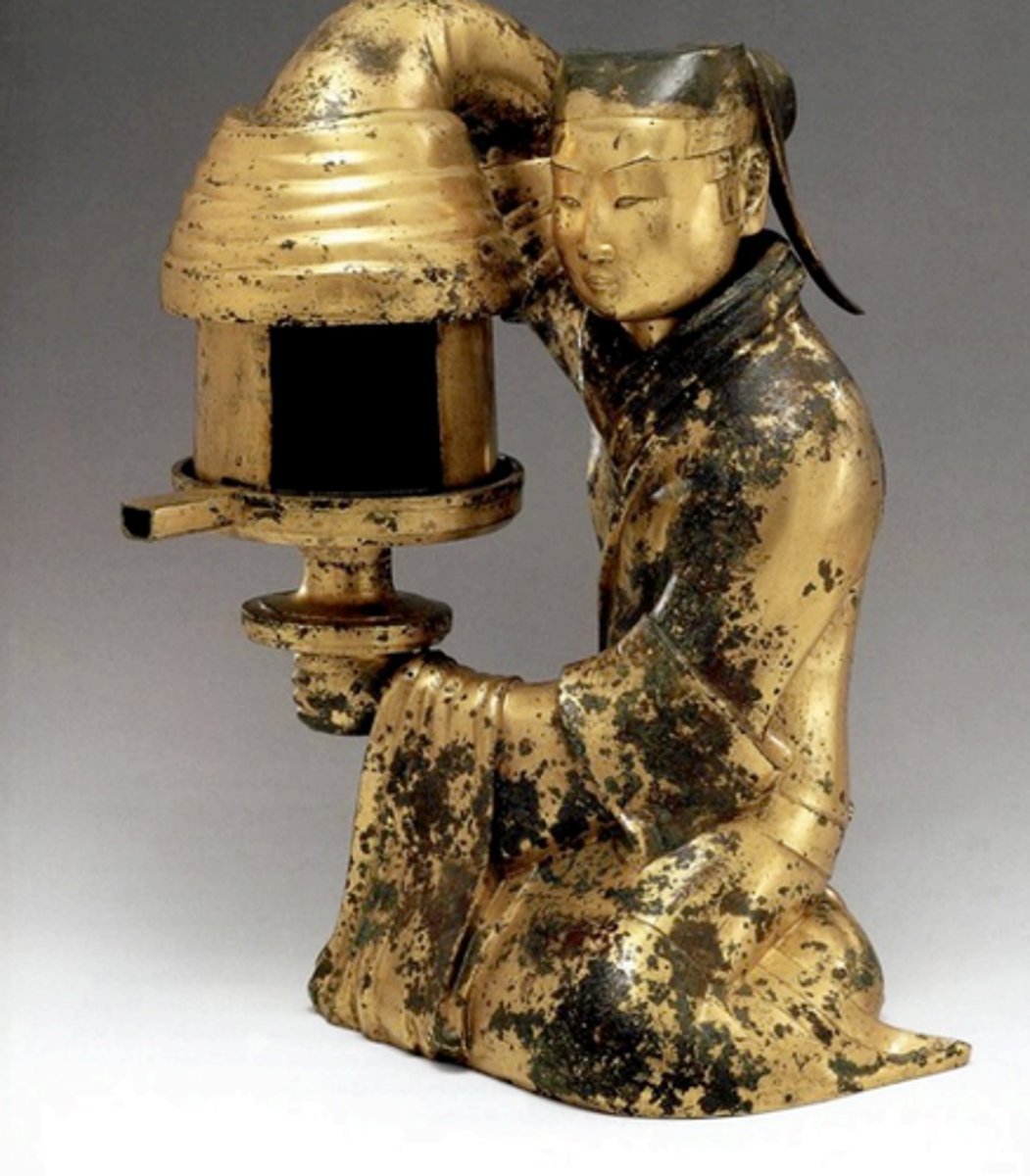
Title: Lamp in the Shape of Serving Girl
Material: Gilt Bronze
@ Tomb of Dou Wan
Period: Western Han Period (c. 173 BC)
highly realistic depiction of the human figure; flow of clothing is natural, body proportional

Title: Lamp in the Shape of Serving Girl
Material: Gilt Bronze
@ Tomb of Dou Wan
Period: Western Han Period (c. 173 BC)
serves both decorative and utilitarian functions with hollow arms serving to vent smoke from lamp
- Functional design; lamp has sliding door to control light, smoke is directed through servant's sleeve
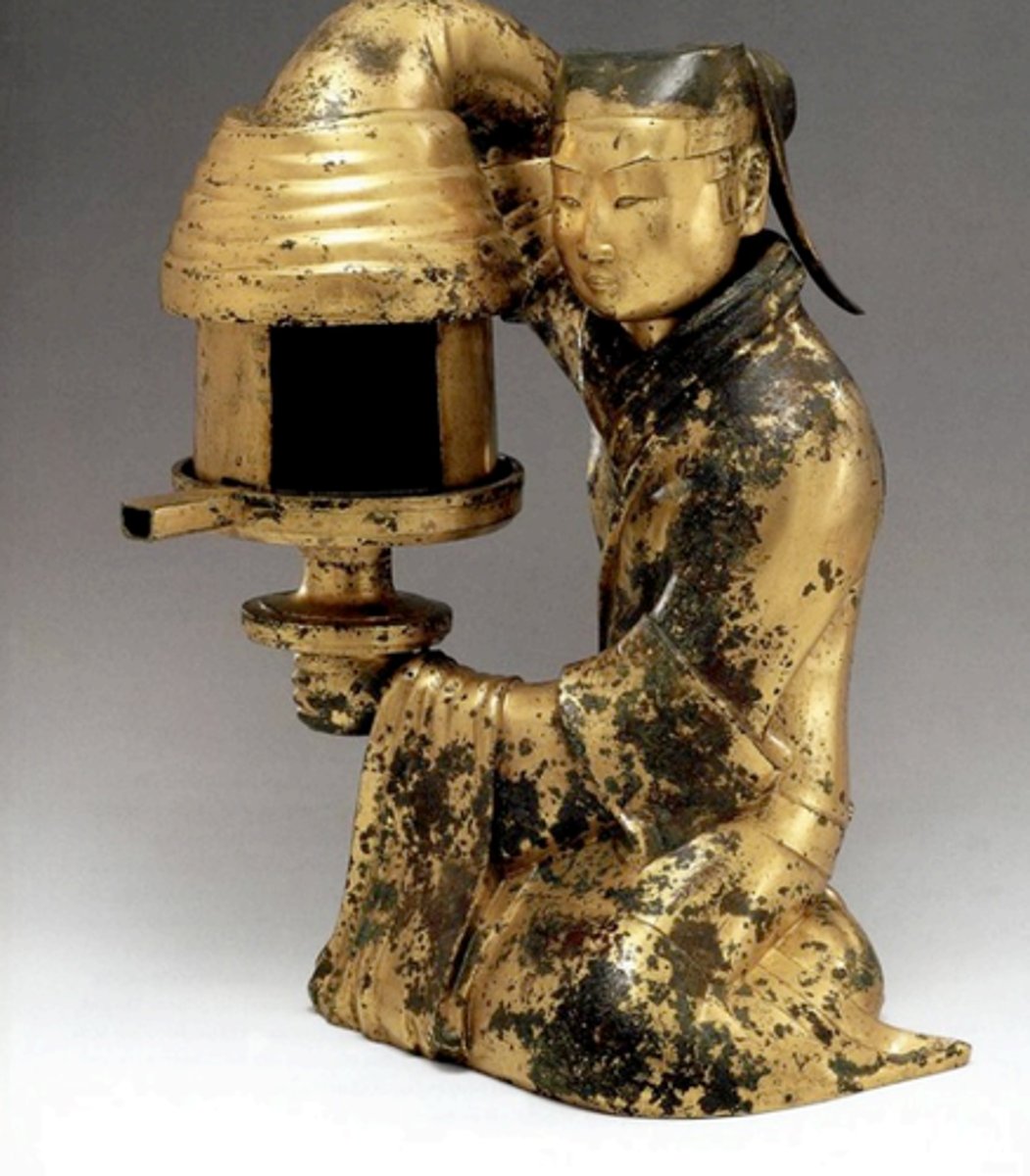
Title: Lamp in the Shape of Serving Girl
Material: Gilt Bronze
@ Tomb of Dou Wan
Period: Western Han Period (c. 173 BC)
- Realistic representation of kneeling, offering figure with an emphasis on the drapery of the garment
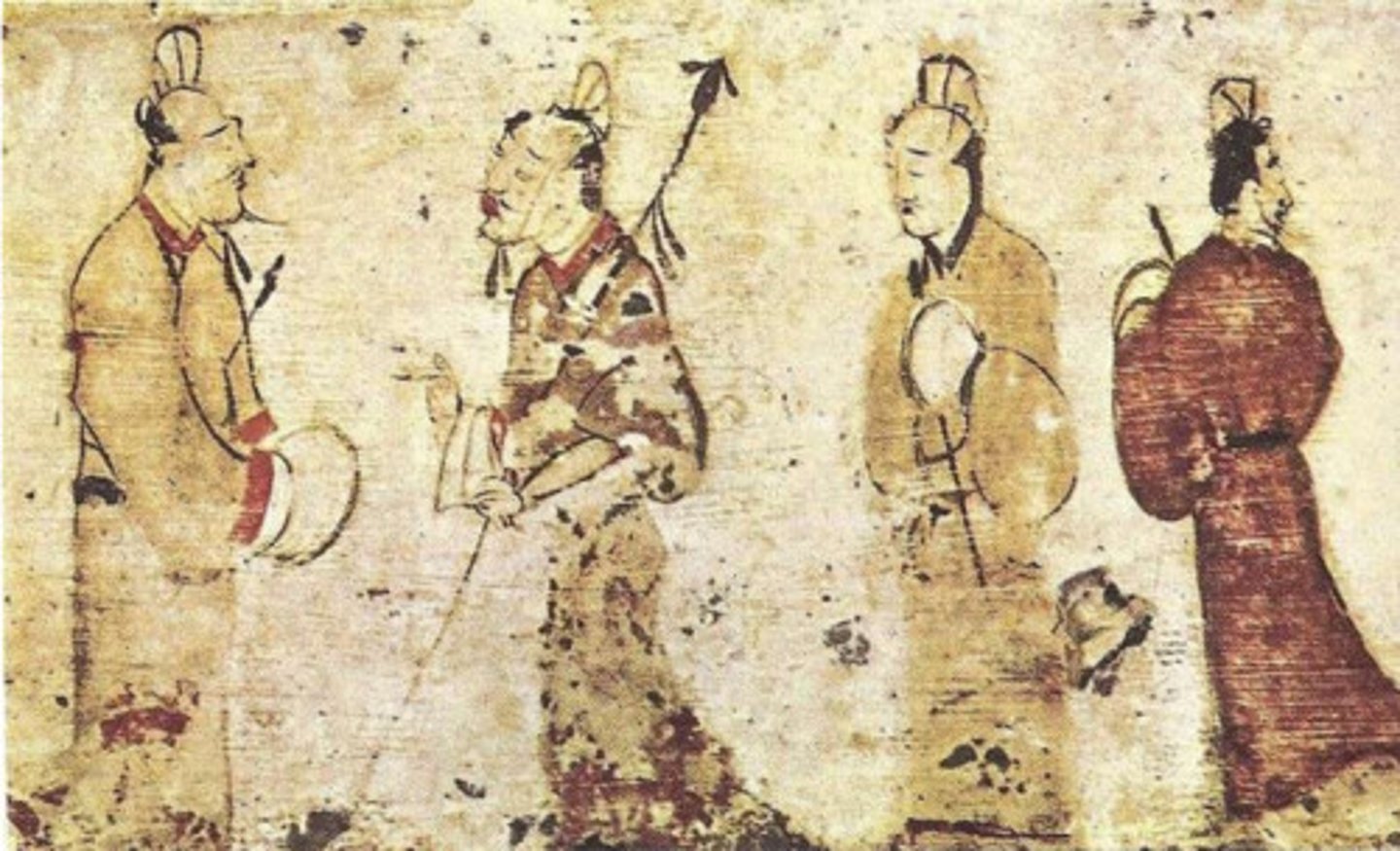
Title: Gentlemen in Conversation
Material: Painted Earthenware Tile
Period: Eastern Han Period (1st c. AD)
three-quarters face image engages viewer more --> art meant to instruct viewer
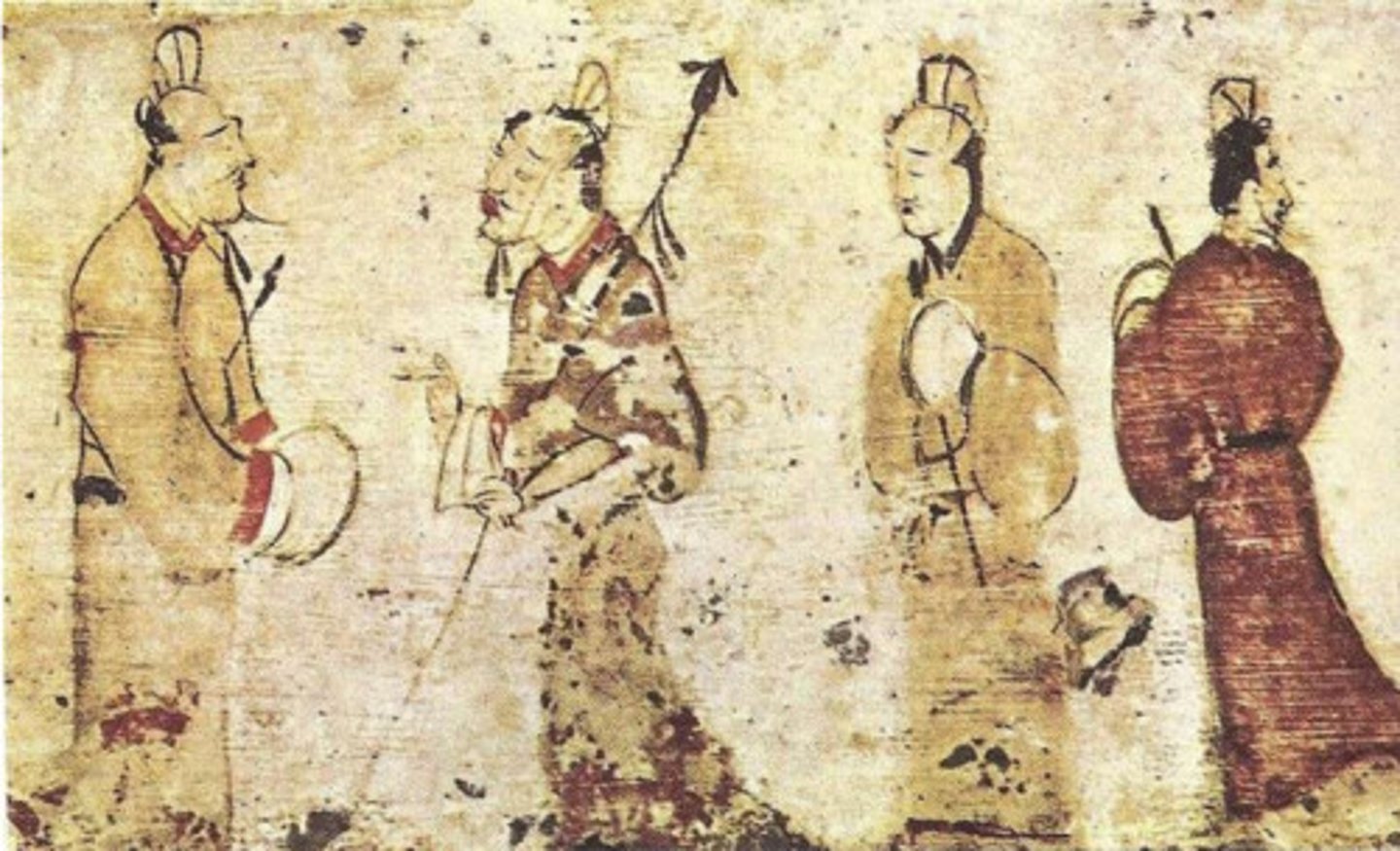
Title: Gentlemen in Conversation
Material: Painted Earthenware Tile
Period: Eastern Han Period (1st c. AD)
more natural style with less distinct outlines
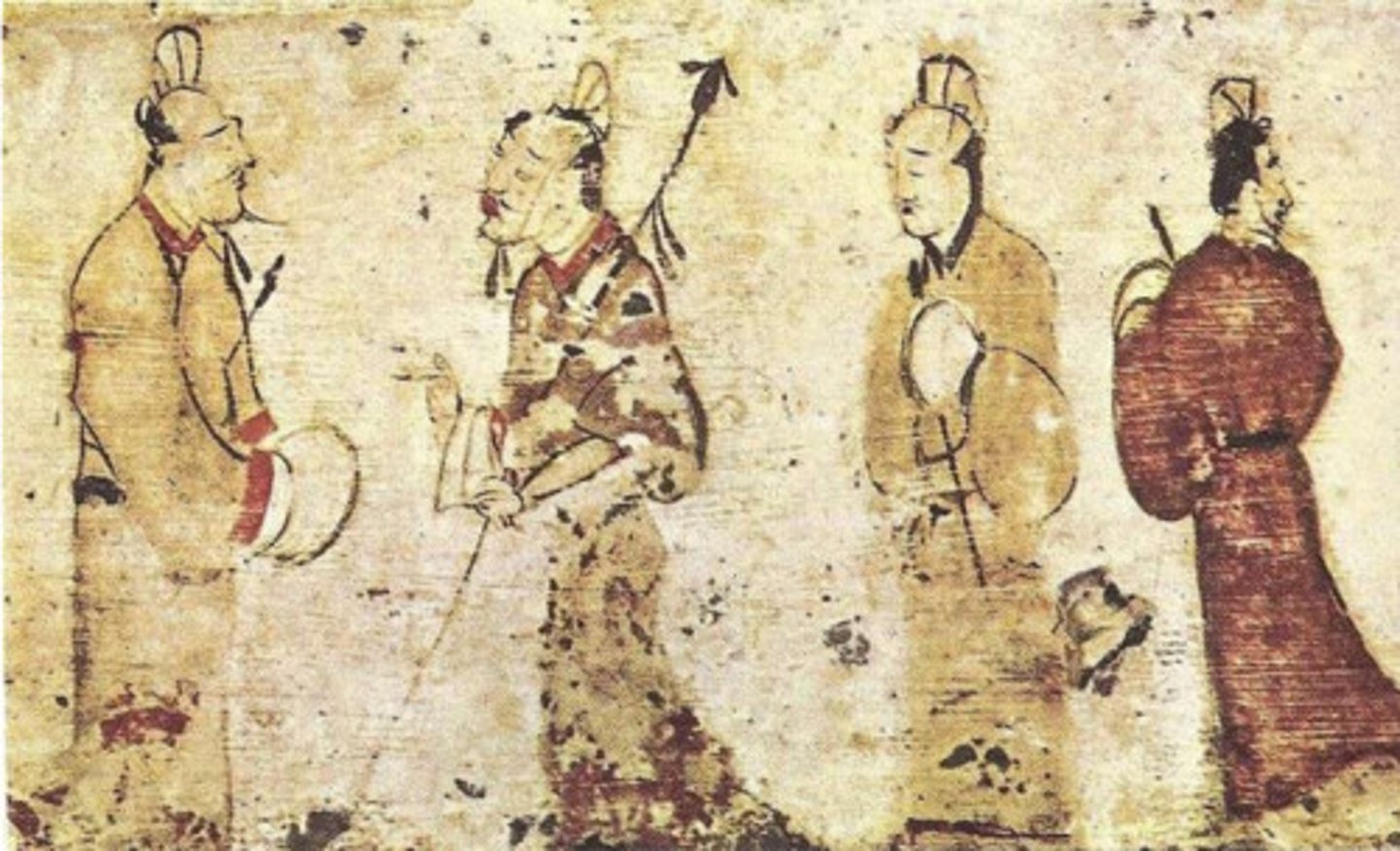
Title: Gentlemen in Conversation
Material: Painted Earthenware Tile
Period: Eastern Han Period (1st c. AD)
- Attitude and pose of each figure conveys something of the psychology of each person
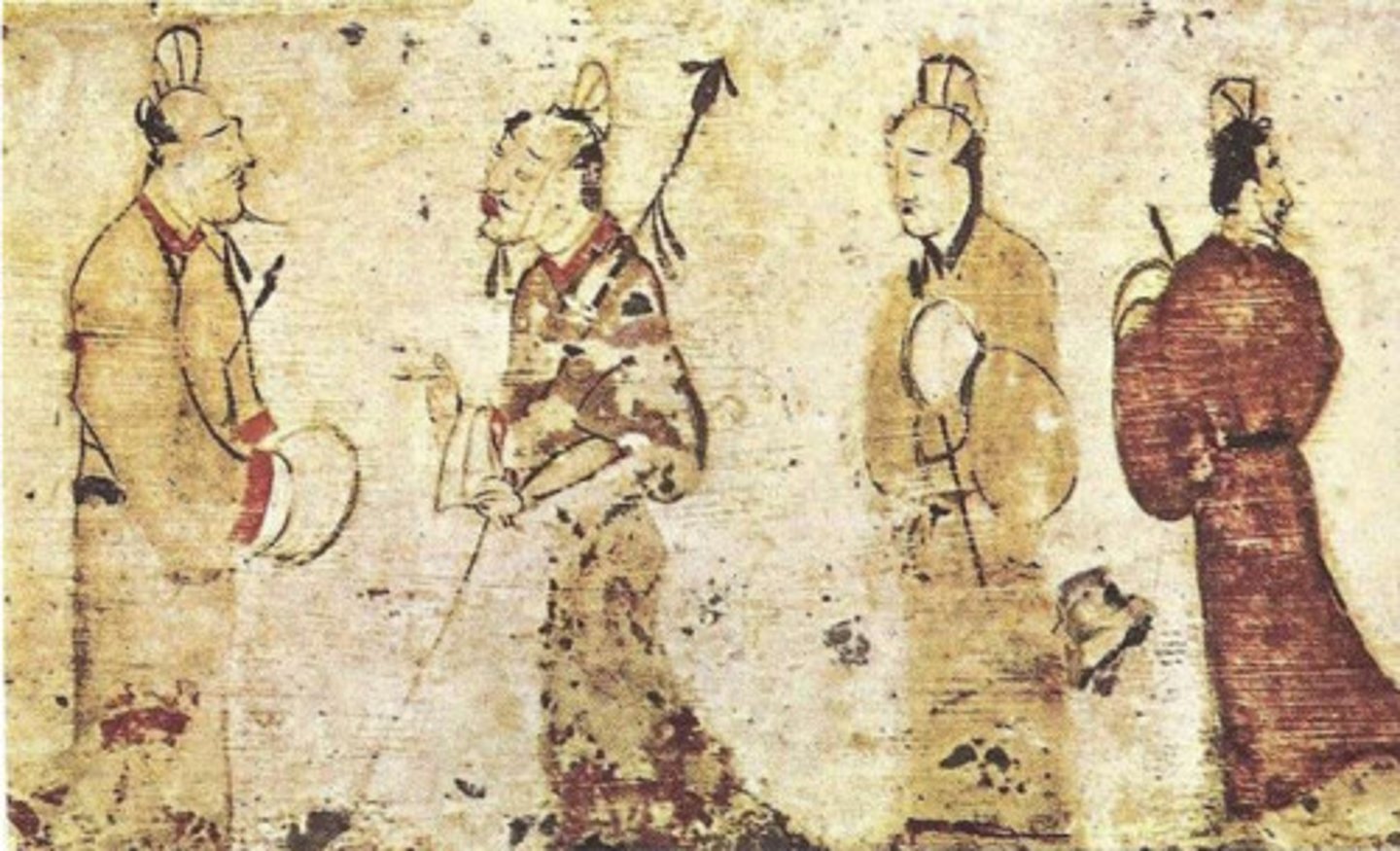
Title: Gentlemen in Conversation
Material: Painted Earthenware Tile
Period: Eastern Han Period (1st c. AD)
- Placement of figures is primitive, no setting is used
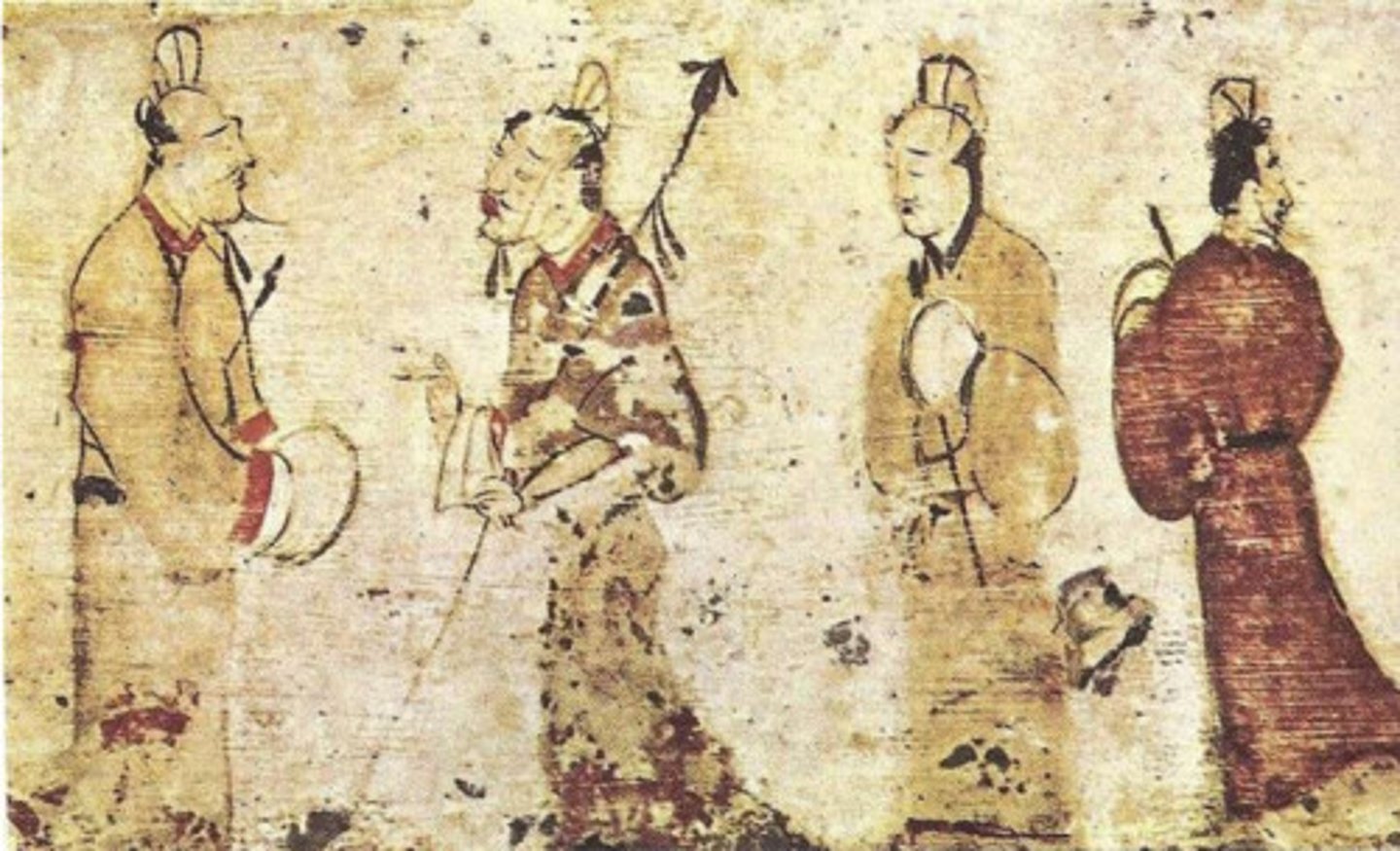
Title: Gentlemen in Conversation
Material: Painted Earthenware Tile
Period: Eastern Han Period (1st c. AD)
Demonstrates progress in the use of brush
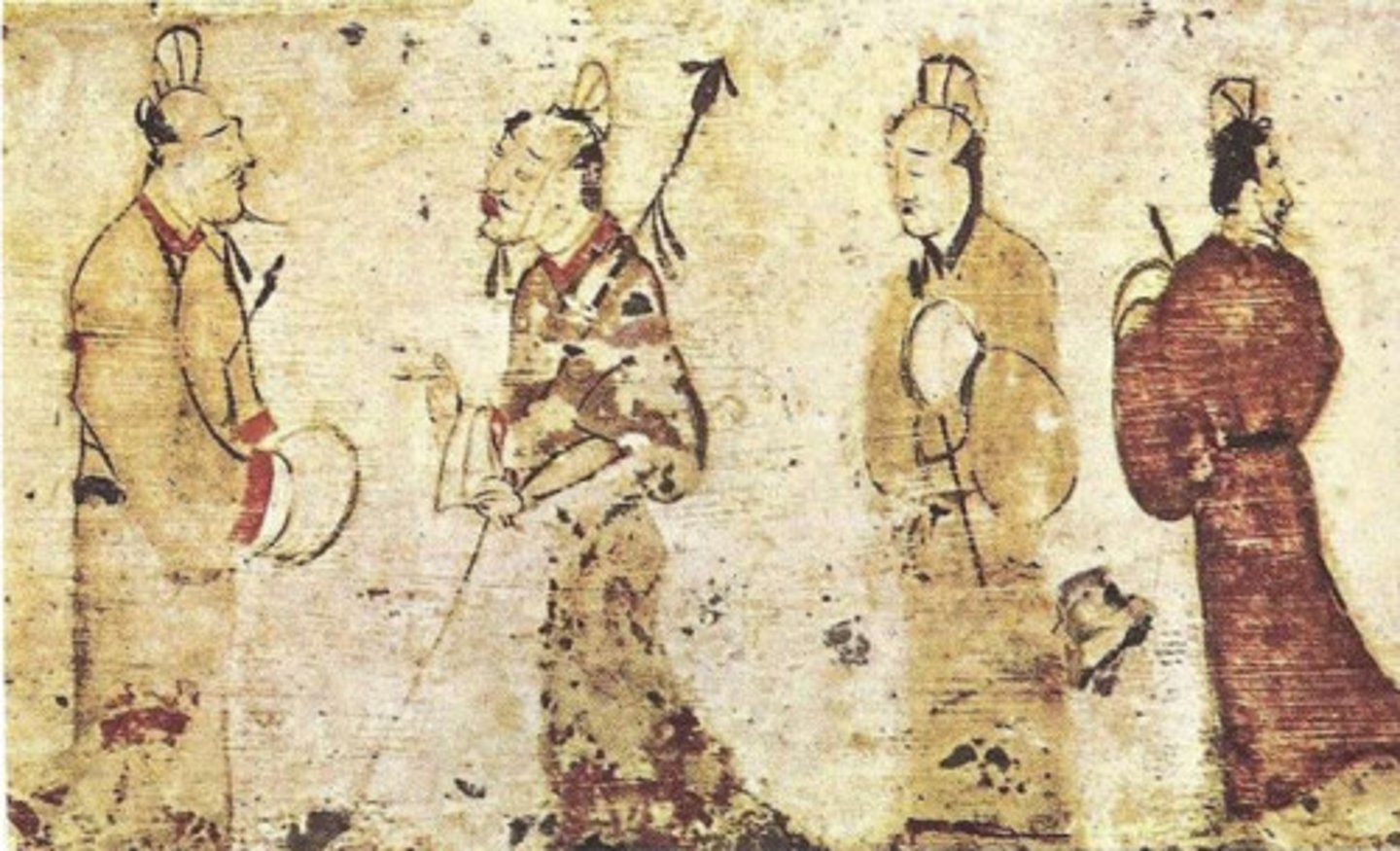
Title: Gentlemen in Conversation
Material: Painted Earthenware Tile
Period: Eastern Han Period (1st c. AD)
found in a tomb and not is represented at the Boston museum of the fine arts

Title: The Archer Yi, The Fushan Tree, and Reception in a Mansion
Material: Rubbing of Stone Relief
@ Wu Family Shrines, Jiaxiang, Shangdong Province
Period: Eastern Han Period
shallow stone reliefs allowed for rubbings to be made and distributed for education
- Design is formal and static, figures are carefully placed and spaced
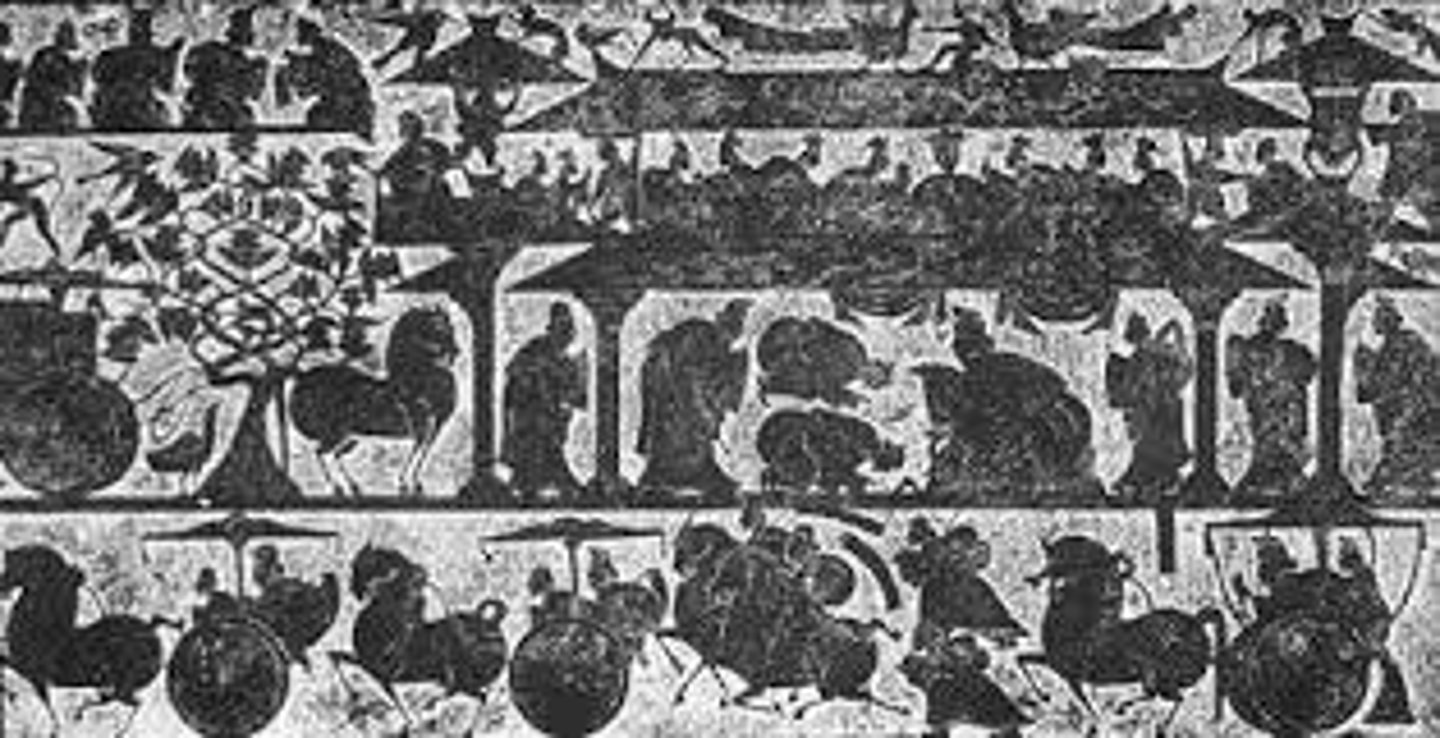

Title: The Archer Yi, The Fushan Tree, and Reception in a Mansion
Material: Rubbing of Stone Relief
@ Wu Family Shrines, Jiaxiang, Shangdong Province
Period: Eastern Han Period
completely disregards sense of depth in favor of greater sense of organization; uses registers
- Background cut away to create all-important silhouette in extremely low relief
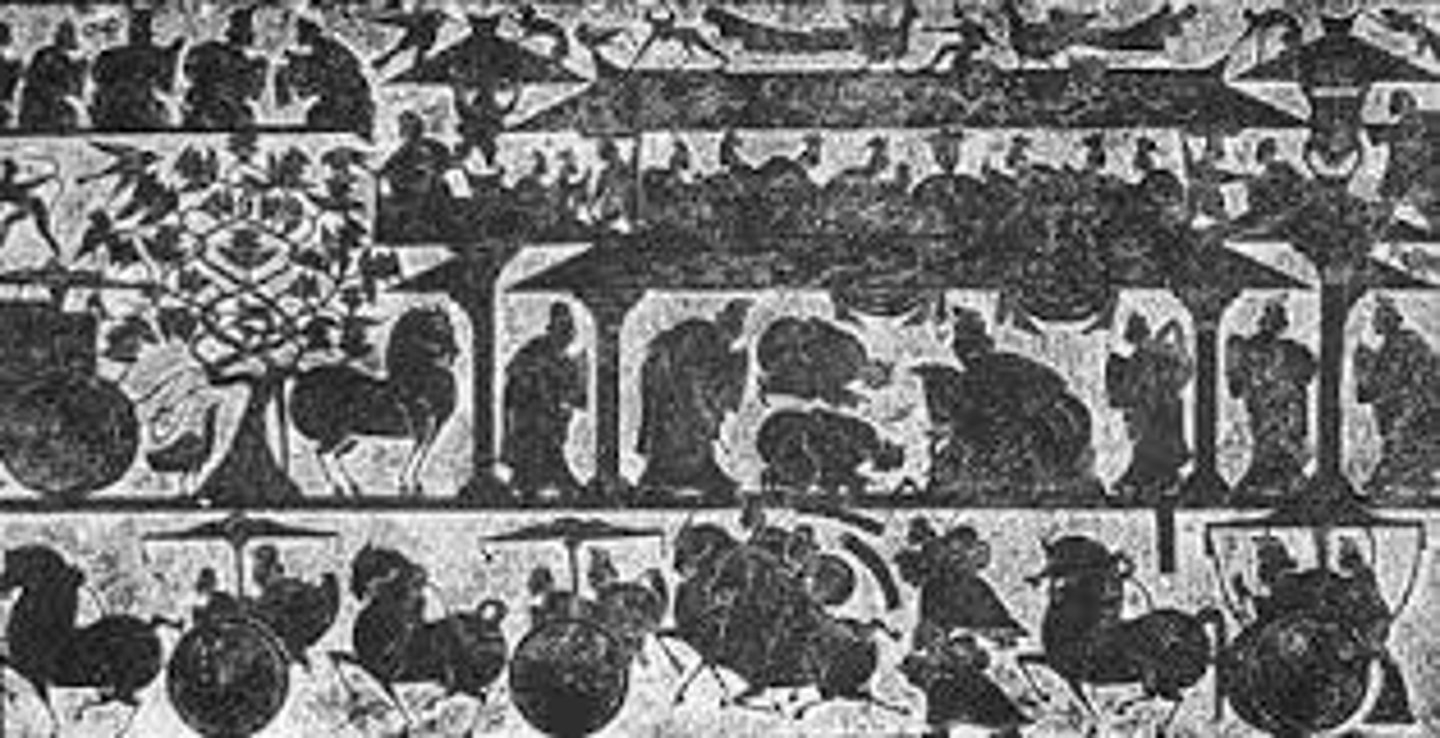
Title: The Archer Yi, The Fushan Tree, and Reception in a Mansion
Material: Rubbing of Stone Relief
@ Wu Family Shrines, Jiaxiang, Shangdong Province
Period: Eastern Han Period
hierarchical scale highly prevalent with many figures bowing to Queen Mother of the West
Creator of the universe in the center facing towards us and wears a headress

Title: The Archer Yi, The Fushan Tree, and Reception in a Mansion
Material: Rubbing of Stone Relief
@ Wu Family Shrines, Jiaxiang, Shangdong Province
Period: Eastern Han Period
also depicts legend of hero shooting down the ten suns (saving Chinese people from drought)
- Two separate scenes: a procession of chariots below, political homage above on the right, ancient legend enacted around tree on the left (tree is stylized, natural leaf forms decorative pattern, trunk bent in Zhou hook)
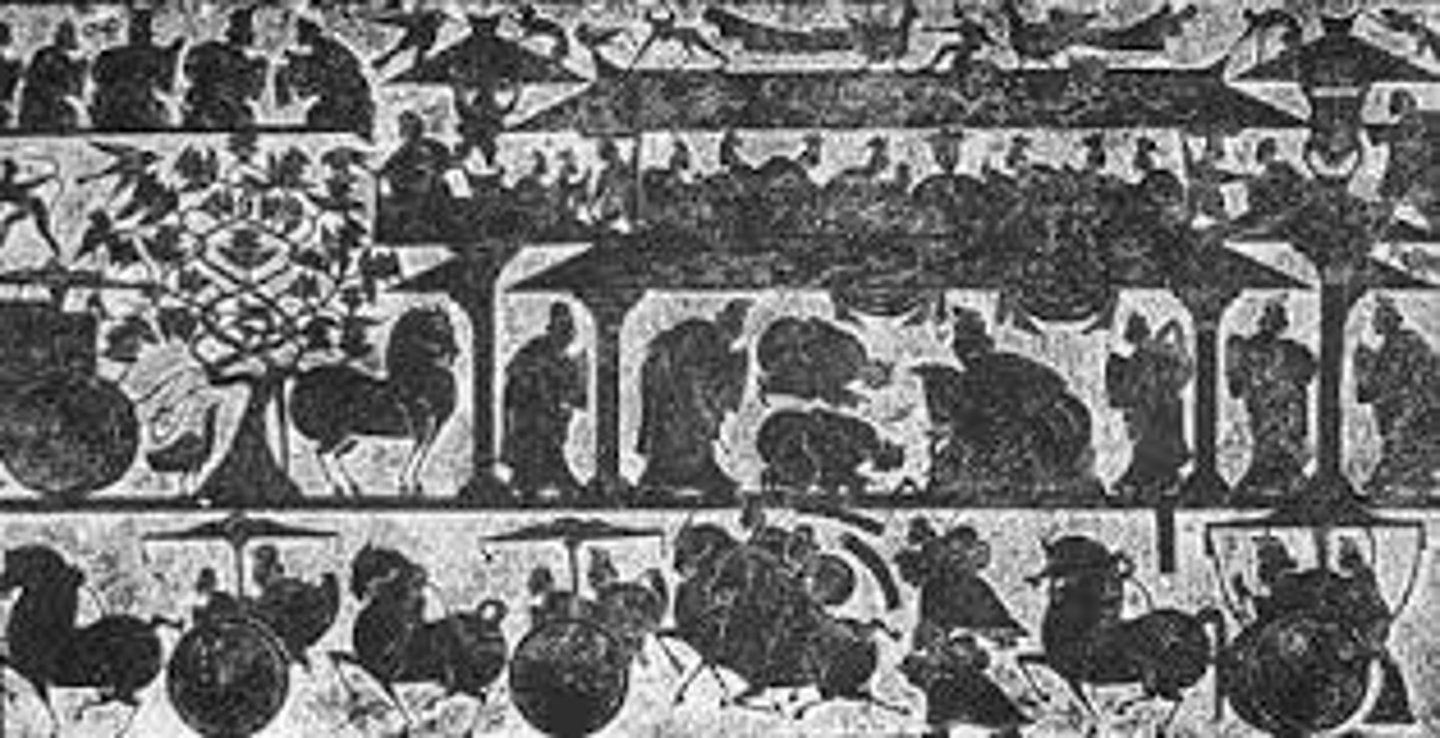
Title: The Archer Yi, The Fushan Tree, and Reception in a Mansion
Material: Rubbing of Stone Relief
@ Wu Family Shrines, Jiaxiang, Shangdong Province
Period: Eastern Han Period
the building structures are multiple floor towers that are increasing in popularity in China during this period
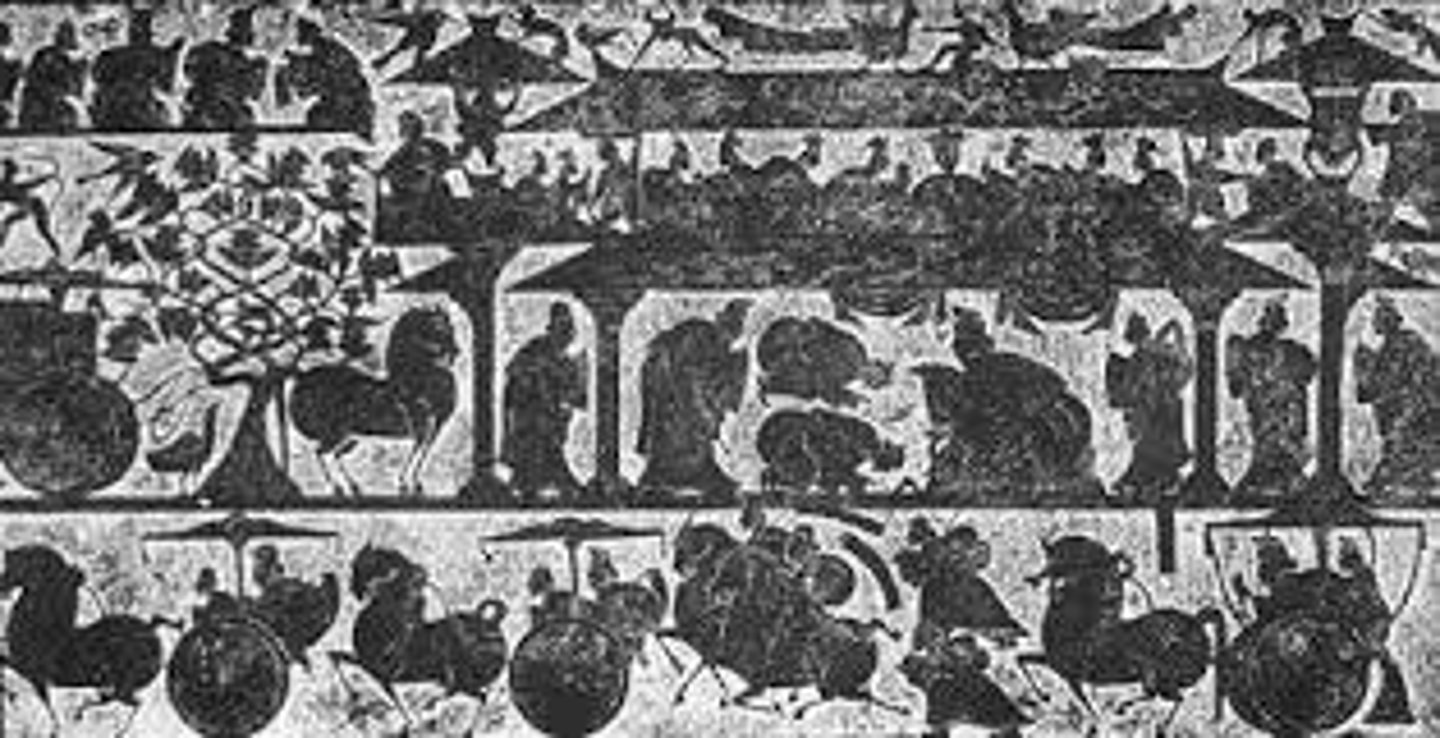
Title: The Archer Yi, The Fushan Tree, and Reception in a Mansion
Material: Rubbing of Stone Relief
@ Wu Family Shrines, Jiaxiang, Shangdong Province
Period: Eastern Han Period
- Confucian art (Confucius and Laozi at the top left), respect to the emperor/Queen Mother
- Combination of myths/legends/history
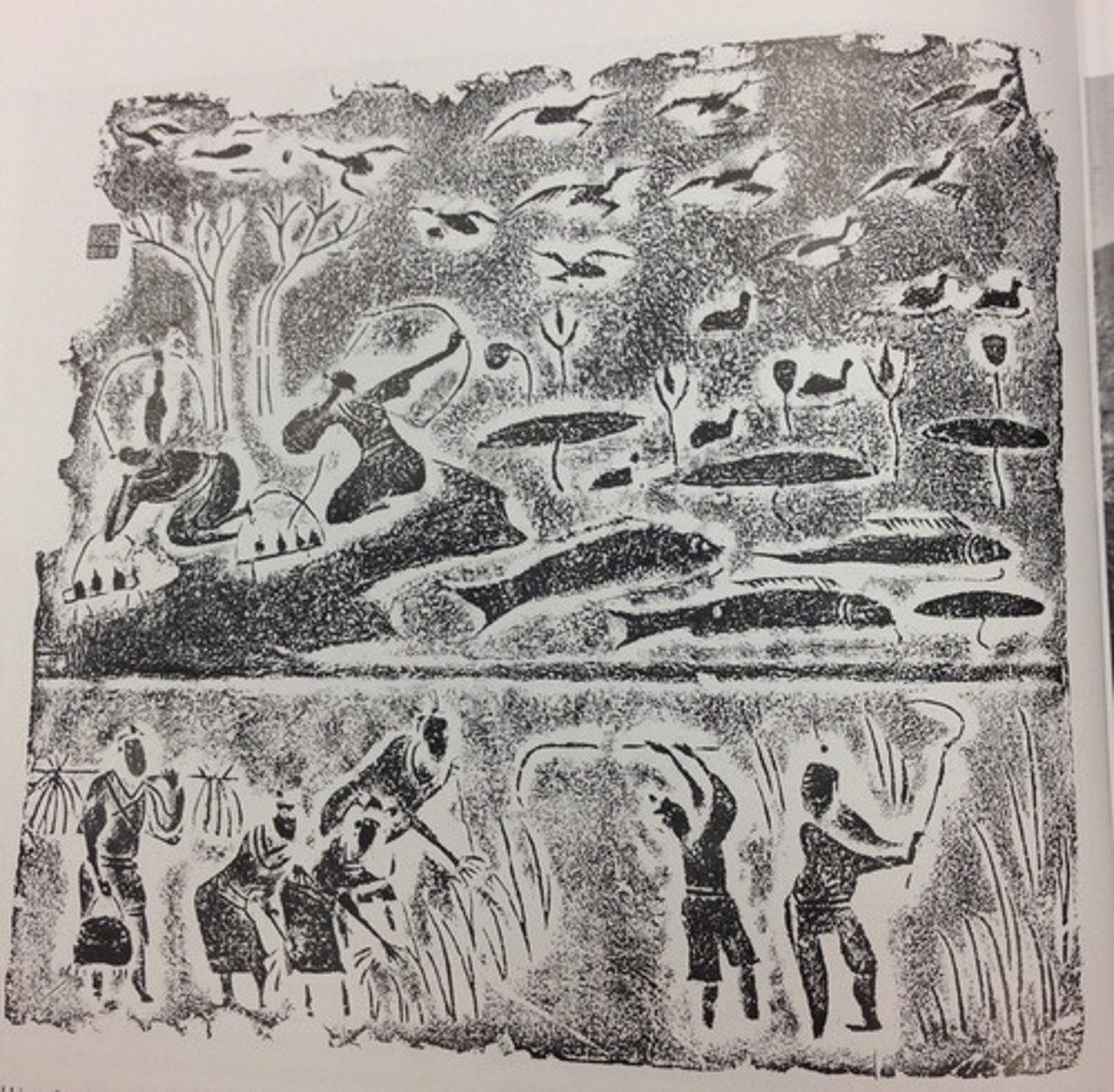
Title: Scenes of Hunting and Harvesting
Material: Rubbing of Earthenware Tile
@ Chengdu, Sichuan Province
Period: Eastern Han Period
scenes of normal people in daily life

Title: Scenes of Hunting and Harvesting
Material: Rubbing of Earthenware Tile
@ Chengdu, Sichuan Province
Period: Eastern Han Period
- Diagonal composition shows attempt at creating depth/space
use of diagonal lines to create some sense of perspective in otherwise flat composition

Title: Scenes of Hunting and Harvesting
Material: Rubbing of Earthenware Tile
@ Chengdu, Sichuan Province
Period: Eastern Han Period
- Stream of animals in the distance while hunters shoot at flying ducks; below are men harvesting grain while one brings lunch
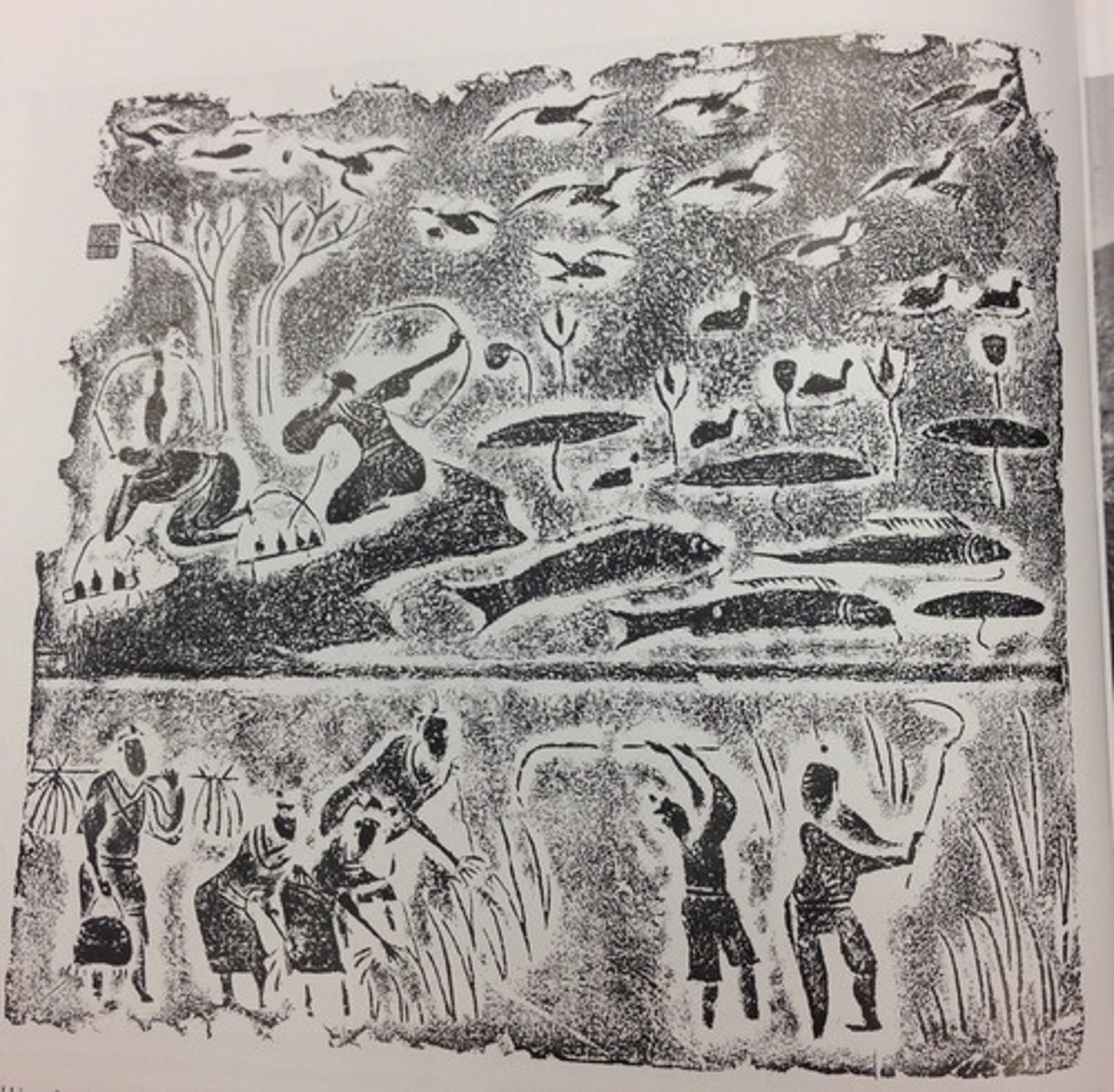
Title: Scenes of Hunting and Harvesting
Material: Rubbing of Earthenware Tile
@ Chengdu, Sichuan Province
Period: Eastern Han Period
- Depiction is lively and natural in contrast to the static style of previous stone rubbings
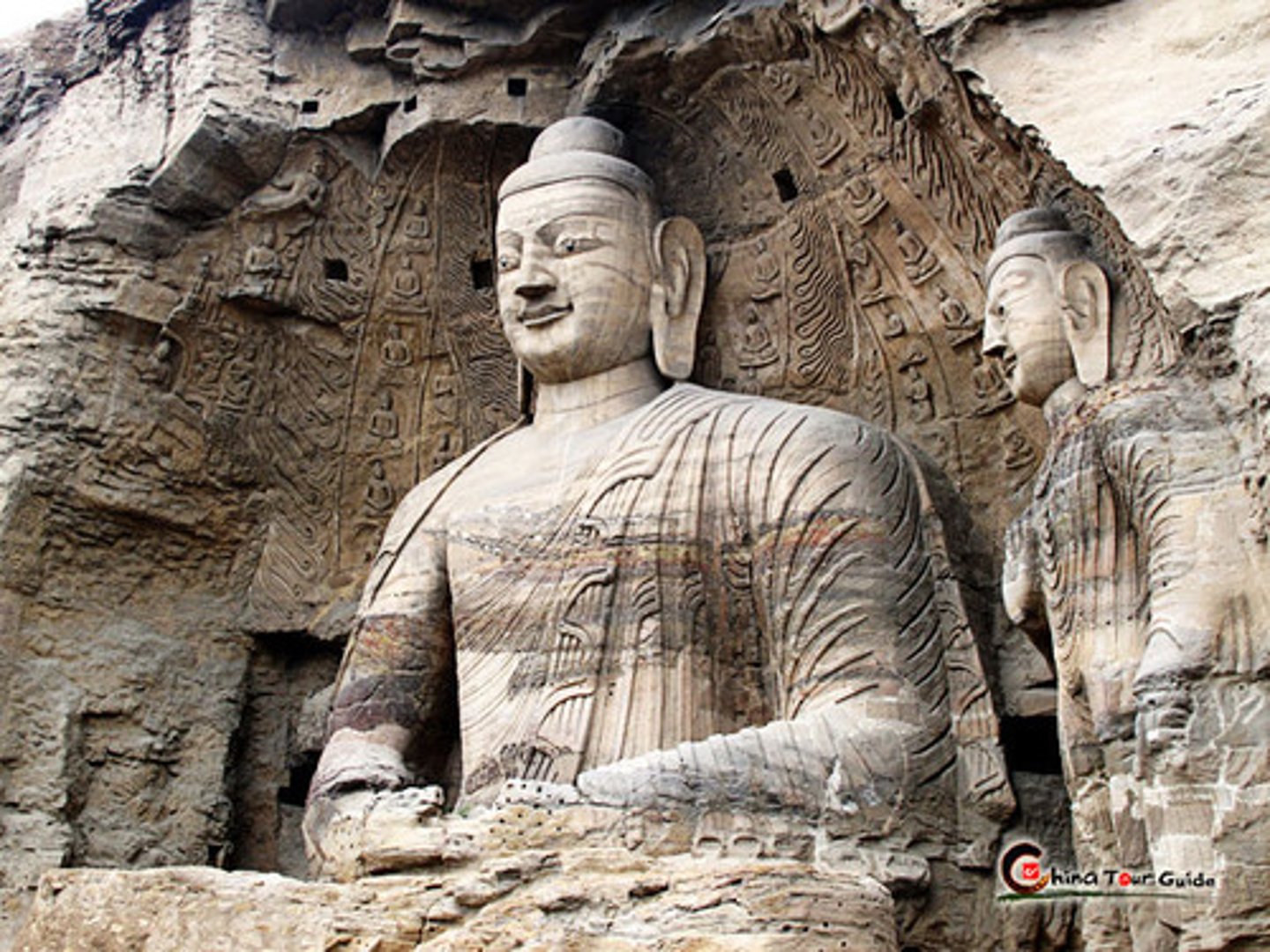
Title: Colossal Buddha
Material: Sandstone
@ Cave 20, Yungang Caves, Datong, Shangxi Province
Period: Northern Wei Period (ca. 460-465 AD)
typical Gupta style depiction shows time of movement of early Buddhism into China
- International Gupta Style; faces show traces of early Indian art (archaic smile, straight nose); impression of hybrid and stiff conformation
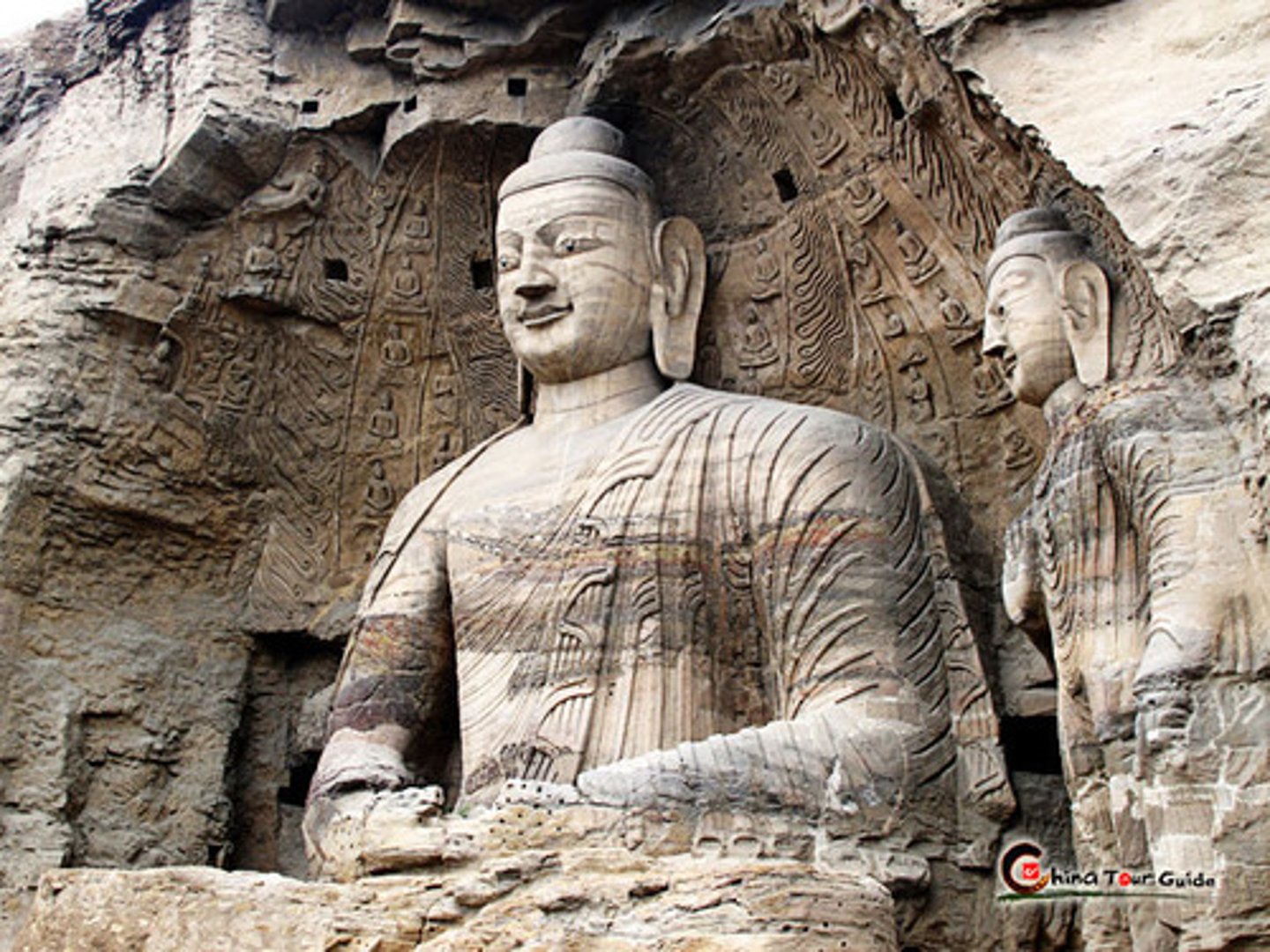
Title: Colossal Buddha
Material: Sandstone
@ Cave 20, Yungang Caves, Datong, Shangxi Province
Period: Northern Wei Period (ca. 460-465 AD)
artists working with two-dimensional images of Buddha from India shown clearly through disconnect between the decorative lines of the front and back of the statue

Title: Colossal Buddha
Material: Sandstone
@ Cave 20, Yungang Caves, Datong, Shangxi Province
Period: Northern Wei Period (ca. 460-465 AD)
holes in stone wall behind Buddha were for wooden architecture erected around carvings
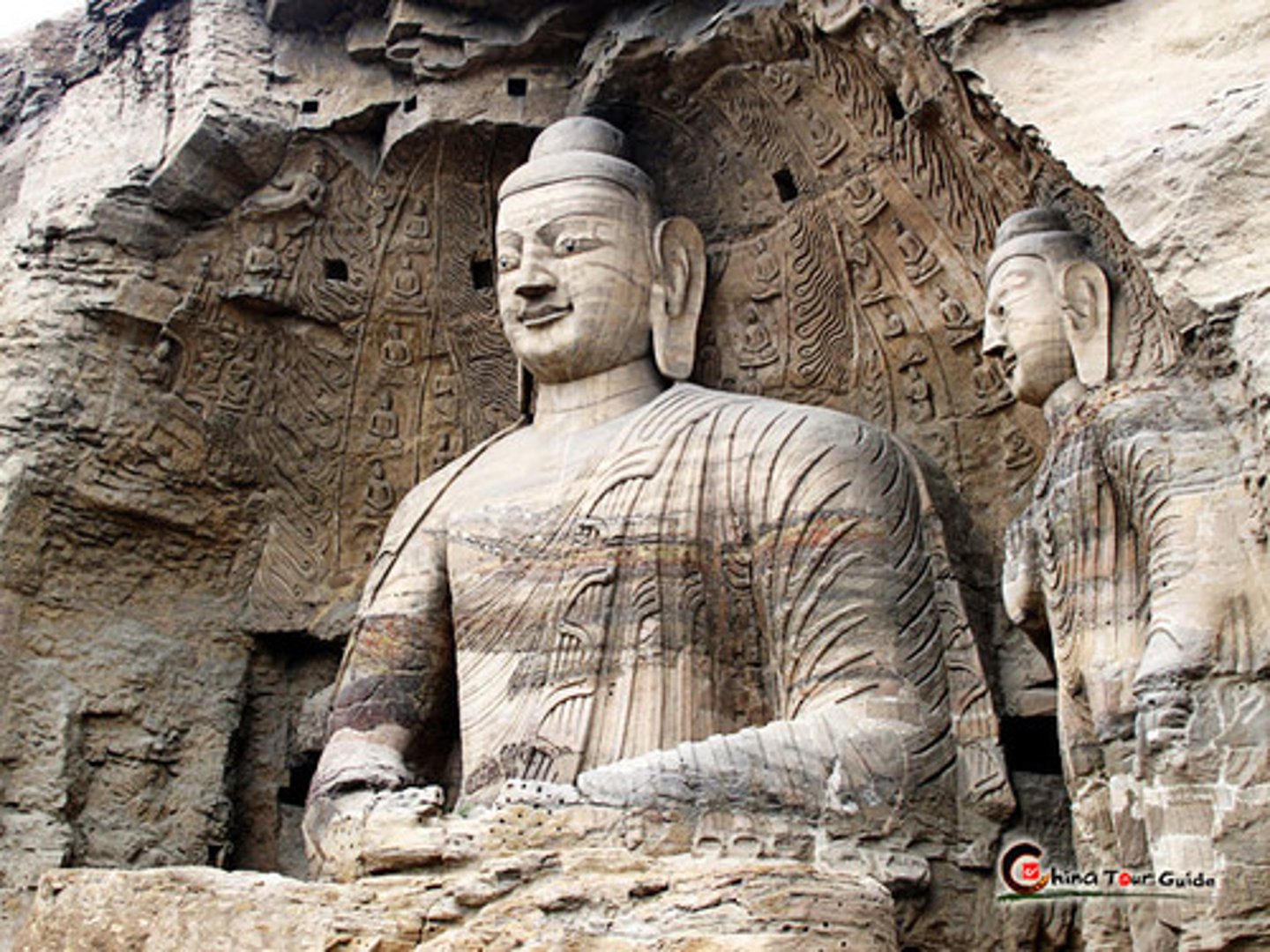
Title: Colossal Buddha
Material: Sandstone
@ Cave 20, Yungang Caves, Datong, Shangxi Province
Period: Northern Wei Period (ca. 460-465 AD)
China takes Mahayana and Tatriyana forms of Buddhism as evidenced by multiple Buddhas in halo of the Shakyamuni
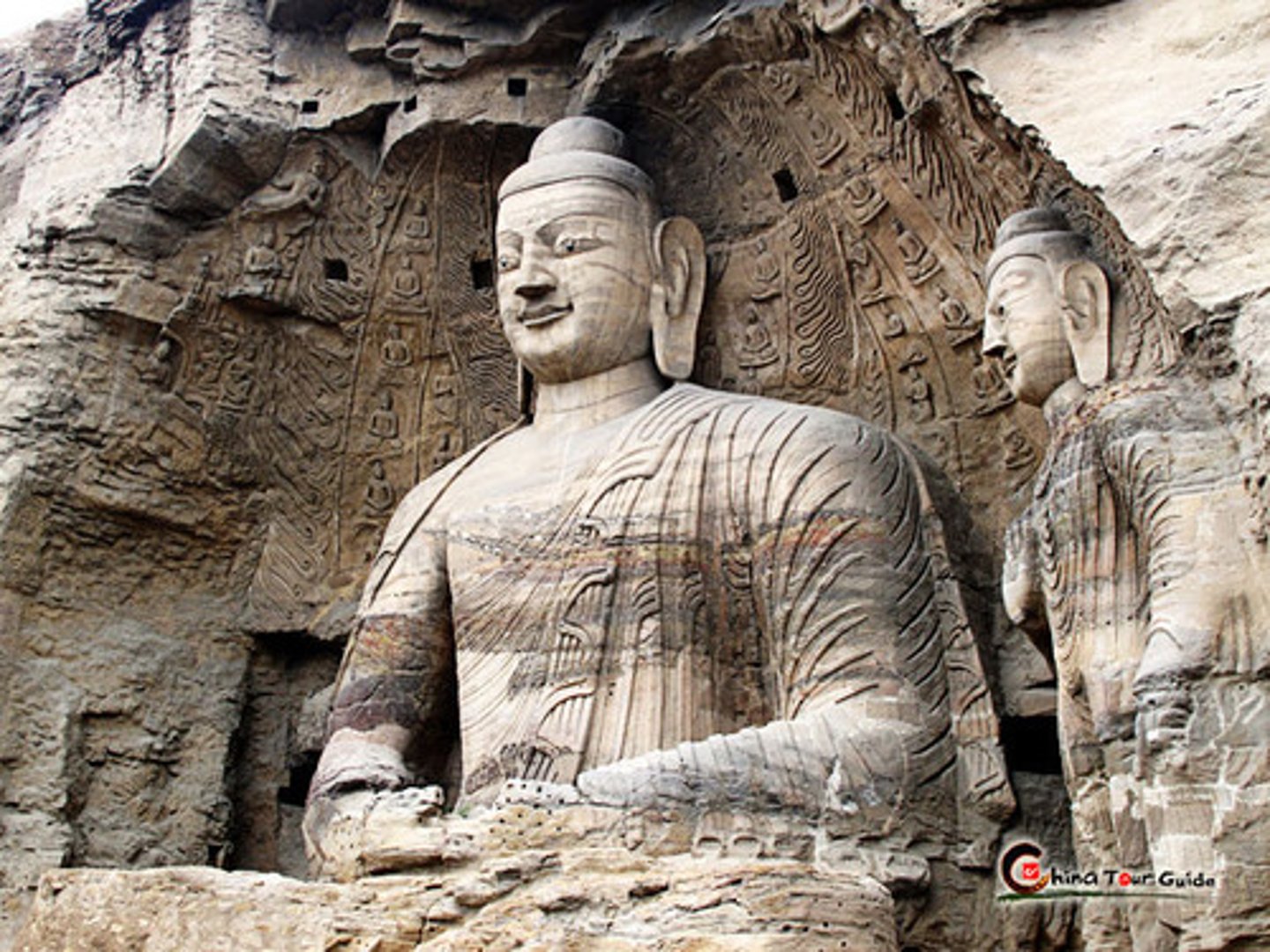
Title: Colossal Buddha
Material: Sandstone
@ Cave 20, Yungang Caves, Datong, Shangxi Province
Period: Northern Wei Period (ca. 460-465 AD)
- Drapery derived from Bamiyan string patterns

Title: Colossal Buddha
Material: Sandstone
@ Cave 20, Yungang Caves, Datong, Shangxi Province
Period: Northern Wei Period (ca. 460-465 AD)
- Flanked by bodhisattva
- Iconography is the same as usual.
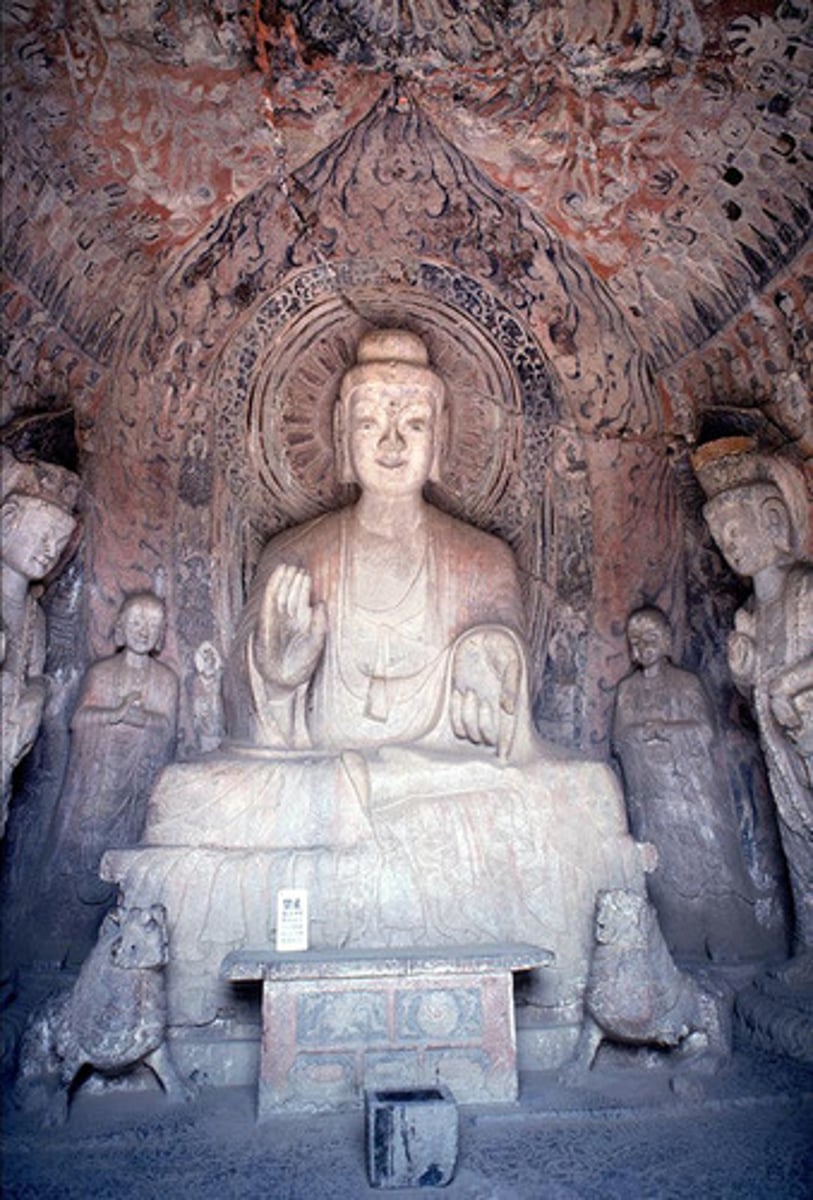
Title: Seated Buddha with Attendants
Material: Limestone
@ Middle Cave of Binyang, Longmen Caves, Luoyang, Henan Province
Period: Northern Wei Period (ca. 523 AD)
more rectangular face, longer neck, narrow shoulders, open eyes
- Highly localized (Chinese features); face is longer and smooth, rounder nose
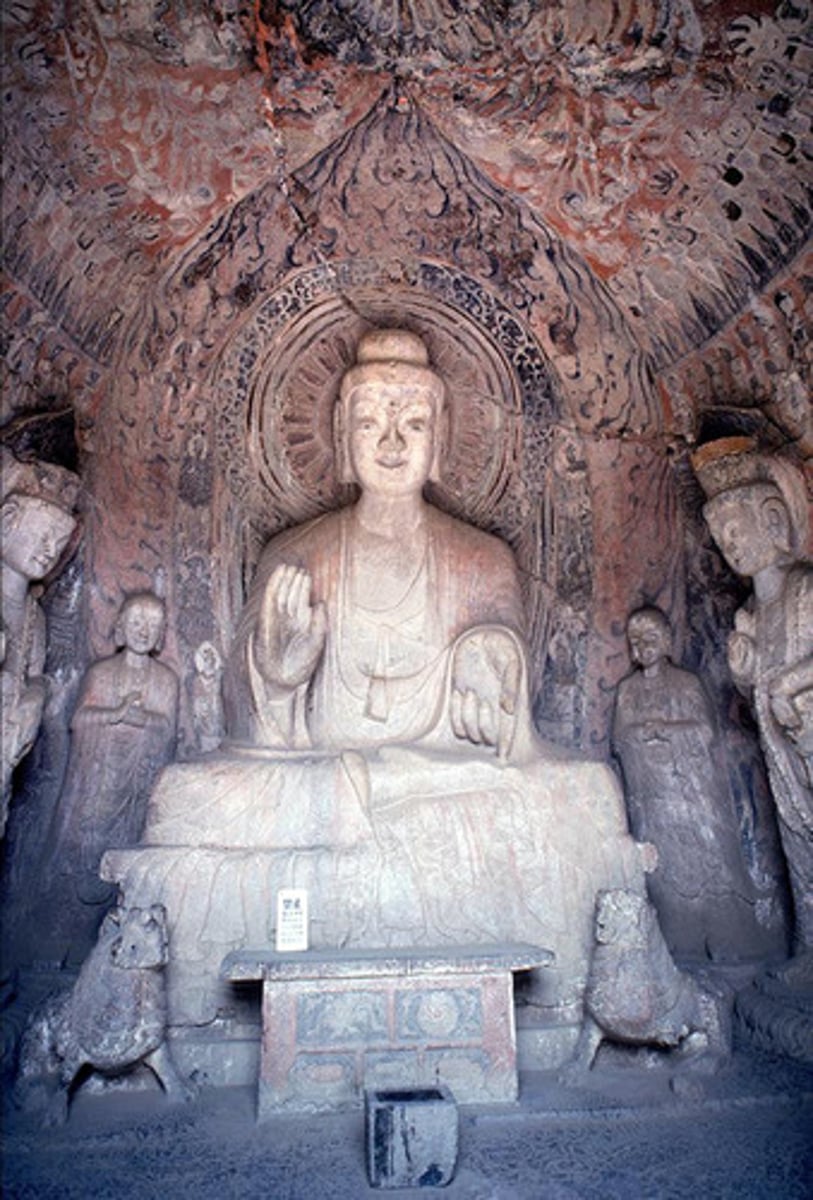
Title: Seated Buddha with Attendants
Material: Limestone
@ Middle Cave of Binyang, Longmen Caves, Luoyang, Henan Province
Period: Northern Wei Period (ca. 523 AD)
clothing also changed to more Chinese style with multiple layers and large sleeves
- Multiple layers of robe
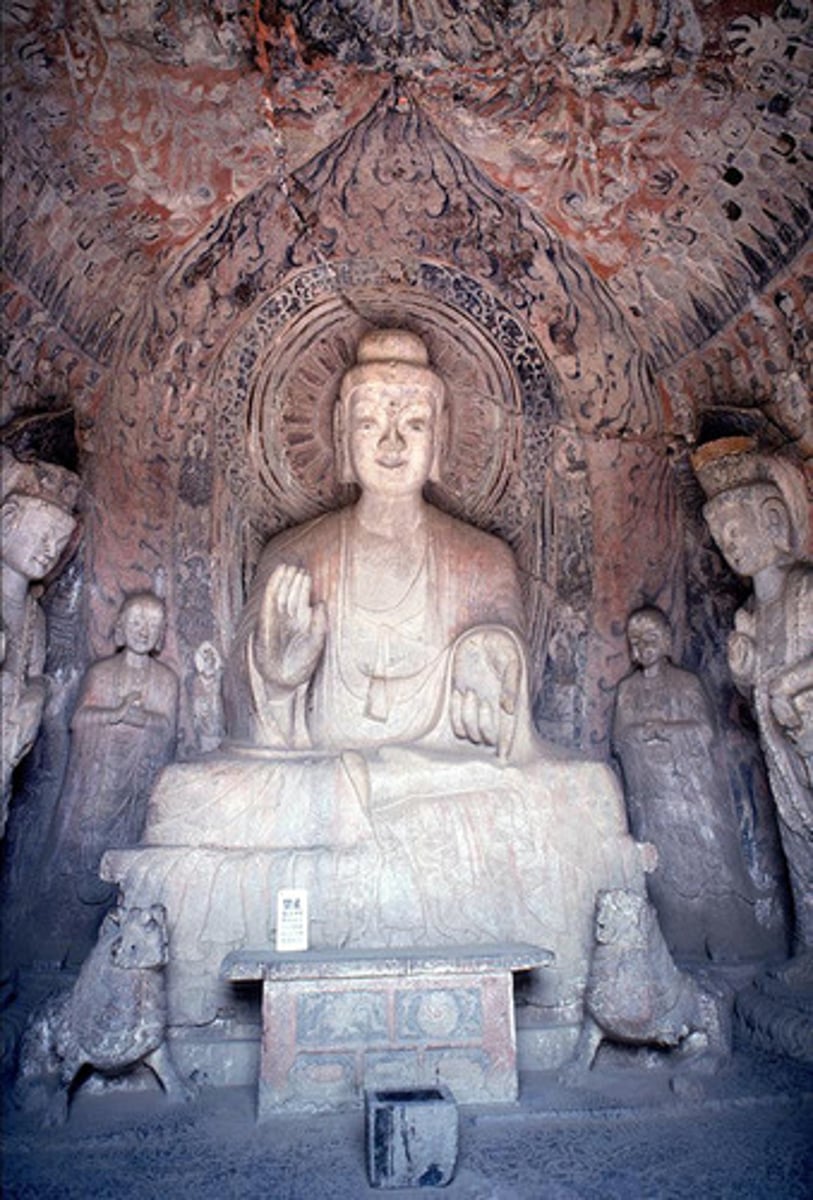
Title: Seated Buddha with Attendants
Material: Limestone
@ Middle Cave of Binyang, Longmen Caves, Luoyang, Henan Province
Period: Northern Wei Period (ca. 523 AD)
two monks flanking Buddha are historical figures key to early spread of Buddhism in China
strict use of hierarchical scale
- Buddhist triad has two Chinese monks rather than traditional bodhisattva (no crown or luxury)
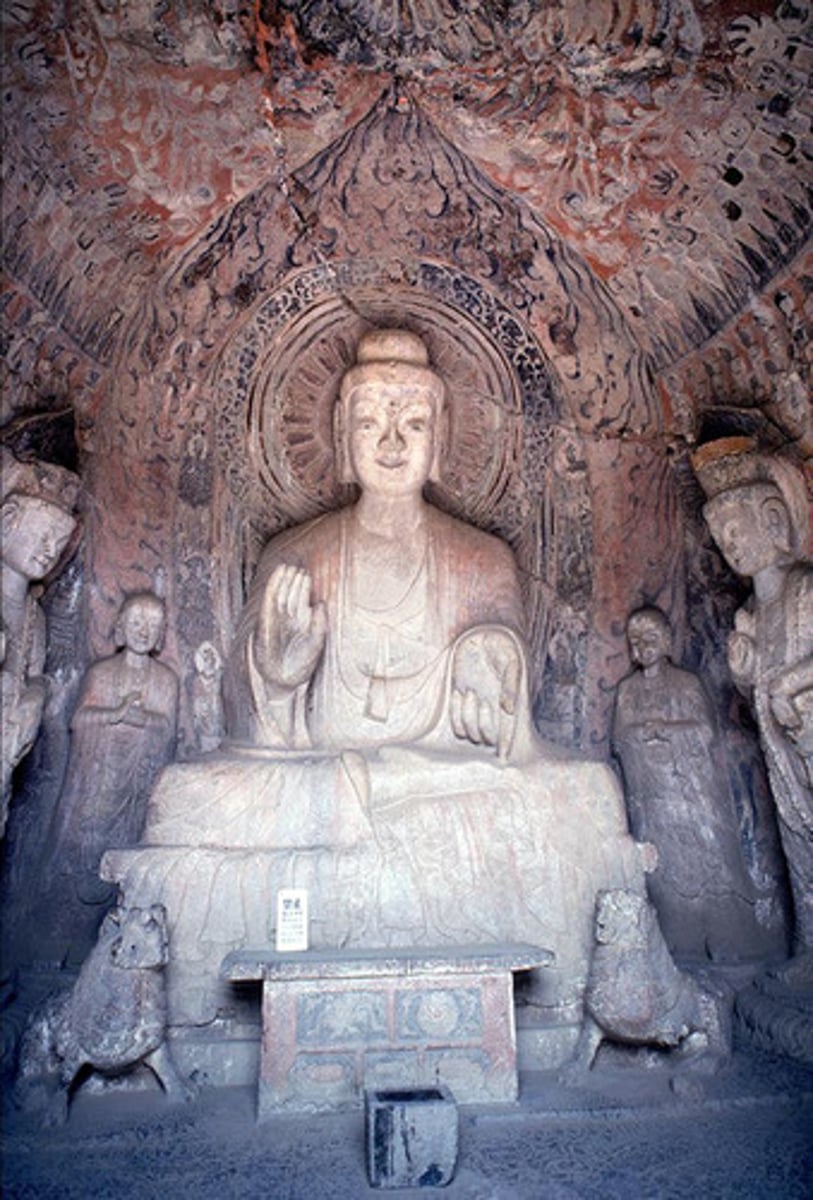
Title: Seated Buddha with Attendants
Material: Limestone
@ Middle Cave of Binyang, Longmen Caves, Luoyang, Henan Province
Period: Northern Wei Period (ca. 523 AD)
- Northern Wei style
- Elongated Style
elongated style shows central Chinese influence
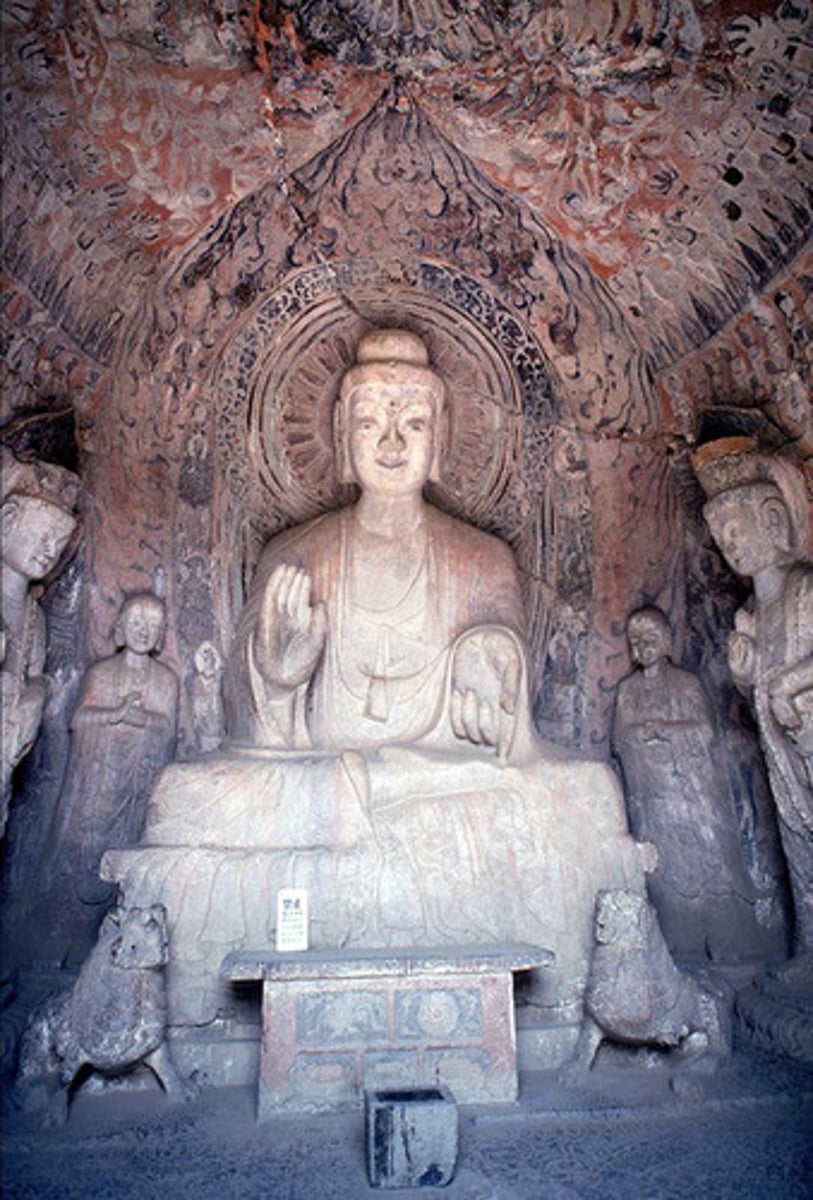
Title: Seated Buddha with Attendants
Material: Limestone
@ Middle Cave of Binyang, Longmen Caves, Luoyang, Henan Province
Period: Northern Wei Period (ca. 523 AD)
Basic Iconography of Buddha
hand gesture(mudra)
yogi position
and hairstyles

Title: Seated Buddha with Attendants
Material: Limestone
@ Middle Cave of Binyang, Longmen Caves, Luoyang, Henan Province
Period: Northern Wei Period (ca. 523 AD)
2 lions in the front
2 major aspects
wisdom → left
compassion → right
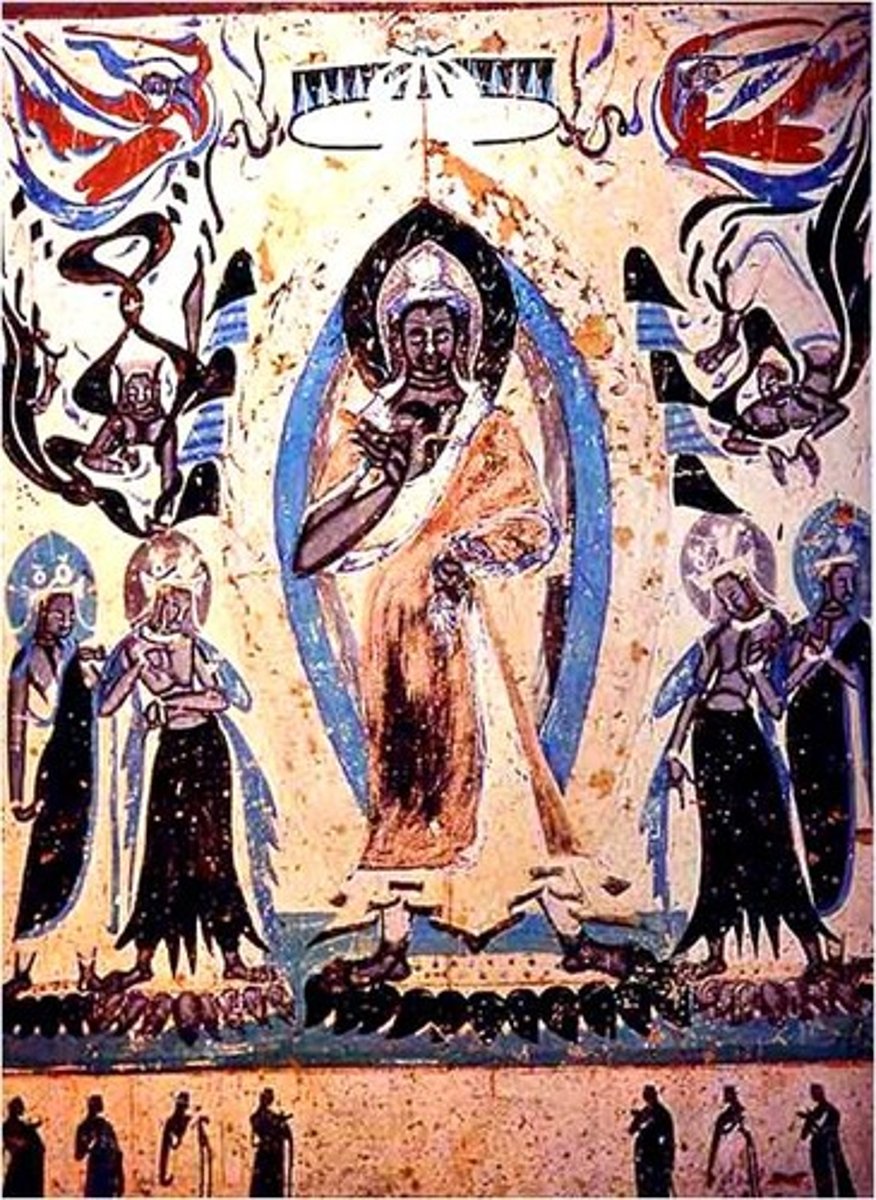
Title: Preaching Buddha
Material: Wall Painting
@ Cave 249, Mogao Caves, Dunhuang, Gansu Province
Period: Northern Wei Period (5th Cent.)
twisted, elongated bodies and legs apart stance show influence of central Asia region (Afghanistan), from which Buddhism traveled into China
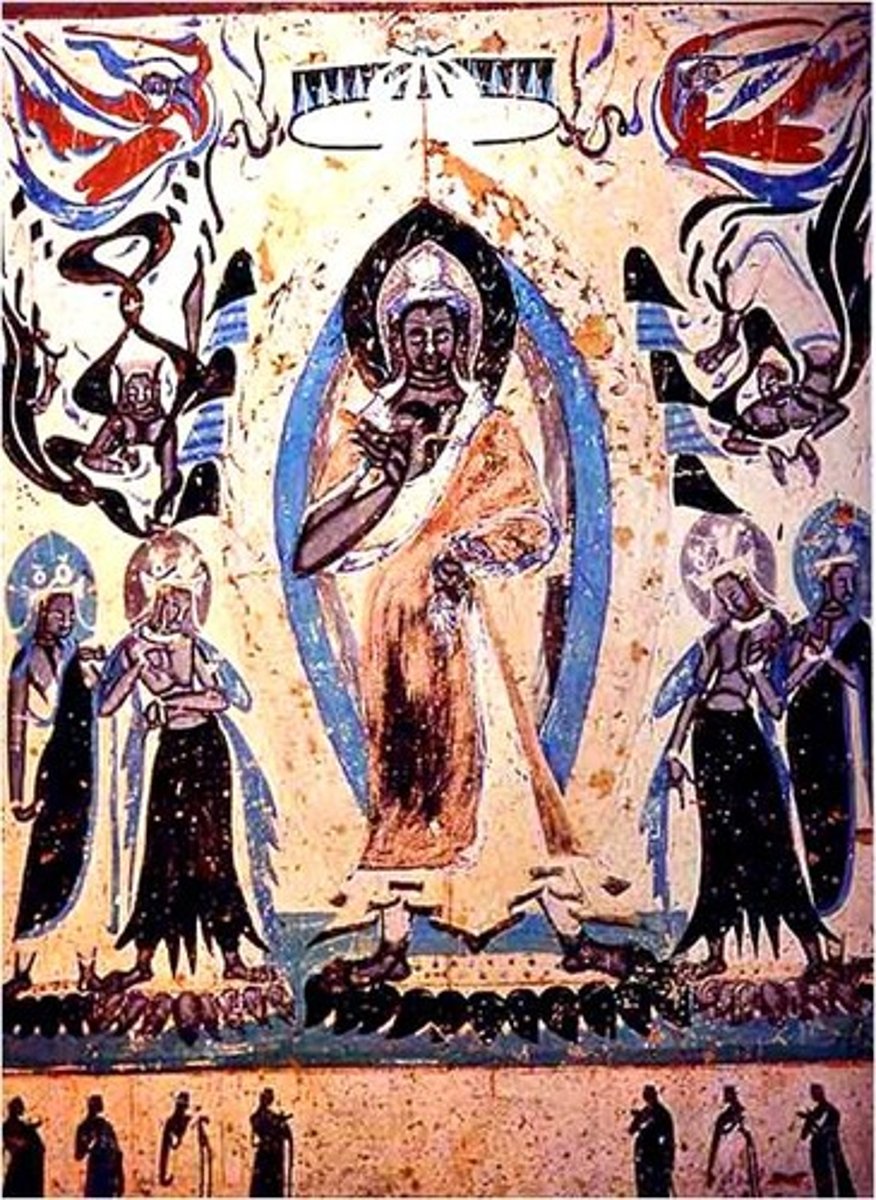
Title: Preaching Buddha
Material: Wall Painting
@ Cave 249, Mogao Caves, Dunhuang, Gansu Province
Period: Northern Wei Period (5th Cent.)
iconography - retains traditional composition of Buddha flanked by Boddhisatvas
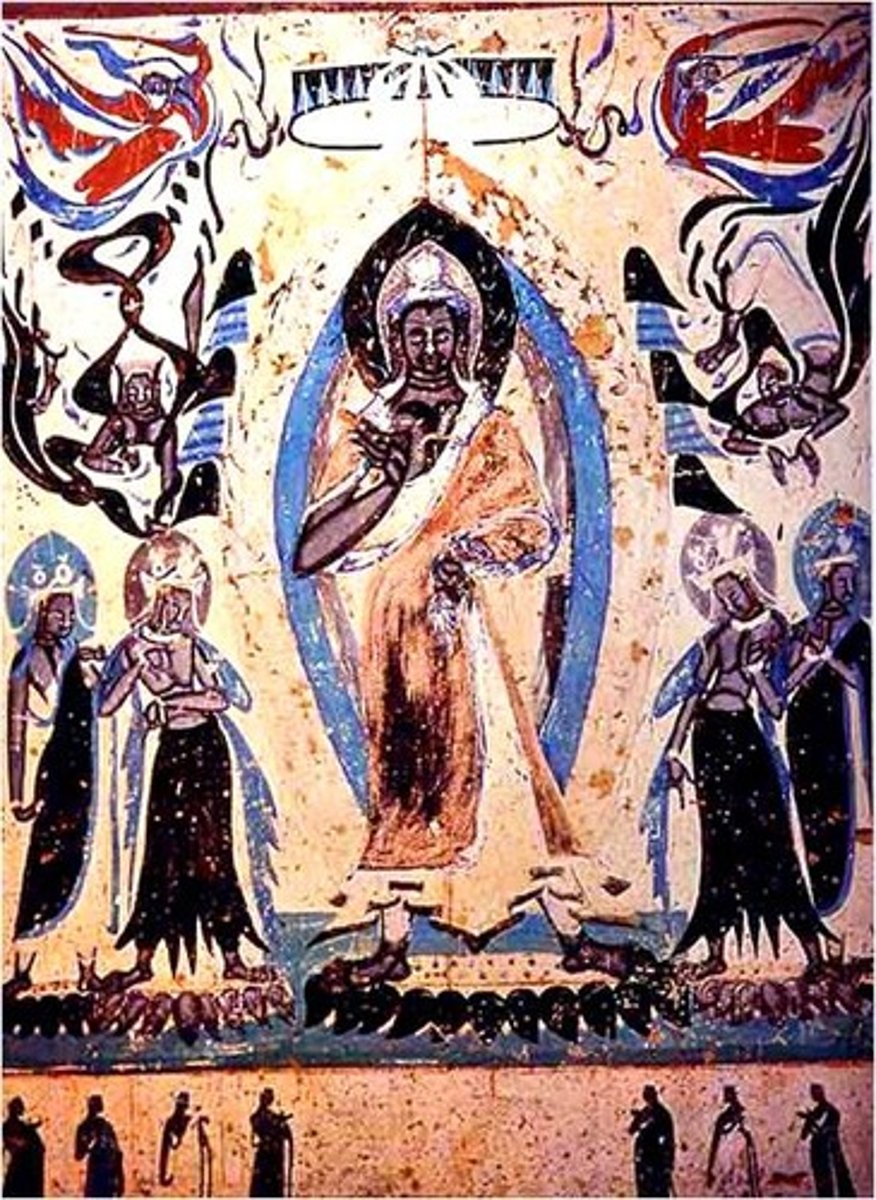
Title: Preaching Buddha
Material: Wall Painting
@ Cave 249, Mogao Caves, Dunhuang, Gansu Province
Period: Northern Wei Period (5th Cent.)
- More archaic, almost caricature-like
- Stiff poses reflect the same attitudes as Chinese sculpture, although now in a flat, decorative pattern
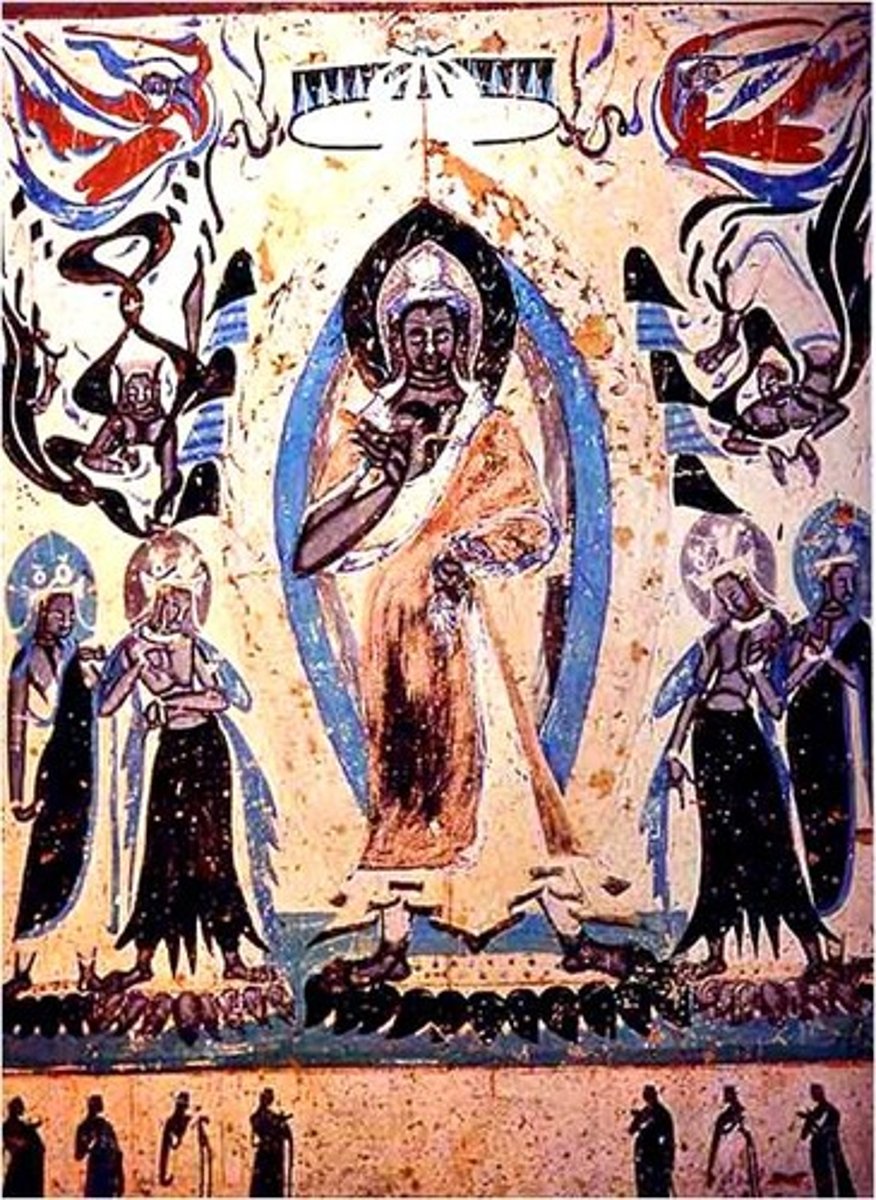
Title: Preaching Buddha
Material: Wall Painting
@ Cave 249, Mogao Caves, Dunhuang, Gansu Province
Period: Northern Wei Period (5th Cent.)
- Highly energetic, dark streaks outlining the edges of the figures and the shapes within them

Title: Preaching Buddha
Material: Wall Painting
@ Cave 249, Mogao Caves, Dunhuang, Gansu Province
Period: Northern Wei Period (5th Cent.)
- Discrepancy between the old tradition and new stimulus
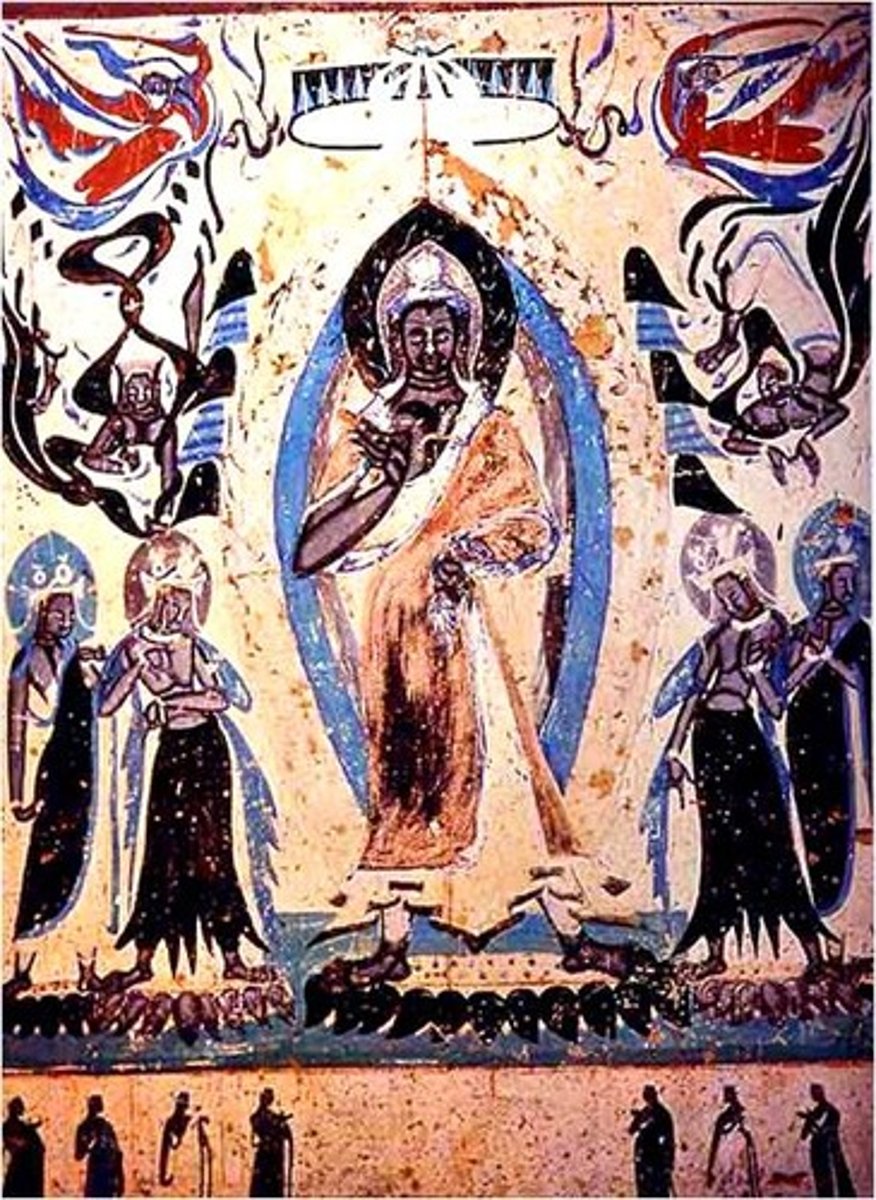
Title: Preaching Buddha
Material: Wall Painting
@ Cave 249, Mogao Caves, Dunhuang, Gansu Province
Period: Northern Wei Period (5th Cent.)
top left&right - entertainers
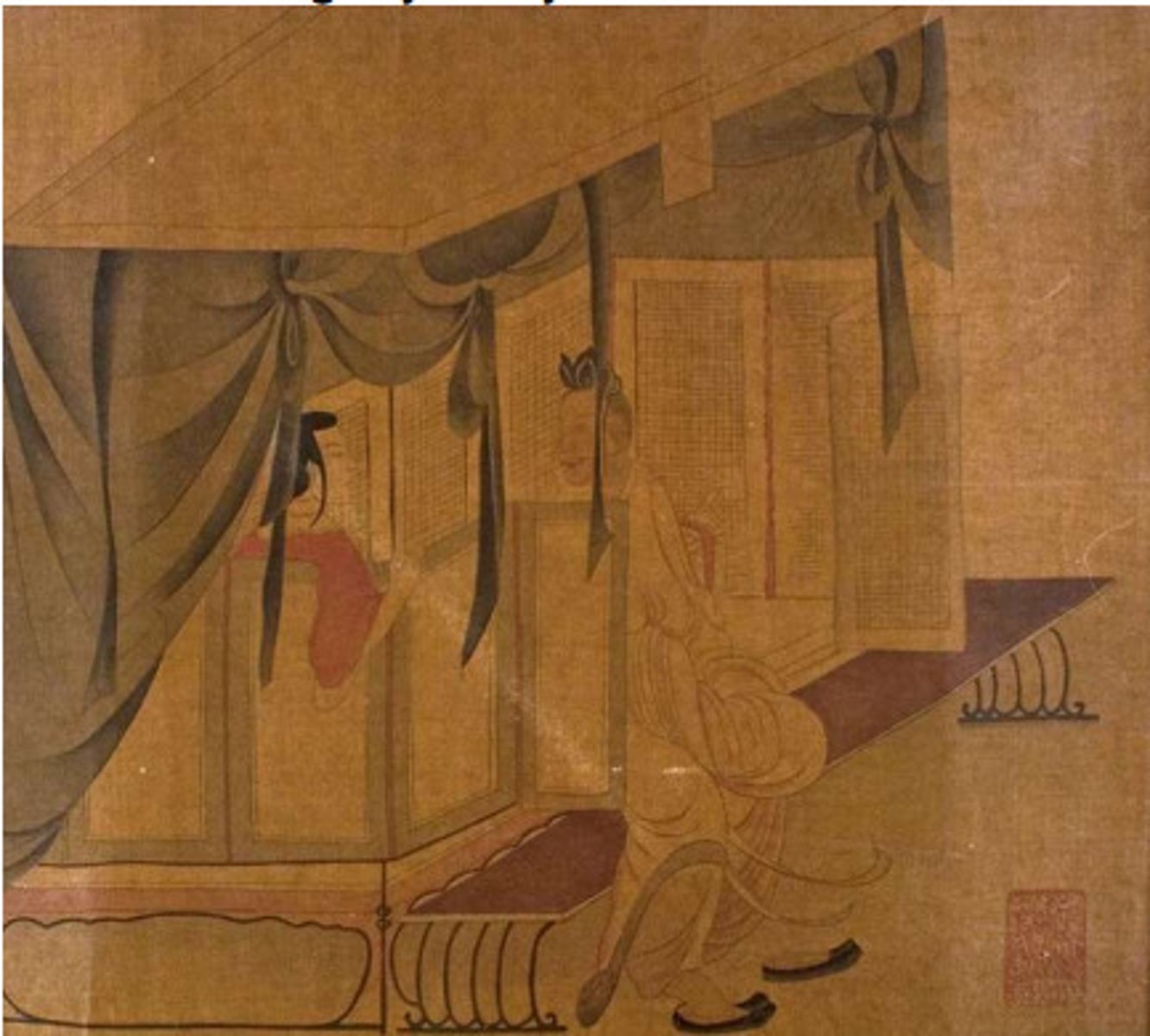
Title: Admonitions of the Instructress to the Court Ladies
Artist: attributed to Gu Kaizhi
Material: handscroll, ink and colors on silk
Period: Six Dynasties Period
reverse of vanishing-point perspective
wider towards the back and narrower in front
- Minimalistic, only what is necessary for the story
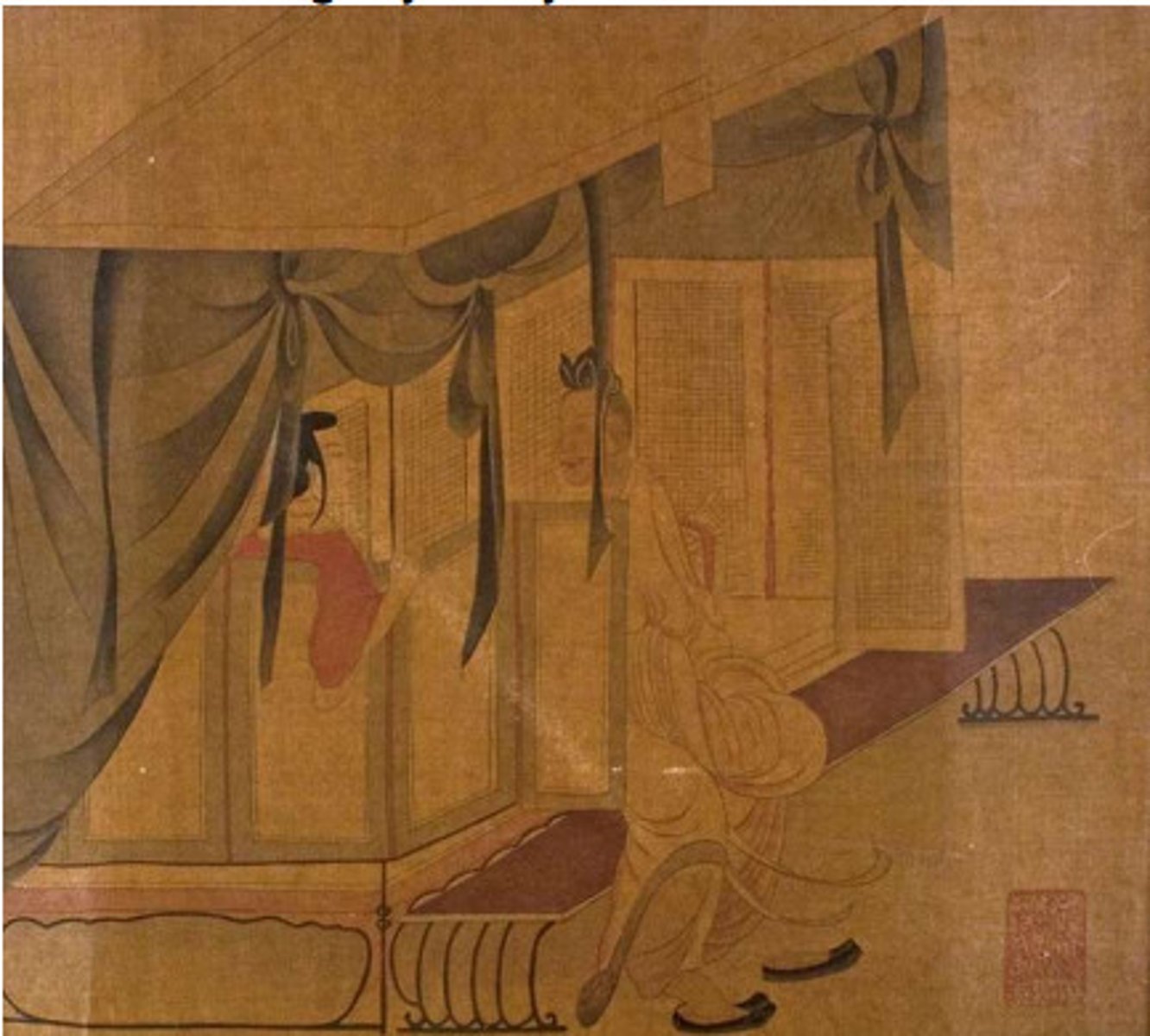
Title: Admonitions of the Instructress to the Court Ladies
Artist: attributed to Gu Kaizhi
Material: handscroll, ink and colors on silk
Period: Six Dynasties Period
shading of curtains to add depth shows influence of Gupta style painting
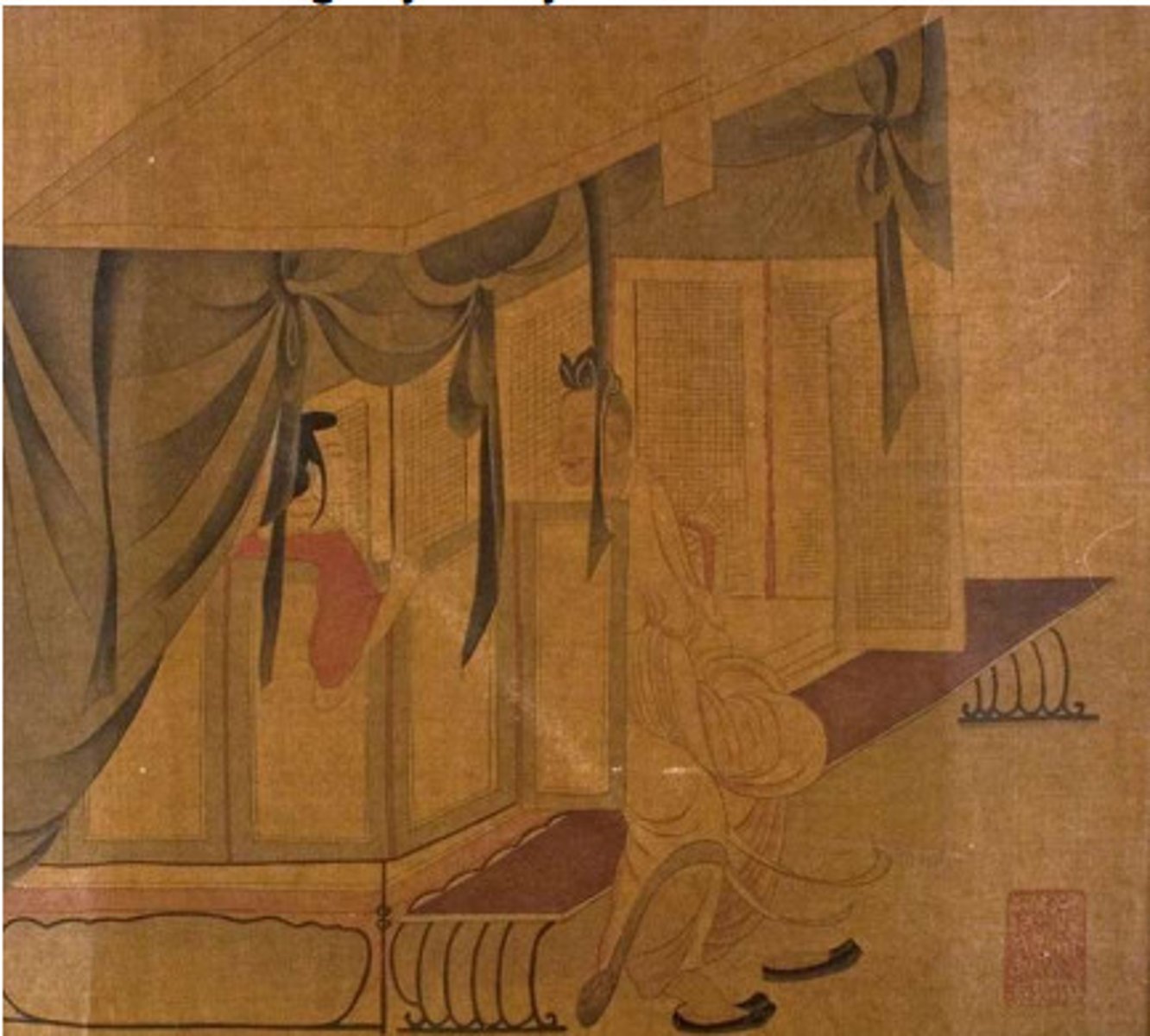
Title: Admonitions of the Instructress to the Court Ladies
Artist: attributed to Gu Kaizhi
Material: handscroll, ink and colors on silk
Period: Six Dynasties Period
Confucian teaching - women should not be involved in public and government affairs; even trusted and close concubine of emperor does not disclose private information
Iconographically Confucian
- Archaic quality in disposition
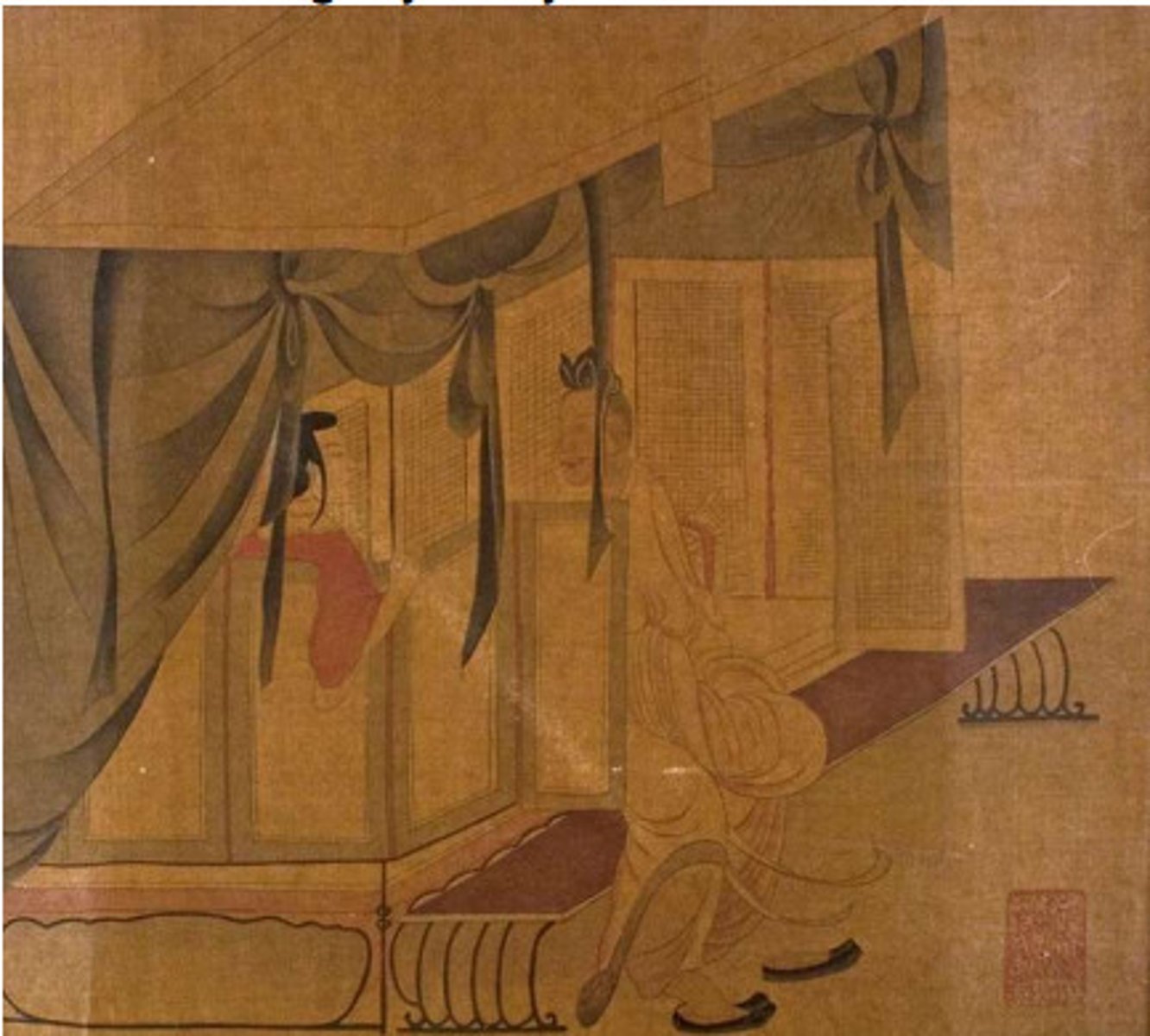
Title: Admonitions of the Instructress to the Court Ladies
Artist: attributed to Gu Kaizhi
Material: handscroll, ink and colors on silk
Period: Six Dynasties Period
scrolls read from right to left and top to bottom with inscriptions explaining message at beginning of each 3-4 foot section; long scrolls only meant to be partially unrolled during viewing